

The Stunning Ritz Carlton EVRIMA Yacht
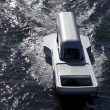
Gliding Across Tokyo’s Sumida River: The Mesmerizing Zipper Boat
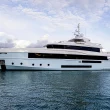
CROCUS Yacht: An 48 Meter Beauty by Admiral
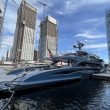
PHI Yacht – Royal Huisman’s $45 Million Superyacht
- Zuretti Interior Design
- Zuretti Interior
- Zuccon International Project
- Ziyad al Manaseer
- Zaniz Interiors. Kutayba Alghanim
- Yuriy Kosiuk
- Yuri Milner
- Yersin Yacht
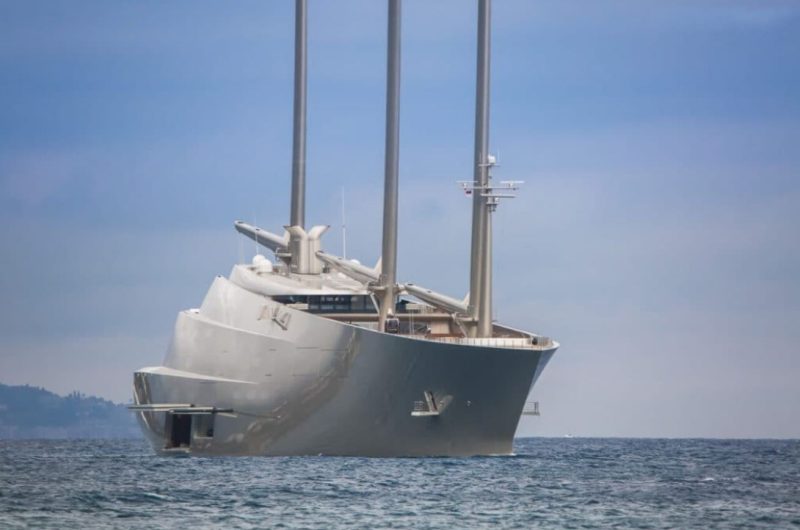
- Superyachts
SAILING YACHT A – World’s Biggest Sailing Yacht – $600 Million
SAILING YACHT A measures 143 meters making her the world’s biggest sailing yacht.
SAILING YACHT A is far more than a luxury vessel. She is a masterpiece of design and innovation combining sleek metal surfaces with futuristic naval architecture that took over two years to complete.
Launched in 2017, both the interior and exterior of this mega sailing yacht were designed by Phillippe Starck, who calls SAILING YACHT A one of his most high-profile projects.
The superyacht has taken on voyages all around the world and was most recently spotted sailing off the coasts of Gibraltar and Cyprus.
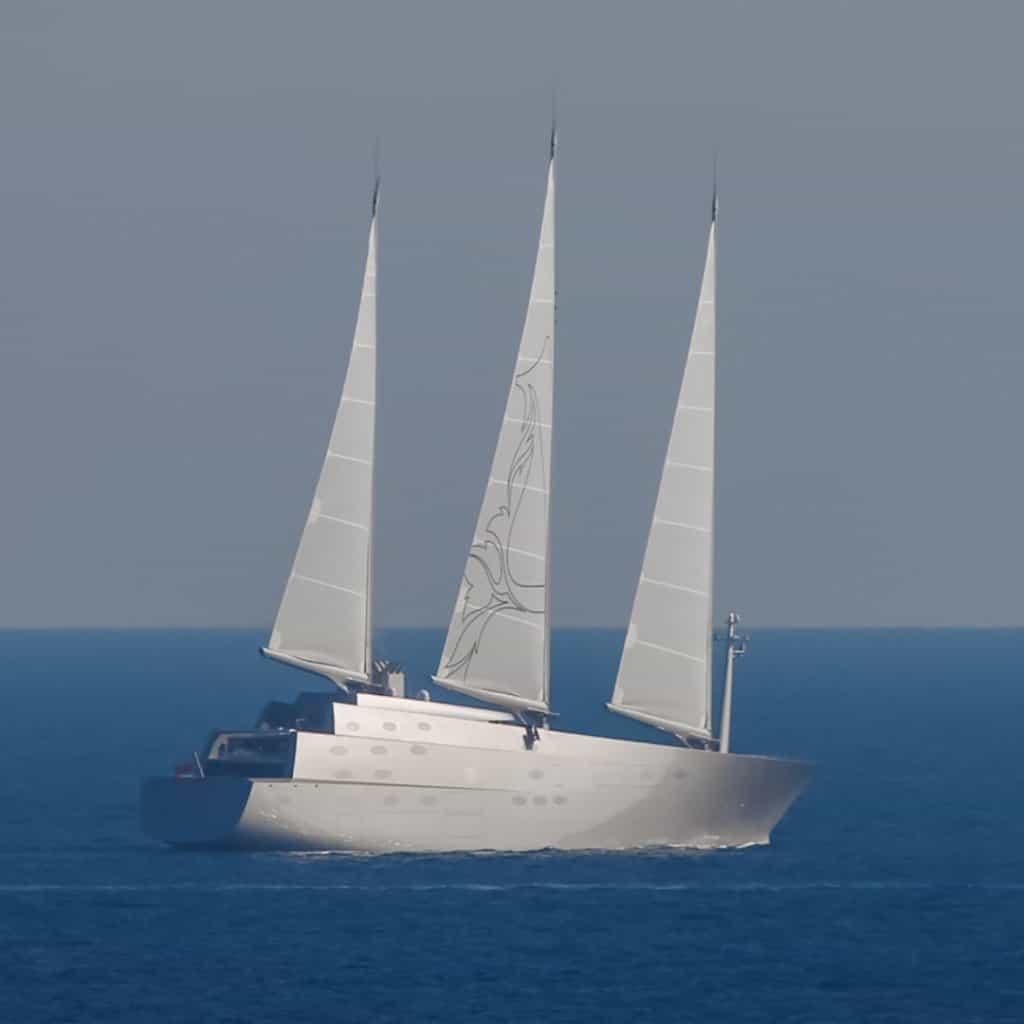
SAILING YACHT A interior
Both the interior and exterior of SAILING YACHT A were designed by Philippe Starck , a French architect known for his wide range of design projects.
He famously worked on the impressive MOTOR YACHT A, and the two iconic vessels share a lot of similarities in their layout and specifications.
Both yachts look incredibly futuristic and are sure to attract attention wherever they go.
While no exact details are known about the interior of SAILING YACHT A, it is rumored that she has an underwater observation pod with 30 cm (1 ft) thick glass located in the keel of the vessel.
This is one of the few parts where design mockups are publicly available, and the style of the interior can be examined.
The observation pod appears to have cream upholstery that stretches across the floor and ceiling of the cabin.
Two large symmetrical glass windows allow guests to view the breathtaking underwater world without even having to leave the yacht.
A third window is located at the bottom of the pod, which lets it feel like a true 360-degree experience and is almost comparable to a submarine.
A small floating side table provides guests with a space to place drinks or snacks in the pod and enjoy a one-of-a-kind dining experience in this unusual location.
Since the pod is located at the keel of the yacht, the large propellers are most likely visible from the windows suggesting it is most commonly used at anchor.
The superyacht has ten cabins that can accommodate 20 guests as well as a further 54 crew member.
Paparazzi photos and the work of yacht spotters provide a rare glimpse into the interior of SAILING YACHT A.
No official footage of cabins or salons has been released, although Starck’s past work suggests that the yacht would be furnished with opulent elements that perfectly combine luxury with style.
Silver and metal decorations play a large role and tie the interior design of the yacht together.
However, SAILING YACHT A was launched much later than her motorized companion suggesting her interior might be more modern with minimalistic elements rather than lavish furnishings.
Occasional photographs shot through open doors, and portholes show expensive art pieces decorating the interior of the yacht and rather absurd design choices like a set of chairs shaped like large human heads.
The yacht appears to feature a large, open salon with an elevated seating area and symmetrical arches on either side.
While details aren’t known to the public, it is rumored that SAILING YACHT A features a luxurious spa area, a sizable gym as well as an owner’s suite with several rooms that is only accessible via fingerprint.
The massive private area is said to feature a 60-inch television that disappears into the floor as well as a rotating bed.
Considering she is the largest sailing yacht in the world, it is surprising that SAILING YACHT A can only host 20 guests.
This suggests that there are spacious entertainment areas located on board, including several saloons and ample below-deck space for crew members.
Due to her large size and a small number of cabins, it is assumed that SAILING YACHT A can welcome a large number of day guests onboard for special events and celebrations.
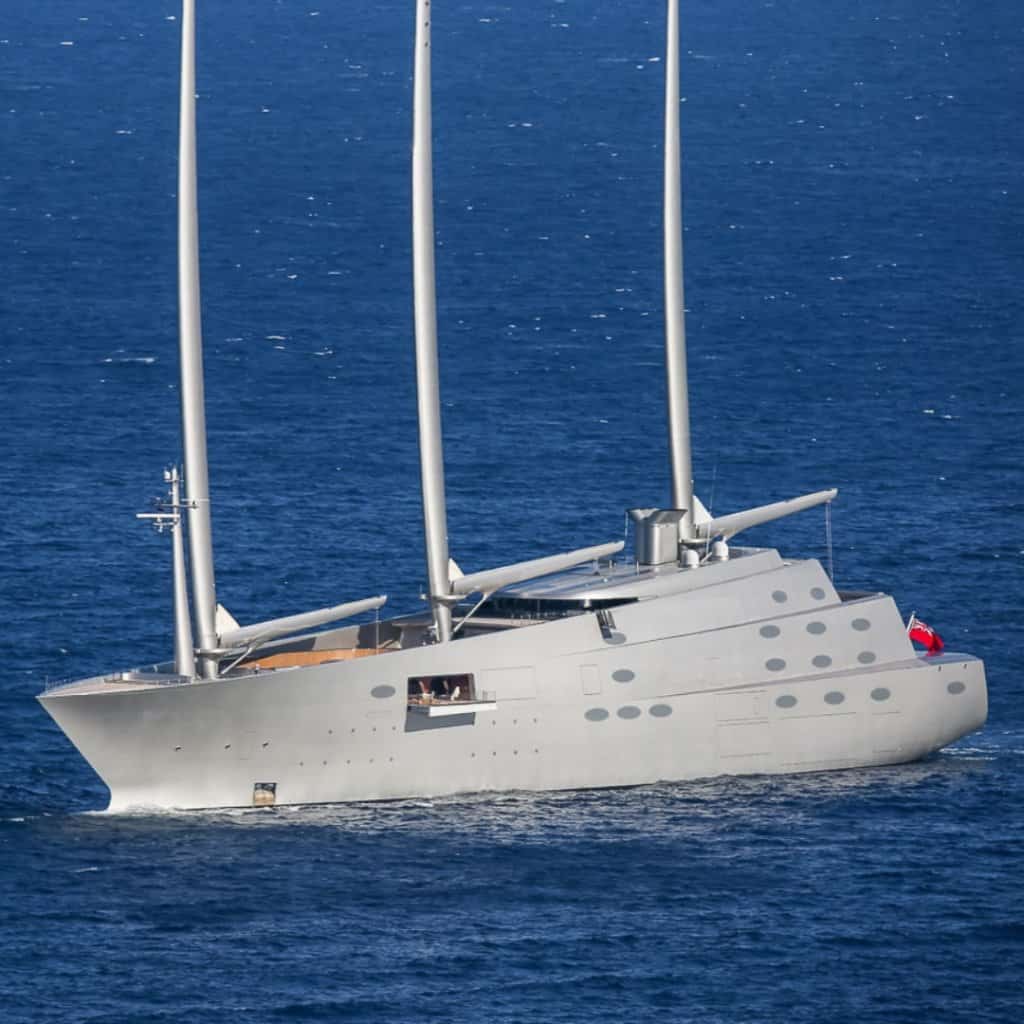
Biggest sailing yacht controversy
It has been the topic of debate that SAILING YACHT A is not the largest yacht in the world but instead the ‘largest sail-assisted motor yacht.
Depending on the definition used, that would make BLACK PEARL the biggest sailing yacht in the world.
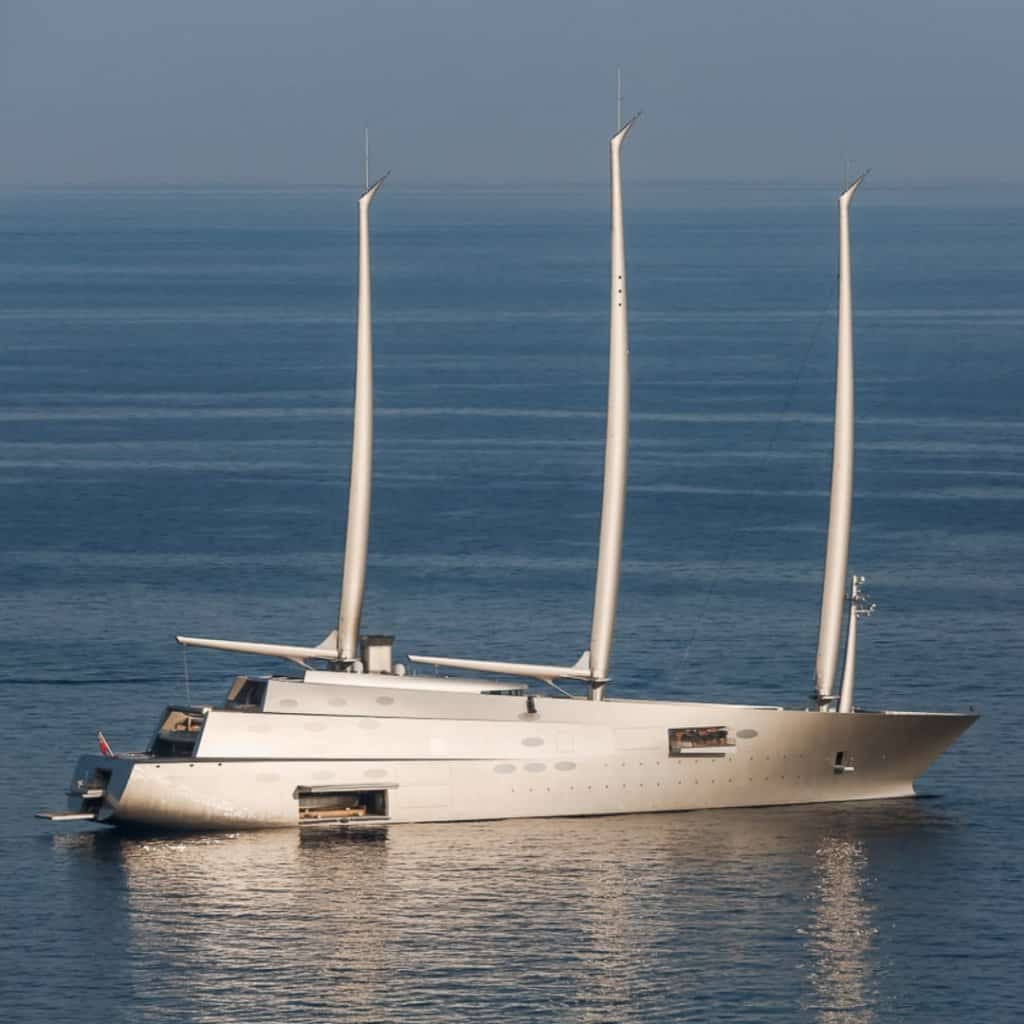
The most expensive sailing yacht
SAILING YACHT A is the most expensive sailing yacht in the world and cost an estimated price of US $600 million – a relatively “affordable” price considering her large size and tonnage.
A calculated US $48,000 per ton is considered low in the yachting industry, where European yachts are usually priced at US $60,000 per ton and over.
This average price would bring the value of SAILING YACHT A up to nearly US $800 million. However, due to the fact that the official sales price has not been released to the public, these numbers are mere estimates and cannot be validated officially.
Since the yacht is a custom project and one of a kind, it can be assumed that the total value of SAILING YACHT A lies far higher than her initial price.
In addition to any cost for the crew, supplies, and docking fees, she has annual running costs of US $50-75 million.
SAILING YACHT A is currently not available for sale or charter.
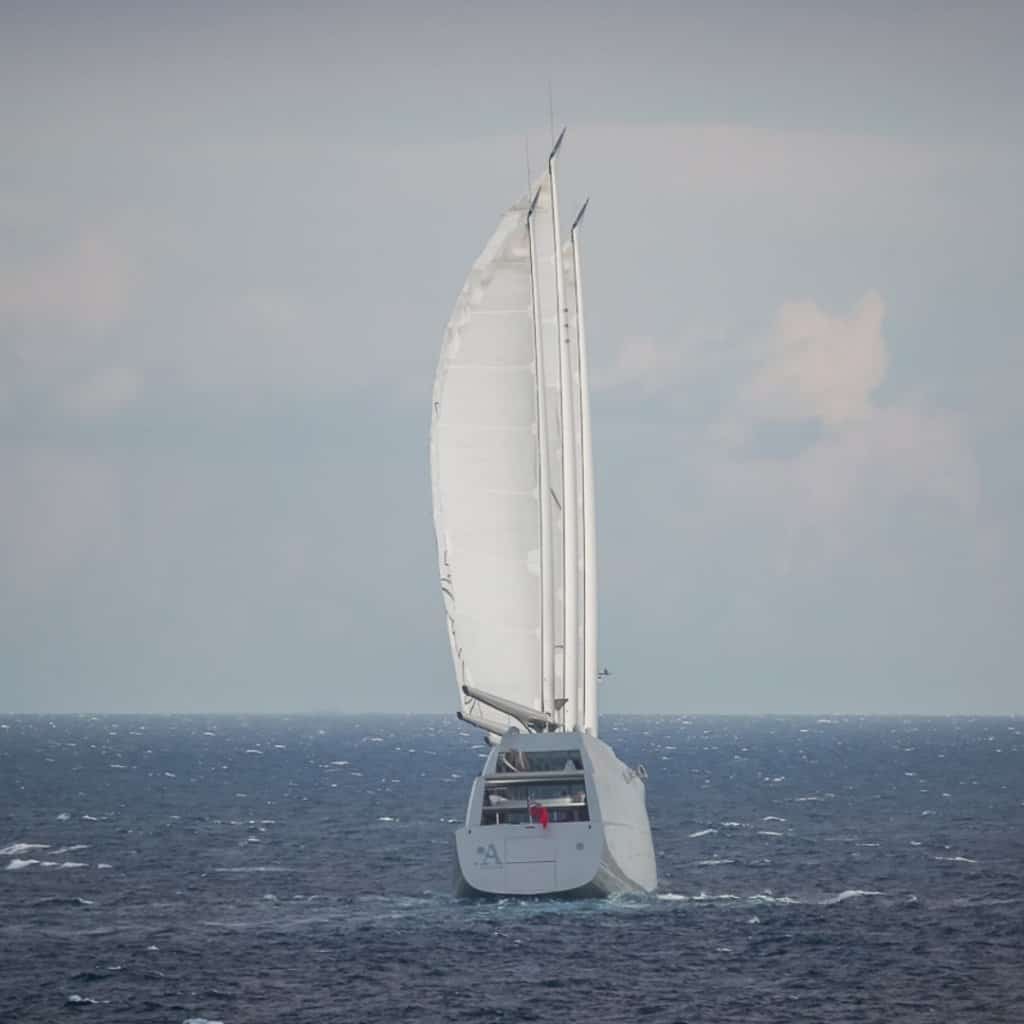
Specifications
SAILING YACHT A is incredibly large for a sailing yacht, and even compared to the longest motor yachts in the world, she would rank in the top ten.
Paired with her unusual futuristic design, this mega sailing yacht has a length of 143 meters (469 ft), a beam of 25 meters (82 ft), and a draft of 8 meters (26 ft) making her a more than an impressive vessel.
SAILING YACHT A was built by Nobiskrug , a German superyacht builder at their Kiel shipyard, and launched in 2017 after more than two years of construction.
To date, SAILING YACHT A is the largest yacht ever built by Nobiskrug and remains their flagship.
It is considered the most complicated project to ever be completed in the sailing industry and gained international media attention on its launch date. It has a total volume of 12.558 tons and is powered by hybrid diesel-electric engines.
SAILING YACHT A is considered the longest sailing yacht in the world and is more than 36 meters (118 ft) longer than BLACK PEARL, which ranks in second place on the list.
Coincidentally her project name was WHITE PEARL which is a reference to her brilliant white exterior, although it couldn’t have referred to BLACK PEARL since she was only launched in 2018, a year after Melnichenko’s masterpiece.
Her three-carbon masts stand at an impressive 100 meters (328 ft), making them some of the largest in the world and taller than Big Ben in London.
However, her large size is sometimes also limiting as she struggles to fit underneath most bridges and is therefore constrained to certain routes.
She once passed under the Golden Gate Bridge in San Francisco with only 20 feet to spare between her masts and the bottom of the famous bridge.
She is rumored to have an electric gimbal crow’s nest, which allows for remote operation and advanced wind measurements. Her sails are all white, and her masts have nearly sickle-like shapes, which add to her striking futuristic appearance.
It is noteworthy that she is commonly photographed with her sails down, which suggests she might be using her support engines more frequently than true wind power.
With a sail area of more than 3.700m^2 (40.000 square ft), she can reach top speeds of up to 21 knots which is supported by her twin 4895 Horsepower MTU engines .
Her average cruise speed lies at 16 knots, and her total range is estimated to lie at 5320 nautical miles. She features a state-of-the-art sail system that is able to raise and lower the sails and anchors at the touch of a button.
SAILING YACHT A has a steel hull and composite steel superstructure, which is unusual in the superyacht industry as most shipyards choose aluminum to reduce weight and keep the vessel light.
She currently sails under the flag of Bermuda, which is common for prominent sailing yachts.
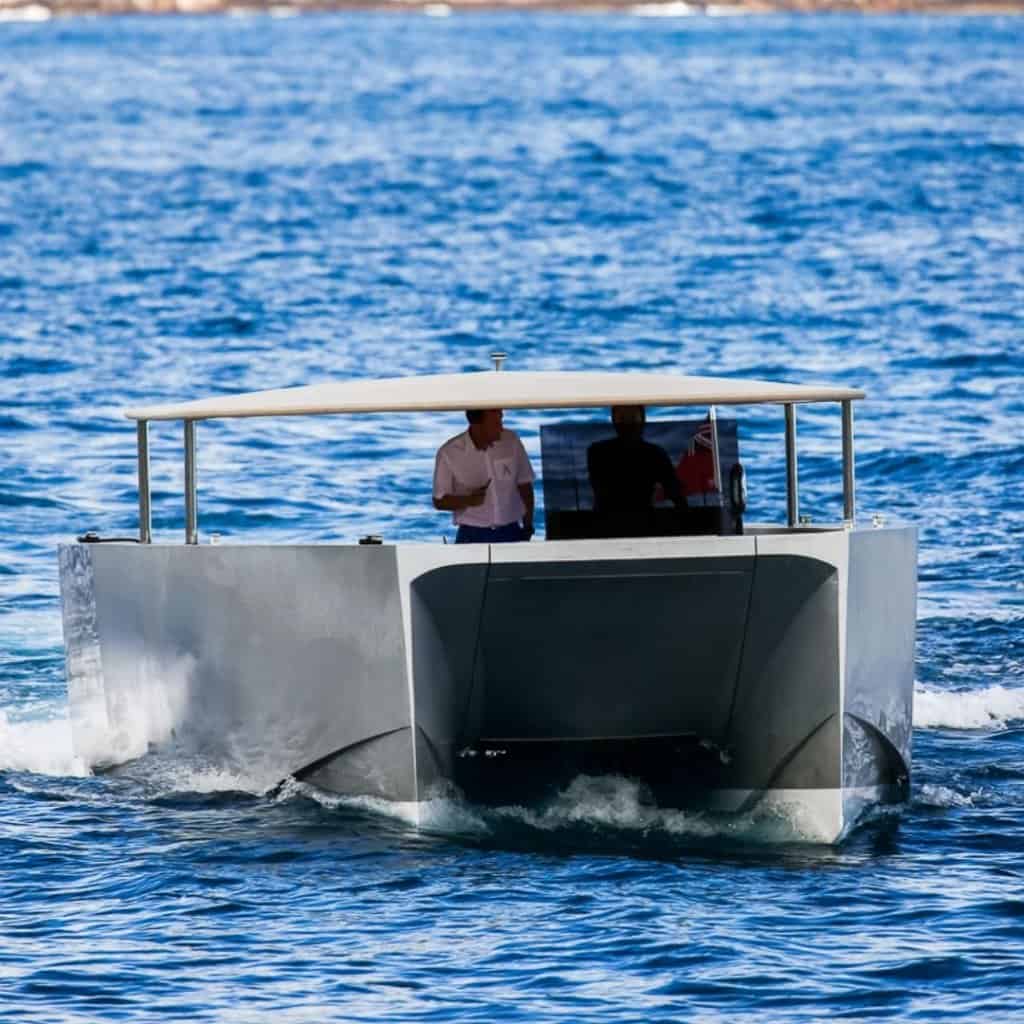
During construction, SAILING YACHT A was called project WHITE PEARL, a fitting name for this sizable vessel.
Like her interior, the exterior of SAILING YACHT A was designed by Philippe Starck, although the Dutch studio Dykstra Naval Architects played a role in the naval architecture of the vessel.
They specialize in sailing yachts of all sizes and have been involved in many prominent projects in the industry over the years.
She features eight teak decks with a large swimming pool located in the center and several elevators spread across the yacht.
She is even said to carry a submarine. The main pool is lowered into the deck allowing for additional privacy for the owners.
Her hull has 24 shell doors, which are used to access equipment and provide additional deck space if needed. She is accompanied by four tenders also designed by Philippe Starck and built by Lloyd Stevenson in New Zealand.
Their sleek and elegant design matches that of the main vessel, and they are used for transporting guests and taking them on excursions.
One of the tenders of SAILING YACHT A is a carbon fiber speedboat especially reserved for the owner who can operate the vessel autonomously whenever required without the aid of crew members.
This allows Melnichenko, who is a fan of driving high-speed cars to be independent when staying aboard his luxury yacht. The tender is small but powerful, reaching speeds of up to 53 knots.
The larger tenders can seat up to eight passengers and feature panoramic windows ideal for sightseeing and exploring but are much slower at only 30 knots.
The aft features a large garage used for storing jet skis, tenders, and other equipment.
High-profile artists such as Snoop Dogg are rumored to have performed here, although detailed evidence of such concerts remains unknown.
Whenever the aft isn’t used for performances or parties, it can be transformed into a swimming platform designed in the yacht’s iconic futuristic style.
However, despite her cutting-edge design features, SAILING YACHT A surprisingly also includes classic nautical elements. She has a wooden steering wheel that is reminiscent of a pirate ship, although it is not operational.
The captain of the vessel can instead use modern technologies to operate the massive yacht via a small joystick and touchscreen.
There are symmetric extendable balconies that protrude from the bridge of the yacht and allow the crew to have a better view to be able to gauge the dimensions of the immense vessel.
Of course, SAILING YACHT A has a modern underwater lighting system that illuminates the vessel perfectly at night.
Do you have anything to add to this listing?
- Phillipe Starke
- Reymond Langton Design
Love Yachts? Join us.
Related posts.
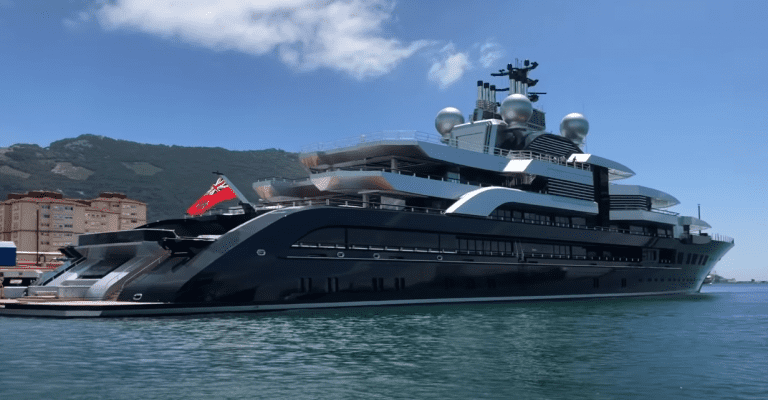
CRESCENT Yacht – Stunning $600 Million Superyacht
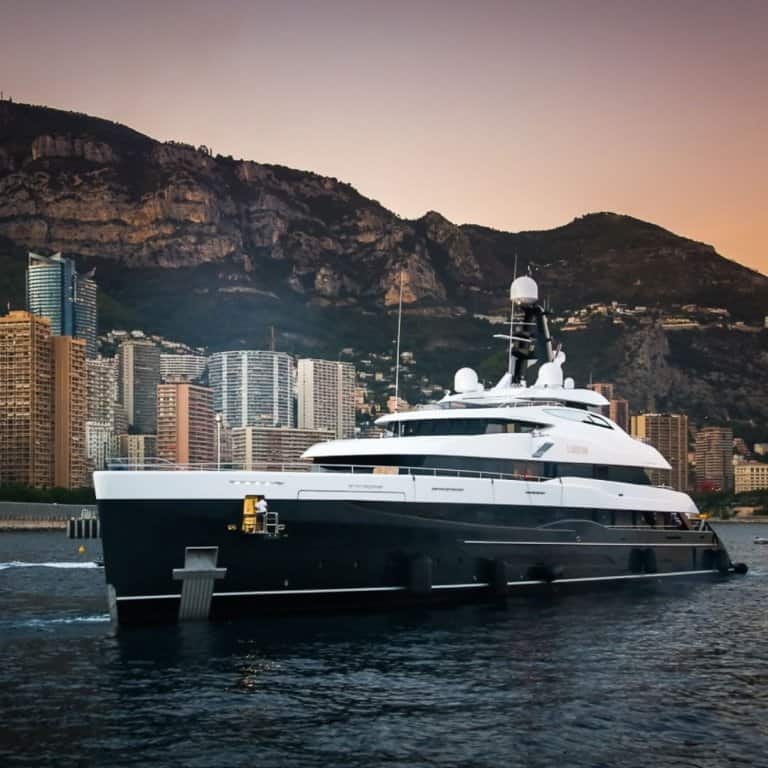
ELANDESS Yacht – Seafaring $115 Superyacht
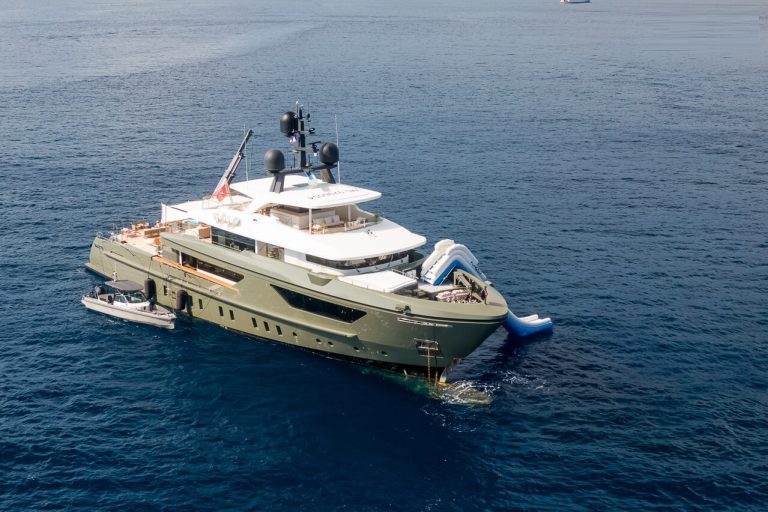
MOKA Yacht – The Epic $19 Million Superyacht
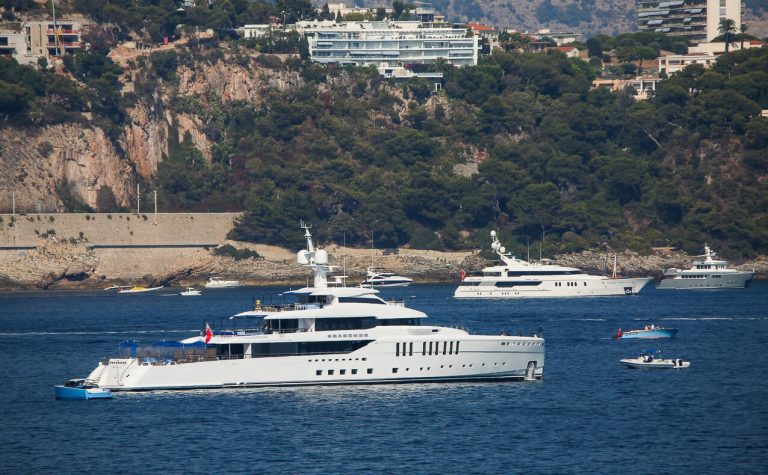
SEASENSE Yacht – Fantastic $65 M Superyacht
- Pontoon Boats
- Personal Watercraft
- nauticalknowhow
- Nautical Knots
- Tools and Calculators
Sailing Yacht A: Everything You Want To Know
The sailing yacht known as A was built between 2015 and 2016 by German yacht makers Nobiskrug based on designs by French architect Phillippe Starck that seemed to have made use of some naval architecture for inspiration. It currently holds the record for being the world’s largest sailing yacht, though, to be fair, it is technically a sail-assisted motor yacht as it is fully capable of moving under its own power rather than relying on the sails.
Who Owns Sailing Yacht A?
Russian billionaire Andrey Melnichenko, a man who made his fortune thanks to a coal company and a chemical company, is the owner of Sailing Yacht A as well as its older sister yacht the Motor Yacht A. Melnichenko has French designer Philippe Starck design both of the vessels for him.
How Big is Sailing Yacht A?
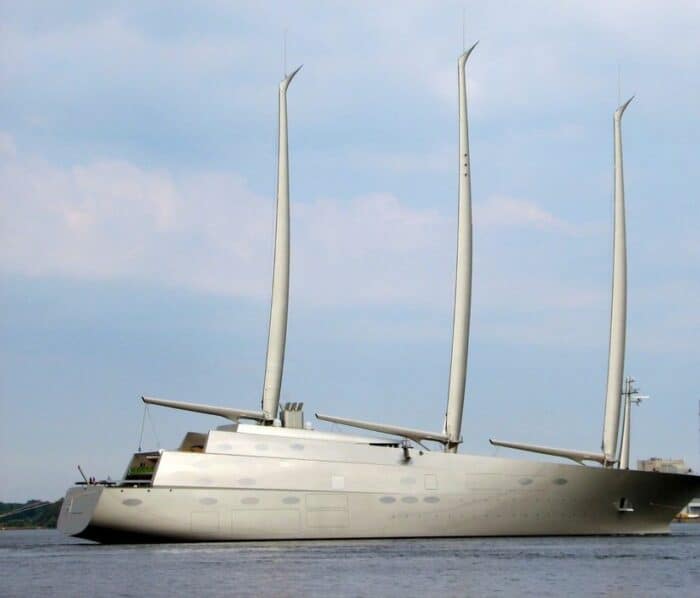
As mentioned, this is actually the largest sailing yacht in the world and it truly is immense. It earned the title of largest sailing yet specifically because of the length which clocks in at a stunning 468.5 feet. Not only is it the longest sailing yacht as a result of that, making it over 50 feet longer than its closest competitor, it qualifies as one of the largest yachts period, sailing or motor powered. It’s the 11th largest yacht in the world if you also include motor yachts.
Even aside from length, the stats are pretty remarkable. The masts, which are very hard to miss, are also gigantic. The main mast stands at over 100 meters or 300 feet tall. The entire boat has a listed height of 328 feet. That makes the A taller than the Tower of London or Big Ben.
The vessel is just over 81 feet wide and has a gross tonnage of 12,558 gt. The sails measure an incredible 3,747 square meters or 40,332 square feet. The sails can be controlled with an in-boom furling system. It also features a gimballed crow’s nest, accessible by an elevator, 60m high in one of the curved, carbon masts.
So It’s the Largest Sail Assisted Motor Yacht?
Technically, yes. There is not really a distinction made for more people between sail-assisted and sailing yacht.
Why Is it Called Sailing Yacht A?
Sailing Yacht A’s owner was being a little crafty when he came up with the name for the vessel. Like his earlier motor yacht, which is also called A or Motor Yacht A, Sailing Yacht A got the name it has so that it will always appear at the top of boat registry lists. It’s kind of like when businesses used to call themselves something like AAAA+ Plumbing so they’d be at the top of the page in the phone book, back when people still used phone books.
What is the Interior of Sailing Yacht A Like?

As you can imagine, there’s a lot going on in this massive yacht. To start, it’s a full eight decks. These can be accessed throughout the yacht with either a number of elevators or the free-floating spiral staircases. It’s rumored that there are cabins for at least 20 guests, plus a master suite on board.
There are oval windows throughout the vessel that are almost impossible to see from outside as they’re covered in a one-way film that allows passengers to look out but prevents anyone from looking in. Some of the rooms have floor to ceiling windows that simply can’t be seen from outside. It’s rumored that the master suite has a rotating bed and is presumably of a significant size as the master suite in the smaller Motor Yacht A was 2,500 square feet.
In terms of luxury amenities there’s plenty to choose from. The yacht has an underwater observation pod right in the keel with windows to the sides and below. The glass is one foot thick to ensure it can handle the pressure. It offers a view of the props in action which is unique and unlike observation windows you’d likely find on any other boats. And unlike many yachts which have launch vessels or jet skis in the garage, this one has a three-man submarine you can take out for fun as well as four tenders.
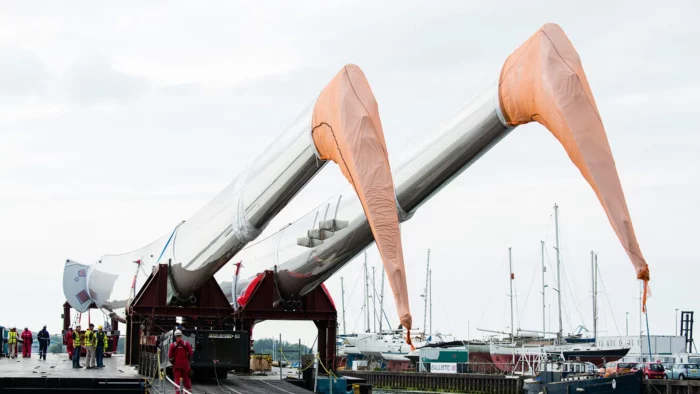
Melnichenko is known for throwing lavish parties – he’s had Lennie Kravitz and Snoop Dogg perform on board Motor Yacht A for him and his guests, and even had Whitney Houston and Christina Aguilera perform at his wedding some years ago, so it’s safe to assume the sailing yacht also features an extravagant party room as well.
A crew of up to 54 operate the vessel and much of that can be done easier than you’d think. Touch screen controls can power and maneuver the vessel at the touch of a button. Even the sails can be raised and lowered with electronic controls and a single person operating them.
In addition to the piloting of the ship, the crew run the yacht’s internal power plant, a professional galley the size of a kitchen you’d expect to find in a hotel, and other guest services like laundry and so on. These services and features are maintained across two of the boat’s 8 decks.
Much like any other yacht of this size, there is a helipad on the deck, and you can also find a large pool in the center of the deck as well. There are two other pools and all three are said to have current-generating technology to give them a more realistic ocean feel. As in his previous yacht, one of the pools has a glass floor so that you can see up into the pool from the deck below.
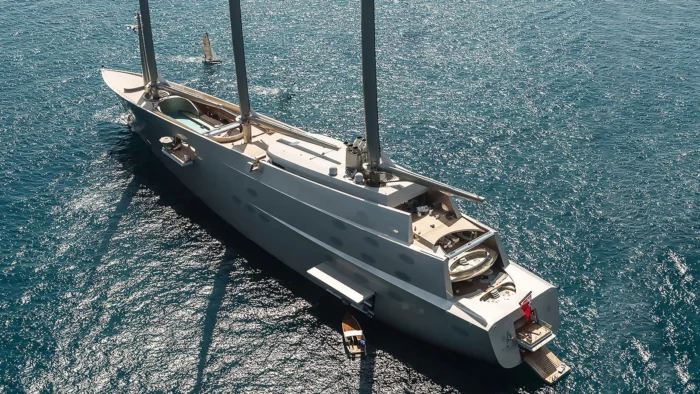
Many of the internal features have been kept under wraps as few people have had a chance to go on board the yacht. One particularly odd feature that has been noticed, however, is a chair on deck shaped like a giant, human head. Other glimpses of the interior have also shown off things like a large hot tub which has storage underneath it for a number of lifeboats, and the stunning blue navigation lights that line the exterior from bow to stern, just along the waterline.
The security features on the boat have not been disclosed, for obvious reasons, but Melnichenko previous yacht was rumored to feature everything from bomb proof glass to fingerprint scanners for enhanced security at key entry points.
Was Sailing Yacht A Seized?
In March, 2022, Sailing Yacht A was seized by Italian authorities in the Port of Trieste after Andrey Melnichenko was placed on an EU sanctions list following Russia’s invasion of Ukraine. Many Russian billionaires who have had ties to President Vladimir Putin had sanctions levied against them which resulted in assets being frozen or confiscated all over the world.
For unknown reasons, A was placed back in the water in June 2022 after being in dry dock for a few months. It was officially listed as being at anchor at that time with no further details about why the change in status. Melnichenko had stated at the time that he was going to contest the seizure of the luxury yacht but it’s unknown when or if that happened.
What Did Sailing Yacht A Cost?

Billionaires don’t always like to share their expenses with the world and Andrey Melnichenko is no different. He has not disclosed what he paid for the mega yacht and the yacht makers built it with a very thorough non-disclosure agreement in place that prevents them from sharing any of the particulars.
The fact that there has been no officially confirmed price tag doesn’t mean there hasn’t been some solid speculation about the price which has yet to be refuted. According to most sources, the yacht likely cost its owner somewhere in the neighborhood of €530 million which, at the time, probably worked out to around $578 million to $600 million US.
How Fast is Sailing Yacht A?
The props on the yacht are powered by twin MTU 20V 4000 ML73 main diesel engines or by electric motors or even by both together. It runs up to 2,050rpm, giving 2,800kW, and makes use of four generators instead of five to cut down on the overall weight. The generators are able to run down to 1,050rpm when it’s appropriate. Something called Superimposed System Controller (SSC) is able to constantly recalculate the optimal speed and determine the best combination of generators to use from moment to moment. This ensures optimal fuel and power usage while also limiting noise and vibration.
The result of all of this engineering is that the yacht has a cruising speed of 16 knots and a top speed of 21 knots.
The Bottom Line
Sailing Yacht A is the largest sail-assisted yacht in the world and, although the price is just speculated to be around $600 million, it’s clearly one of the most expensive yachts in the world as well. The exterior design is sleek and subtle and is able to hide many features including shell doors and windows while the interior spans 8 decks and has room for 54 crew and up to 20 passengers on board. The boat was seized by Italian authorities in 2022 and it’s unknown if or when the owner will get it back.
My grandfather first took me fishing when I was too young to actually hold up a rod on my own. As an avid camper, hiker, and nature enthusiast I'm always looking for a new adventure.
Categories : Yachts
Leave a Reply Cancel reply
Your email address will not be published. Required fields are marked *
Save my name, email, and website in this browser for the next time I comment.
More in Yachts
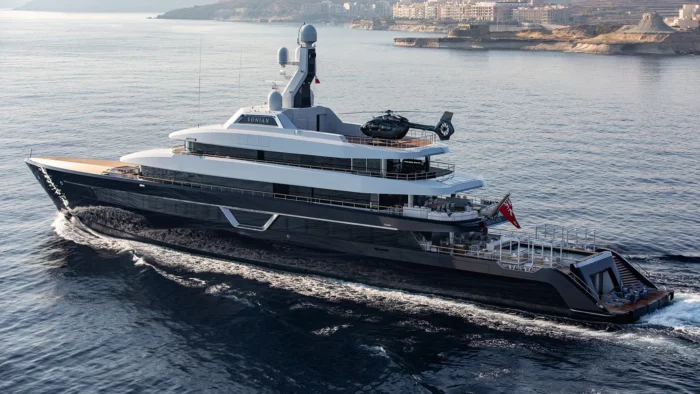
Lonian Yacht: An Insider's Guide
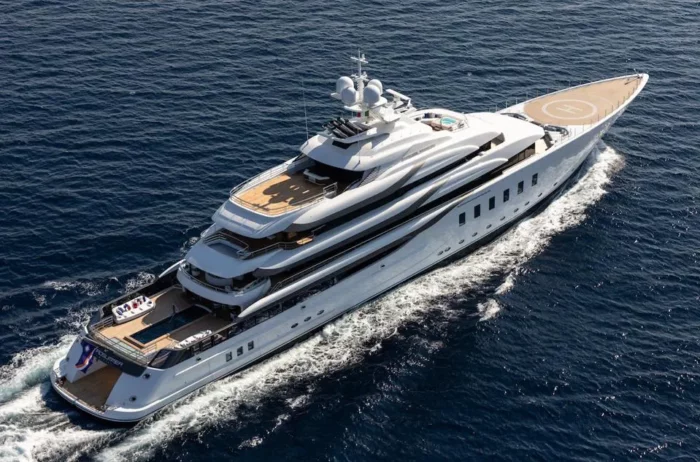
A Closer Look at the Madsummer Yacht
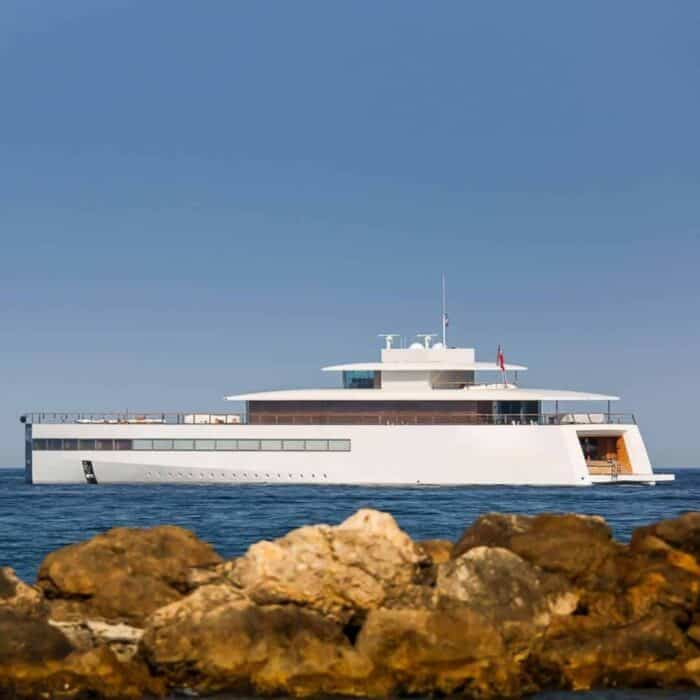
Your Insider’s Look at Steve Jobs’ Yacht Venus
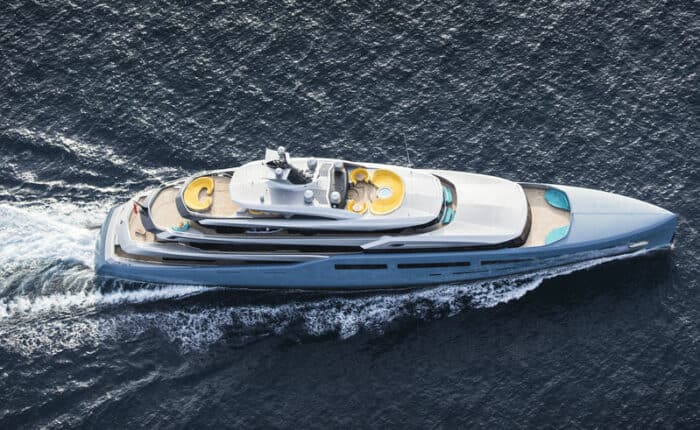
Your Insider’s Guide to the Aviva Yacht

The People’s Poncho Review and Ratings

Oru Lake Kayak Review

What Is A Gunwale?

131 of the Best Hawaiian Boat Names

167 Patriotic Boat Names
About boatsafe.
Established in 1998, BoatSafe is your independent guide into the world of boating, fishing, and watersports. We provide expert insights and detailed guides to help you find products tailored to your needs and budget.
Contact Boatsafe
- Address: 4021 West Walnut Street. Rogers, AR 72756
- Phone: (479)339-4795
- Email: [email protected]
Site Navigation
- How We Test
- Corrections Policy
- Privacy Policy
- Terms & Conditions
- Editorial Policy
- Affiliate Disclosure
Our Reviews

All content is © Copyright 2024. All rights reserved.
The 15 Different Types Of Sailing Ships
The 15 types of sailing ships are listed below.
- The Schooner
- The Carrack
- The Brigantine
- The Barquentine
- The Clipper
- The Windjammer
- The Fully Rigged Ship
Throughout centuries, there have been many different types of sailing ships seen from harbors and coastlines around the world.
This article will show the various types of sailing vessels that have made their mark in maritime history and we showcase their purposes and why they are still remarkable feats of marine engineering.
The different sizes, shapes, and masts of the ships required different numbers of sailors to handle them and each type of ship was crafted with a different purpose in mind.
All ships are unique with no two types of ships being the same with each coming with its own experiences, features and requirements.
1. The Schooner
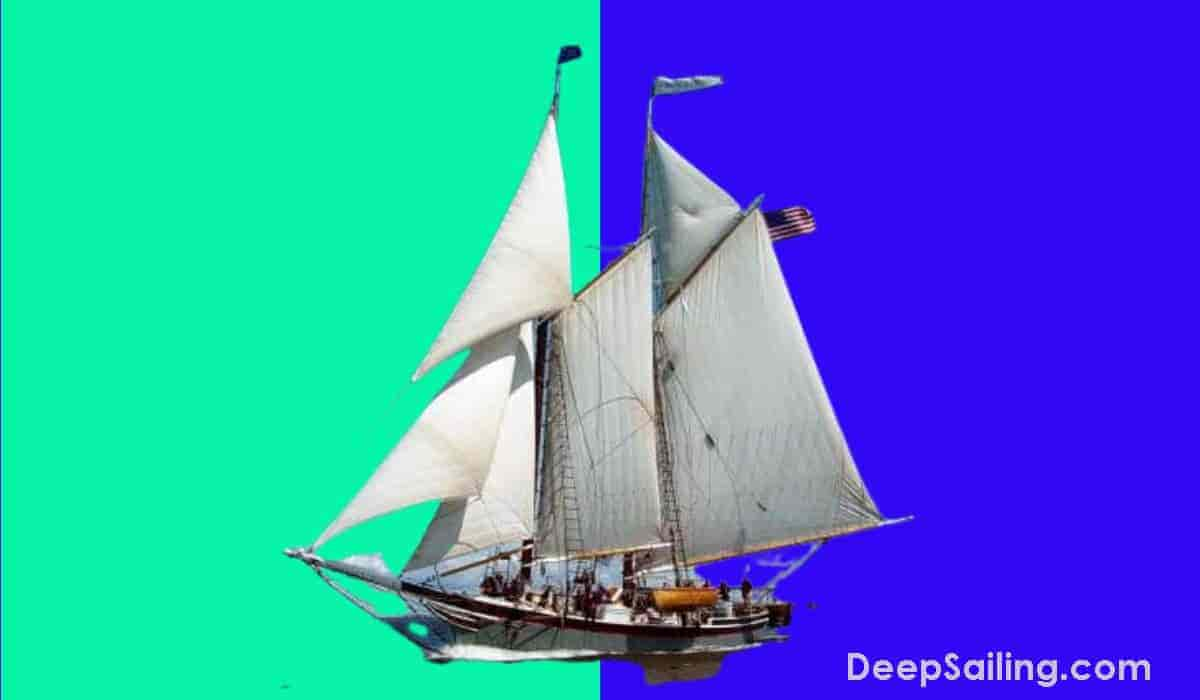
The Schooner sailing vessel, with an average size of 46m (152 feet) in length, was developed in the early 17th century and first used by the Dutch.
The ship came with fore and aft sails and they were created to operate in the toughest of wind and ocean conditions.
The Schooner was a multi-purpose sailing vessel used for transporting slaves to transporting cargo and it was used for fishing and racing too.
There are 5 different schooner types that are characterized by their rig configurations listed below.
- Tern schooner : This was a 3-masted schooner most popular between 1880 and 1920 capable of carrying up to 400 tons in cargo and it required a crew of 6-8 people
- 4-6 masts schooner : These schooners spread the sail area over smaller sails
- Grand Bank Fishing schooner : Similar to the famous Bluenose, it carries the main gaff topsail and a fisherman's staysail set between the masts.
- Square Topsail schooner : This was a combination of fore and aft sails and small square sails, most popularly used for coastal cargo transportation in the 1800s
- Coastal schooner : This was a coastal schooner sailing ship used for carrying goods and general cargo to nearby islands along the coast ( 1 )
The 19th Century schooner came with two or three masts, the one at the fore being shorter than the others.
Modern schooners, with Bermuda rigged sails, remain powerful, economical coastal liners traversing the Pacific.
Famous schooner sailing ships are listed below.
- America : The Schooner named " America " was designed for racing and it became the first winner of the America's Cup international sailing trophy ( 2 )
- Thomas W Lawson : The schooner “ Thomas W Lawson ” had a unique seven masts, with interchangeable sails and gear
- Wawona : The schooner " Wawona " was one of the largest lumber carriers and fishing vessels between 1897 and 1947
2. The Carrack
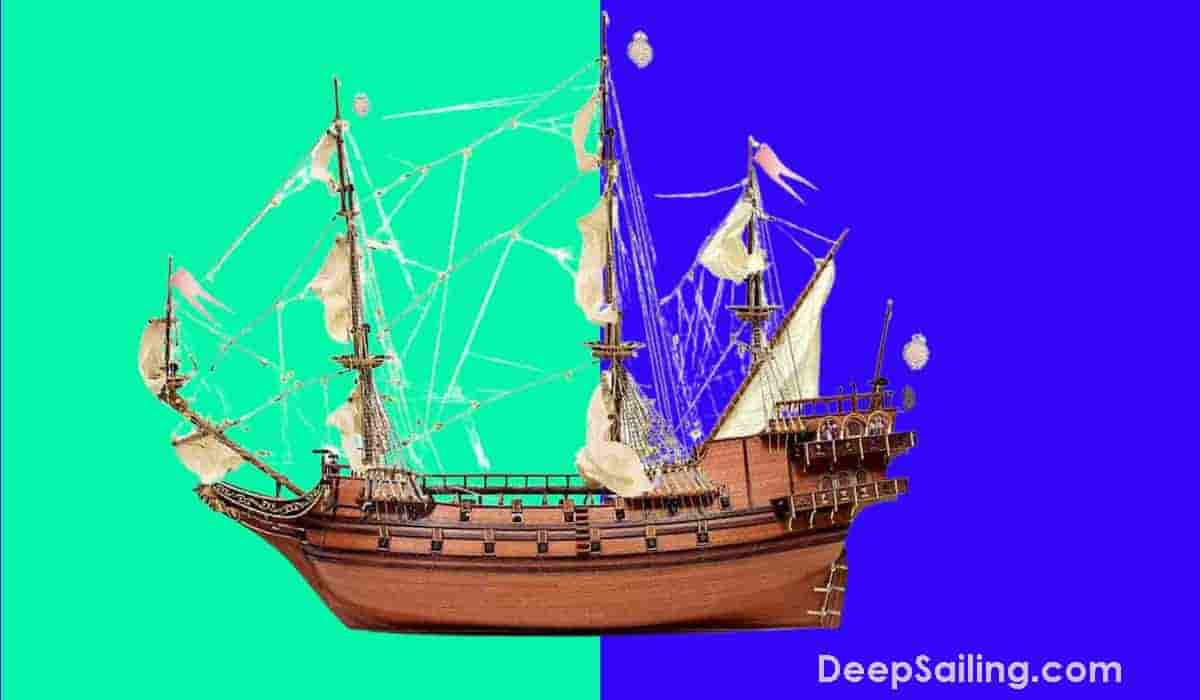
The Carrack, developed in the 14th and 15th centuries with the first built in Portugal, is a nautically-rigged wooden ship with three or four masts each having square sails or triangular sails and it was heavily used between the 14th to 15th Centuries and remained popular until the 18th Century. It is the sailing ship Christopher Columbus used to sail the world.
It was the largest ship in Europe with the Spanish Carrack being more than 1,000 tons in weight and 150 feet (45 meters) in length. More modern versions of the Carrack were developed by the Portuguese and they could hold up to 2,000 tons. ( 3 ).
The Carrack had 4 decks with the lower 2 used for cargo, the 3rd was for accommodation and the 4th was for cargo owned by the crew ( 4 ) and this bulky ship was the standard trading ship along the Baltic, Mediterranean, Asian, and Atlantic coasts in the mid-16th century useful for carrying cargo across seas.
The Carrack had a strange shape which made it cumbersome to sail close to the wind and after a lot of engineering experiments, parts of the ship were stripped off giving the ship a high stern and a low bow.
The modern Carrack features a square-rigged mainmast, foremast, and a latten-rigged Mizzen mast, along with a rounded stern, sizable bowsprit, forecastle, and aft castle.
This is a large ship, built to carry heavy freight for long-distance hauls since it was very steady even in the worst weather with the British Army calling it the “Great Ship” because of its highly-functional ship design.
Famous carrack shipping vessels are listed below.
- Santa Maria : This was the famous ship that Christopher Columbus used to sail and discover America in 1492
- Victoria : The first ship to circumnavigate the globe
- Grace Dieu : This was commissioned by King Henry V and it was one of the largest carrack ships in the world in 1418
- Cinco Chagas : This was presumed to be the richest ship at that time. it was sunk in battle in 1594 ( 5 )
3. The Brigantine
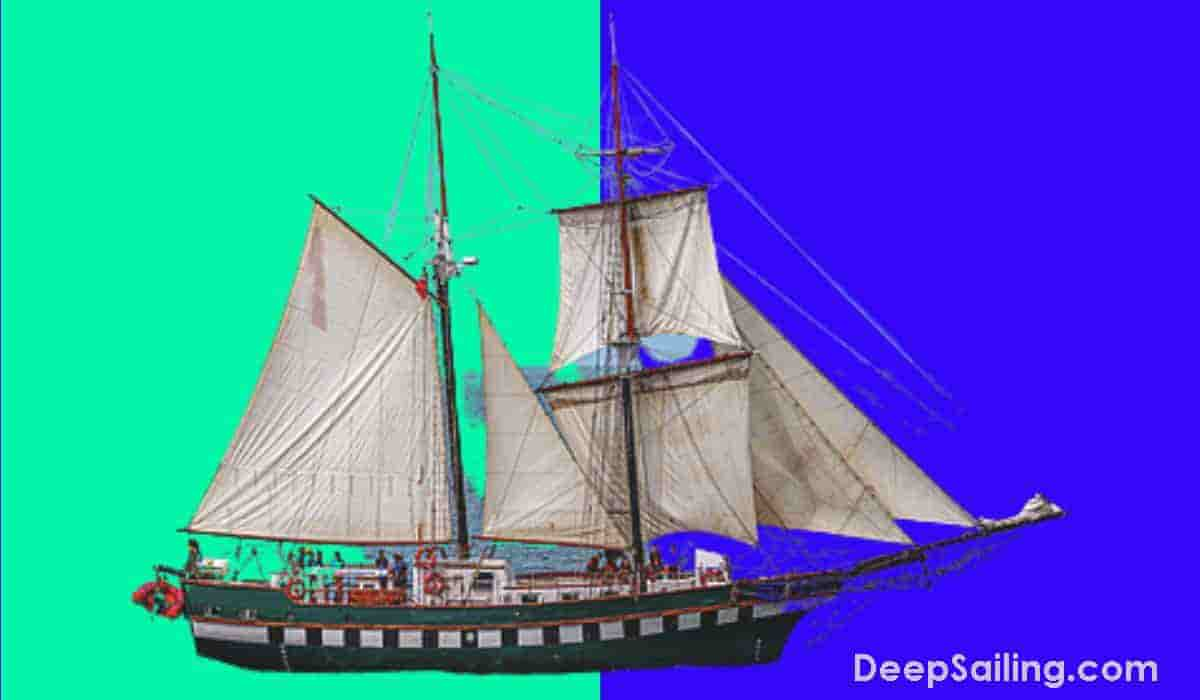
A Brigantine is a two-masted sailing ship with the main mast both a fore-and-aft main sail, a triangular type of sail and a square main topsail that came in various sizes ranging from 30 tons to 150 tons and it could carry a crew of up to 125 people but the shipping vessel could still be handled by a smaller crew if needed.
These ships were similar to the sailing vessel called the Brig as they both had top-gallant sails and were used by the Royal Navy to scout and monitor enemies on the high seas while also being popular amongst pirates as they were faster and easily maneuverable sailing vessels.
It is unclear when the ship was originally built with loose definitions date the ship back to the 13th century when it was originally referred to as the "sail and oar-driven war vessel" ( 6 ) and early academic definitions where the vessel was referred to as the "Brigantine" was first seen in books in the early to mid-16th century ( 7 ).
They would sail across the trade routes of the Baltics and Northern Europe, all the way from Germany to Scandinavia.
The mid-size ships had two sails on the-mainmast with a stripped-down fully-squared rig.
4. The Barquentine
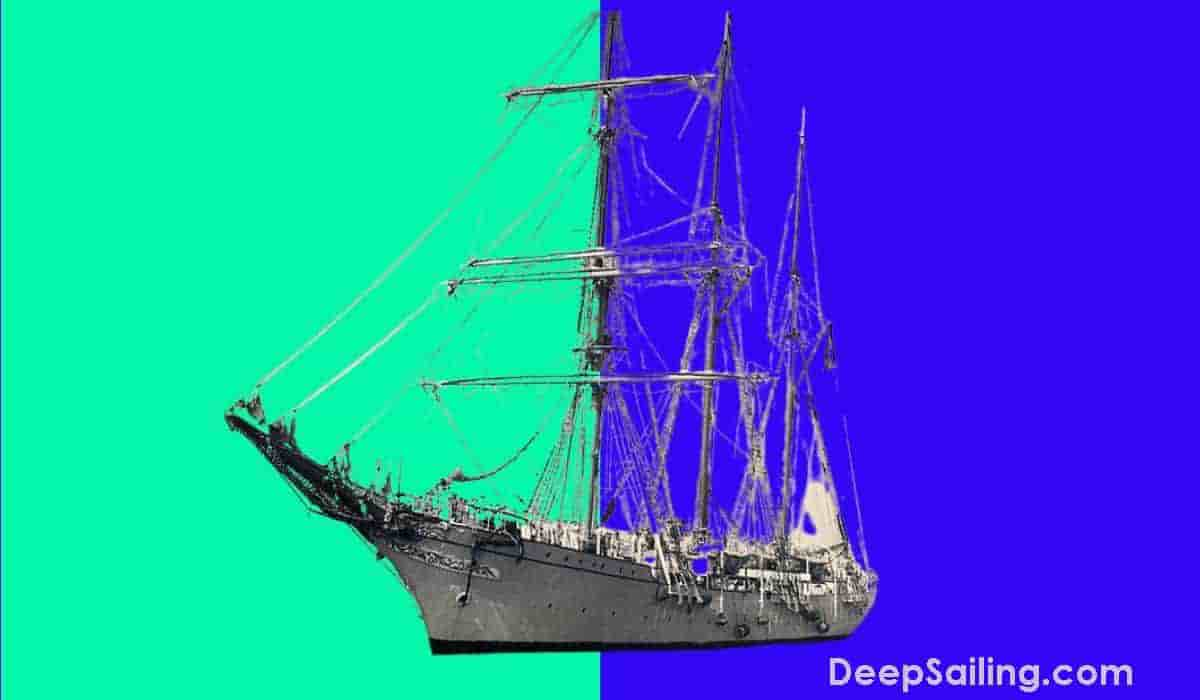
The Barquentine, first built in the 17th century and also referred to as a " schooner barque ", " barkentine " or " schooner bark ", is a sailing ship similar to a barque but with only the foremast square-rigged and the remaining masts rigged fore and aft ( 9 ). They weighed 250 to 500 tons.
The Barquentine has three or more masts and square sails on the fore and aft masts with the main mast had topmast and gaff sails and these had been stripped down to facilitate operation by a slimmer crew and basic rig.
The Barquentine sailed the waters of Northern Europe which were dominated by variable wind speeds and they were popularly used to carry lumber from Scandinavia and Germany to England and the Baltic Areas.
5. The Xebec
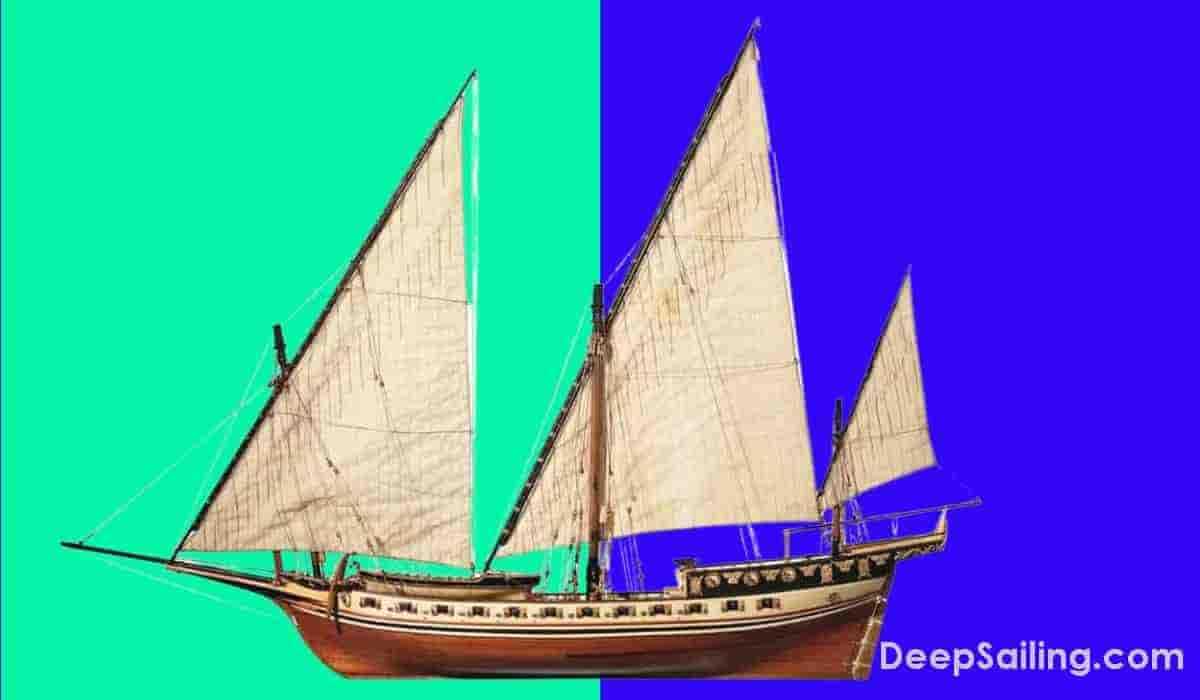
The Xebec, also known as " Zebec ", a name derived from the Arabic word for "Small Ship", was a sailing ship built in the 16th to mid-19th century that was used mainly for moving cargo.
The Xebec sailing vessel held between 90 and 400 crew and was 103ft 9 inches in length with a tonnage of between 200 - 300 tons ( 10 ) and they were very agile and popular with European navies.
The features of the Xebec are listed below.
- Long-prow bulkheads
- Narrow elongated hulls
- Huge lateen yards
- One aft-set mizzen mast
- 3 lateen-pillared masts, both raked forward and having a single triangular sail
Their shallow draft and lateen rig allowed for a closer pinch to the wind allowing them to flee quickly or turn around and fire a broadside volley quickly.
After a lot of engineering experiments, the Xebec gave rise to the Polacre-Xebec, which replaced the mizzen mast. The mainmast of the new derivative also had a square rig and these new vessels were light and could not carry a heavy load with the shallow draft and low free-board making them unsuitable for open-seas sailing.
6. The Barque
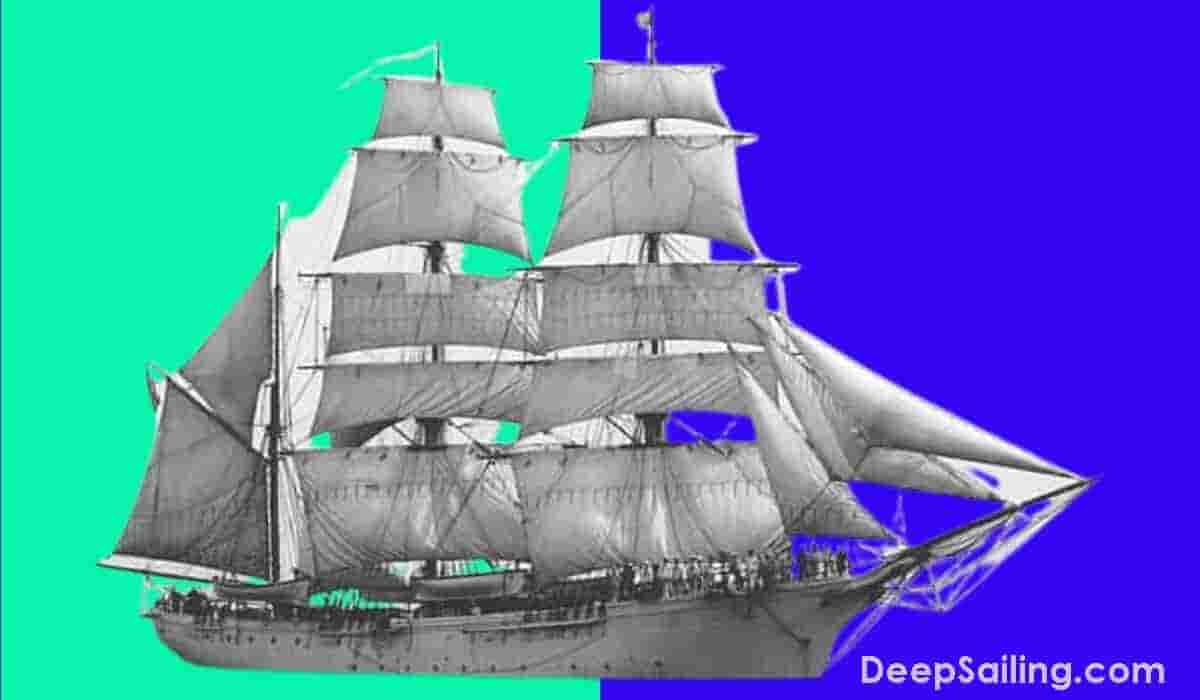
The barque, also referred to as " barc " or " bark ", is a sailing ship first introduced in the 15th century ( 11 ) with 3 or more masts with square sails on all masts, except the aft or mizzen mast. It could carry approximately 500 tons and could hold a crew of 100 people.
Although they are quite similar, the barque should not be confused with the Schooner Bark which is a different vessel.
The Barque ship was commonly used by traders to carry extremely high volumes of cargo from Australia to Europe with cargo mainly consisting of Nitrates and Guano destined for the Western South American coast and they were popular in the period prior to the start of World War II.
7. The Clipper
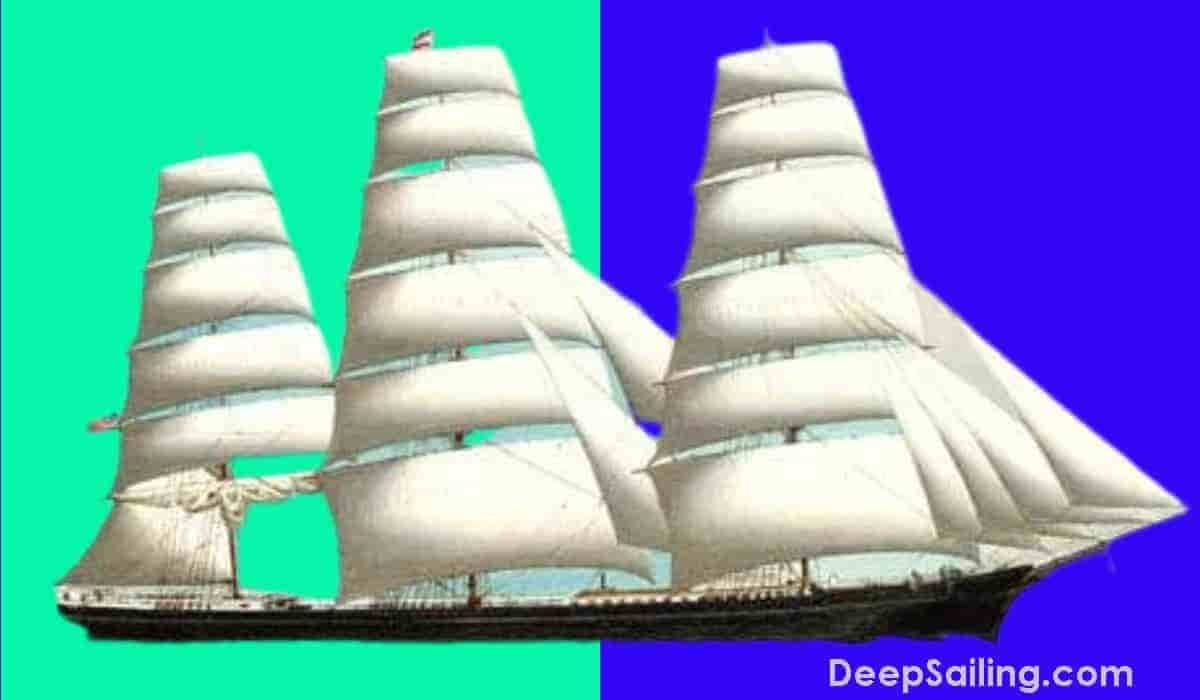
A clipper was a sailing vessel introduced in the mid-19th century that was mainly used as a merchant ship for transporting goods and it was designed for speed.
Clipper ships ranged in size from a few hundred tons to over 4000 tons ( 12 ) and they all had a narrow build, a protruding stern, 3 to 5 masts for speed, and a square rig.
They were most commonly used by British and American traders to ship goods from China to their countries and they were also used to ferry Gold and Tea back to Great Britain and the Americas.
Famous clipper ships are listed below.
- Cisne Branco : This is a steel-hulled built like the original clipper. It is used as a training vessel by the Brazilian navy to this day
- Race Horse : This clipper ship set the record of getting from New York to San Francisco in 109 days in 1850 which was a record at that time
- Marco Polo : This clipper vessel was the first boat of the time to make around trip between England & Australia in under 6 months in 1852
8. The Windjammer
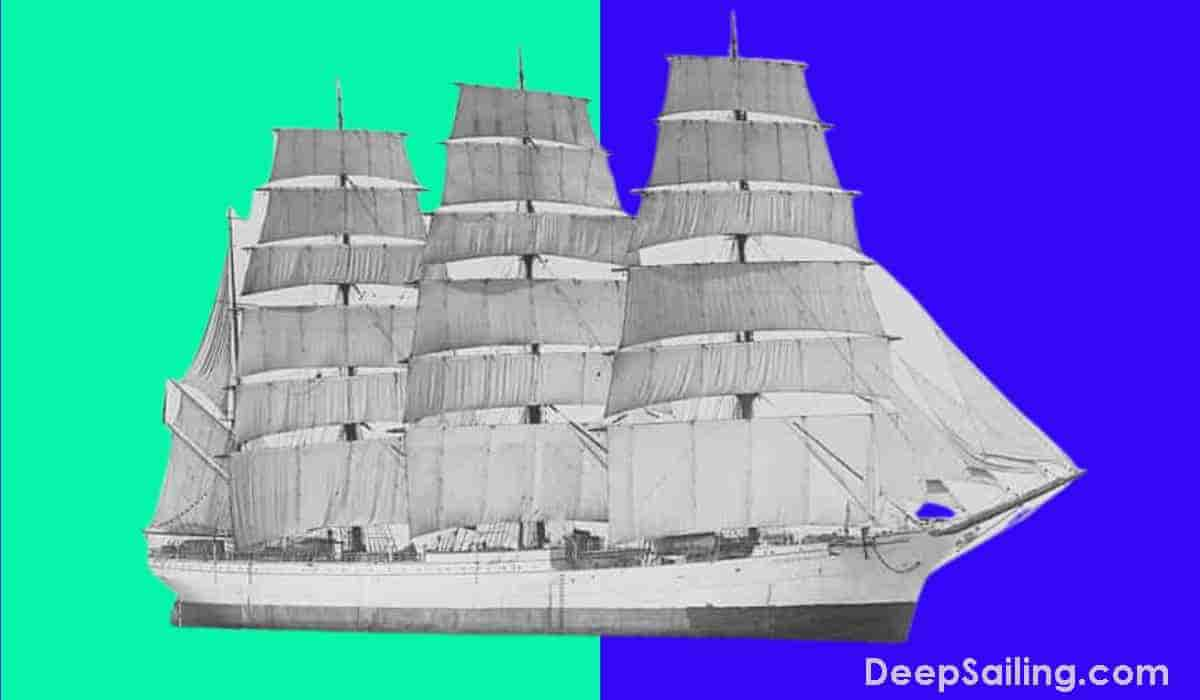
The Windjammer is a commercial sailing ship built in the 19th century with a capacity between 2,000 to 8,000 tons and the speed ranged from 14 to 21 knots ( 13 ).
It came with three to five square-rigged masts and it had a cost-effective extended hull that allowed for larger storage space.
It was a general-class merchant ship and was mainly used to transport bulky cargo and it ferried lumber, coal, and many other goods from one continent to another before evolving from carrying cargo to carrying passengers on cruises in later generations.
9. The Fluyt
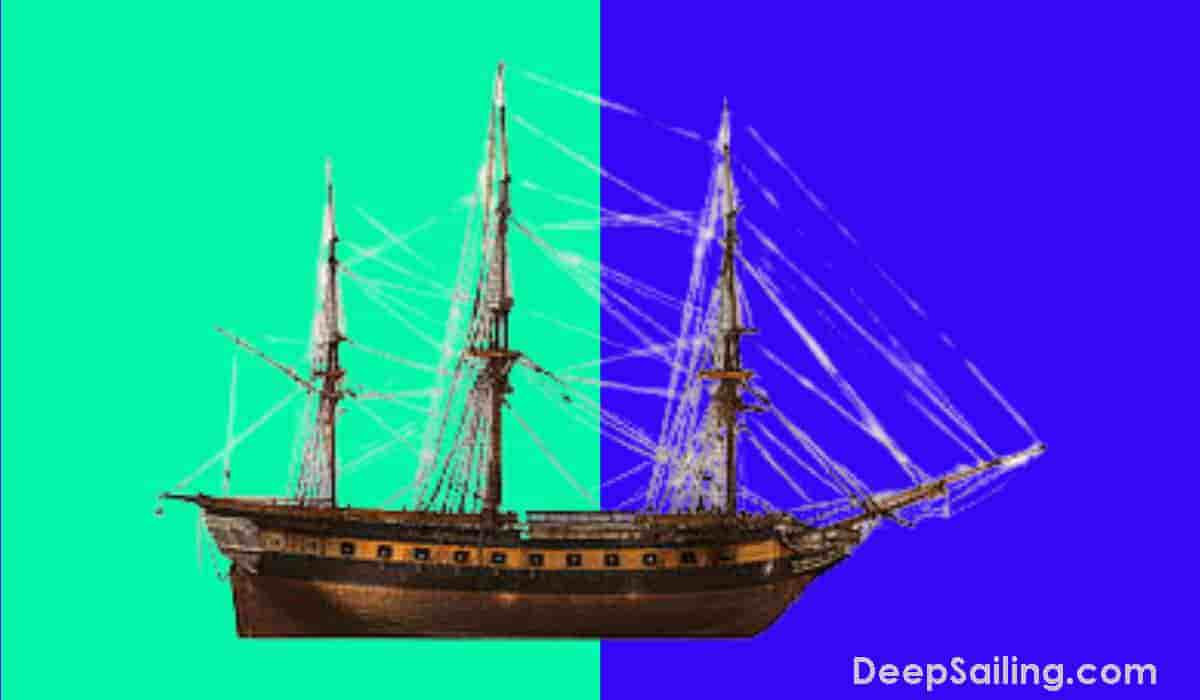
The Fluyt, also known as " fleut " or " fluit " is a sailing ship that originated in the 16th century in the Dutch Republic with a weight between 200 and 300 tons, approximately 80 feet (24 meters) in length, and a crew capacity of 12 - 15 people ( 14 ).
The Fluyt has three squared-rigged masts and was primarily used as a merchant ship to transport cargo.
It was lightly fortified, had a small stern and extended box-style structure, and was crafted using specialized tools to reduce the costs of production and make them affordable to merchants.
10. The Fully-Rigged Ship

A fully rigged ship, also referred to as a "full-rigged ship", is a sailing ship with three or more masts, with all of the masts being square-rigged and the rig, hull, mast, and yards made of iron, wood, or steel.
A full-rigged ship weighed an average 325 tons and could carry a crew of up to 36 people and these ships required a larger crew because of their fully rigged construction ( 15 ).
During the 18th century, a full-rigged ship was also referred to as a " frigate " and they were mainly used for patrolling and for attacking.
A full-rigged ship weighed an average 325 tons and could carry a crew of up to 36 people ( 16 ).
However, towards the end of the 19th century, these ships were stripped down so they could be handled by a smaller crew which helped in easier handling of the sails during the monsoon period when winds would change speed and direction without any warning.
This helped in easier handling of the sails during the monsoon period when winds would change speed and direction without any warning.
A fully rigged ship masts from stern to bow consists of: ( 17 )
- Mainmast : This is the tallest mast on the ship
- Foremast : This is the second tallest mast on the ship
- Mizzenmast : This is the third tallest mast on the sailing vessel
- Jiggermast : If there is a 4th mast, it will be the jiggermast and will be the smallest mast on the ship
11. The Cutter
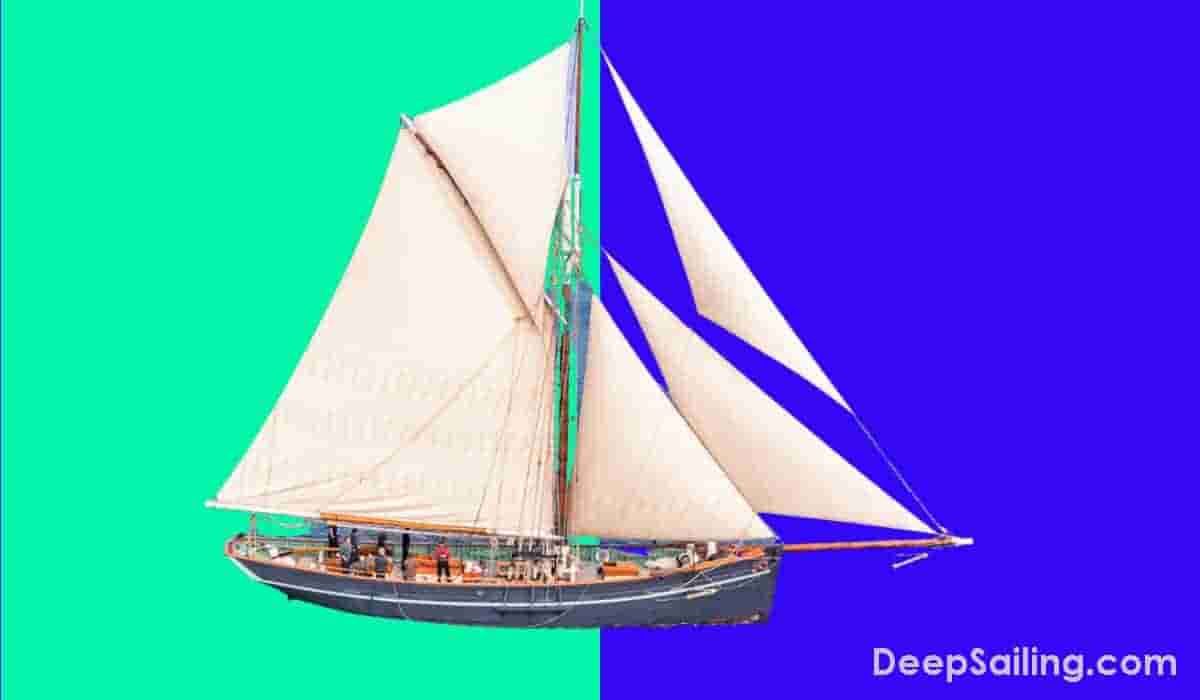
The cutter is a smaller sailing ship built in the early 18th century with a single mast rigged fore and aft and it varied in size from 20ft to 34 ft in length on average with a crew capacity of between 21 to 66 people ( 19 ).
A cutter sailing vessel features: ( 18 )
- Narrow hull
- 2 or more headsails
- Decked sailcraft
- Raking transom
- Vertical stem
- A gaff-rigged long bowsprit
This sailing ship was used for patrolling territorial waters and other enforcement activities during the 18th century and it was used to ferry soldiers and government officials because it was very fast and could outrun any enemy.
Modern-day cutters have a rugged appearance, are small and aptly fit into their intended purpose – speed and agility and the British Sailing Club still has open-oared cutters in their fleet of sailing ships.
12. The Yawl
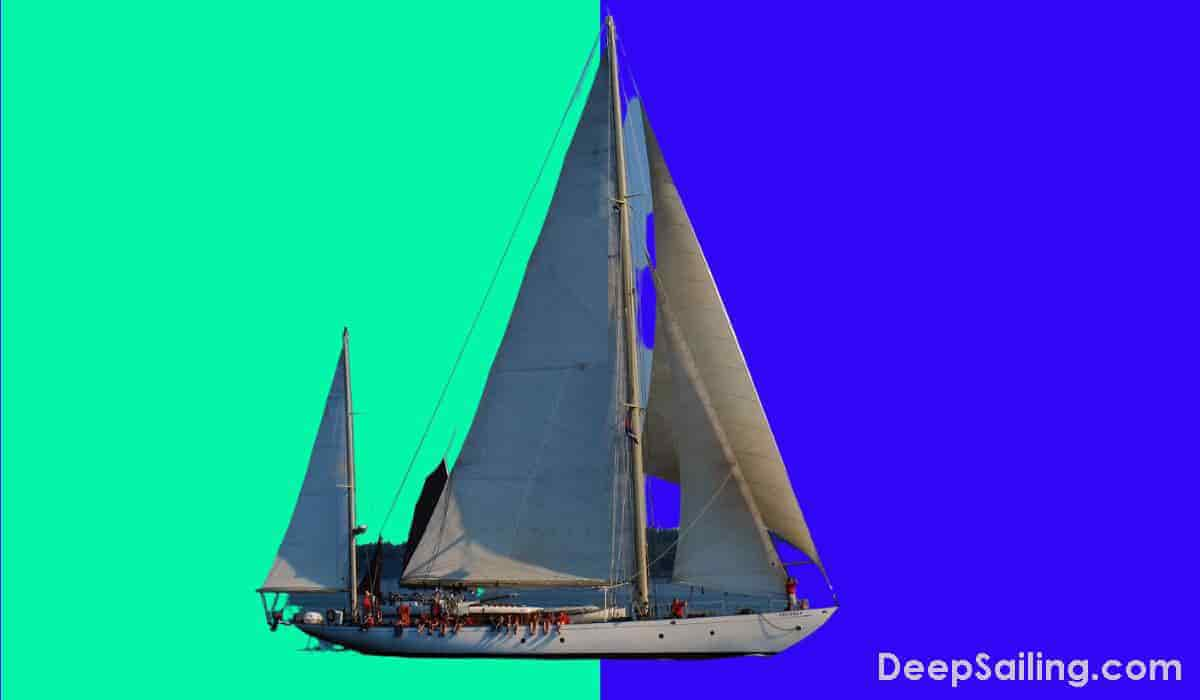
A Yawl is a sailing ship that was originally that was originally a dutch ship nicknamed " Dandy " or " Jol " in Dutch built in the 19th century with a speed range from 10-14 knots, an average crew size of 25 people and a ship size ranging from 30ft to 75ft in length with beam sizes ranging from 10ft to 12ft.
They bore two fully-equipped masts and a fore-and-aft sail, a smaller jigger-mast and a mizzen mast that leans towards the rudder post of the ship with the mizzen sail in this case purposely designed to aid in balancing and trimming the ship on rough waters.
One famous yawl sailing ship is the Islander which was a 34ft yawl that Harry Pidgeon sailed around the world on. He was the second person in 1918 to sail around the world at that time.
13. The Brig
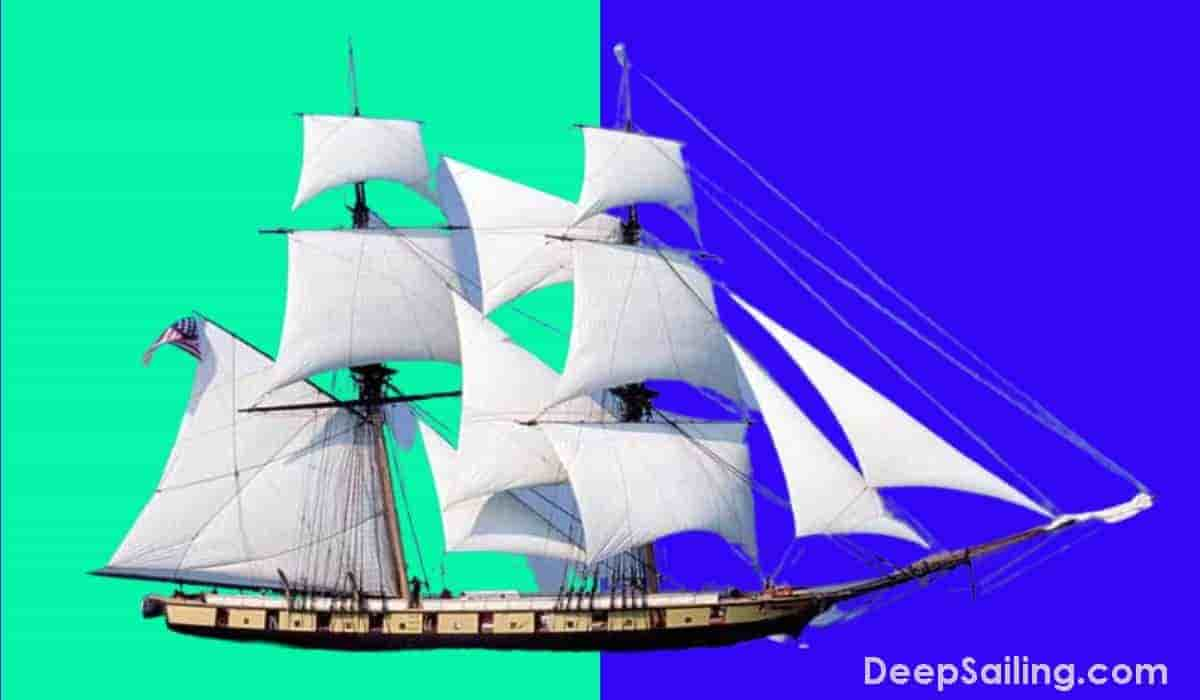
The brig is a two-masted sailing ship that was originally built in the 18th century with square rigging on both masts and sometimes had a spanker on the aft mast.
The length of a brig varied from 75ft to 165ft with tonnages up to 480 ith tonnages up to 480 and it needed a crew of 22 people ( 20 ).
The brig was used as a war vessel and a cargo ship for transporting goods and they were later used to ferry large cargo on the open seas since they could easily follow the direction of the prevailing winds.
It came with a berthing deck that had sleeping quarters for cabin crew and marine officials, storage areas, a sail bin, a wood-paneled stove room, guns, and carronades.
They would be brought into the harbor without using tugs and could maneuver well in small areas.
Famous brig ships are listed below.
- USS Argus : This was a United States Navy brig that fought in the First Barbary War, taking part in the blockage of Tripoli and the war of 1812
- USS Reprisal : This was the first ship of the United States Navy
- USS Somers : This was a brig in the United States Navy that became infamous for being the only US Navy ship to undergo a mutiny
14. The Ketch

A ketch is a two-masted sailboat that originated in the 17th century with most ketch ships ranging from 40ft to over 120ft in size and weighing between 100 and 250 tons. A ketch ship needed a smaller crew of only 4 people to operate ( 21 ).
The ketch looked just like the Yawl and as stated had two masts each having a fore-and-aft rig with the difference between the two being that the ketch had a mizzen mast placed on the taller mainmast but at a position in front of the rudder post. The mizzen in this case aided in maneuvering the vessel.
A ketch ship was used for:
- Cargo Transportation
15. The Hulk
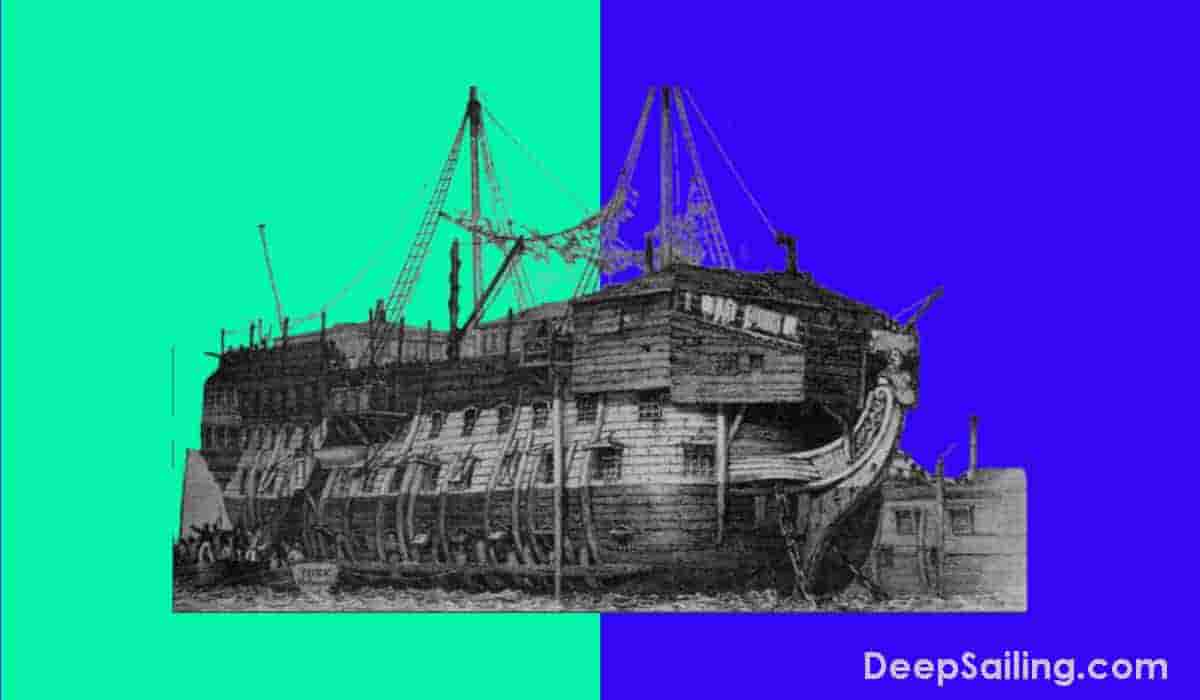
A hulk is an 18th-century ship that is a derivative of the Carrack with a weight of 400 tons that is afloat but incapable of going to sea. In maritime terms, the name "Hulk" was given to ships that were outdated, stripped down or unprofitable to run.
The bulk of the hulk fleet was comprised of abandoned ships, stripped down and therefore could not continue to ply across the Mediterranean Sea as cargo or transport ships.
They are stationary and kept for their buoyancy and were used as a prison, a place for gambling.
- Maritime Museum Of The Atlantic. " Sailing Ship Rigs ".
- The New York Times. " America's Cup Held Here Since 1851 ", PDF.
- World History Encyclopedia. " Carrack Definition ," Paragraph 3.
- Same As Reference 3
- Military History. " Carracks, Famous Carracks ," Paragraph 9.
- " Aken, tjalken en kraken " by Hans Haalmeijer & Dirk Adrianus Vuik, Page 12.
- Google Books Ngram Viewer. " Brigantine ".
- Gaspee Info. " Brigentines Described ," Paragraph 3.
- Wikipedia. " Barquentine ," Paragraph 1.
- " Ship: 5000 Years Of Maritime Adventure " by Brian Lavery, Page 137.
- Oxford English Dictionary (Online Edition). " Barque ".
- University of Houston. " No. 338 Clipper Ship ". Paragraph 2
- Marine Insights. " Windjammer Sailing Ships: From Past to Present ". Paragraph 8
- History Today. " Dutch Shipbuilding in the Golden Age ". Volume 34, No. 1
- " The Story Of The Sea, Volume 1 " by Arthur Quiller-Couch, Page 20.
- Whaling Museum. " Rigs Of Vessel, Ship ," Paragraph 1.
- " A Dictionary of Sea Terms " by Anstead, A, Page 96.
- Britannia. " Cutter, Sailing Craft ". Paragraph 1.
- " The Boats Of Men Of War " by William May & Simon Stephens
- Texas Navy Association. " Glossary Of Nautical Terms ". Page 1
- National Museum Of American History. " Ship Model, Ketch ". Paragraph 1

The global authority in superyachting
- NEWSLETTERS
- Yachts Home
- The Superyacht Directory
- Yacht Reports
- Brokerage News
- The largest yachts in the world
- The Register
- Yacht Advice
- Yacht Design
- 12m to 24m yachts
- Monaco Yacht Show
- Builder Directory
- Designer Directory
- Interior Design Directory
- Naval Architect Directory
- Yachts for sale home
- Motor yachts
- Sailing yachts
- Explorer yachts
- Classic yachts
- Sale Broker Directory
- Charter Home
- Yachts for Charter
- Charter Destinations
- Charter Broker Directory
- Destinations Home
- Mediterranean
- South Pacific
- Rest of the World
- Boat Life Home
- Owners' Experiences
- Interiors Suppliers
- Owners' Club
- Captains' Club
- BOAT Showcase
- Boat Presents
- Events Home
- World Superyacht Awards
- Superyacht Design Festival
- Design and Innovation Awards
- Young Designer of the Year Award
- Artistry and Craft Awards
- Explorer Yachts Summit
- Ocean Talks
- The Ocean Awards
- BOAT Connect
- Between the bays
- Golf Invitational
- Boat Pro Home
- Superyacht Insight
- Global Order Book
- Premium Content
- Product Features
- Testimonials
- Pricing Plan
- Tenders & Equipment
Sailing Yachts For Sale
While they may be far outnumbered by their motor yacht peers, sailing yachts are unique in terms of regatta capabilities and eco-friendly performance. Most buyers of a sailing yacht for sale wouldn’t swap their bluewater cruisers or regatta winners for anything. After all, there's nothing quite like sipping ice-cold mojitos to the soundtrack of a sail flapping gently overhead.
That's why we have invited a mix of some of the most elegant, traditional, modern and enjoyable sailing yachts for sale to be showcased on BOAT – to help those aspiring owners to find their perfect match. Owning a sailing yacht comes with numerous benefits, freedom and flexibility to set sail whenever and wherever. Plus, the eco-friendly credentials never go out-of-date.
Here, we take a look at some of the standout sailing yachts for sale with BOAT International, including sailing yachts from legendary names such as Royal Huisman , Perini Navi , Nautor's Swan and Jongert .
Yacht Features
Propulsion System

History of Sailing & Boat Types

Last Updated by
Daniel Wade
June 15, 2022
A Brief History of Ships
When and where did sailing originate? The answer to that question is threaded through our entire written history. Humans have been using various forms of boats to travel by water for longer than we have had written language. The oldest known reference to a ship was from approximately 10,000 BCE, where a carving depicted a reed rowing ship that carried twenty men. Experts believe that boats were around a lot longer than that though so far, there has been no physical proof. Ship travel is older than any other form of transportation and has been steadily improving over the millennia.
It has been determined that the first sea-worthy ships were not even built by humans but by their evolutionary predecessors, Homo Erectus, nearly 800,000 years ago. This explains how they were able to spread across the planet. The mega sailing ships and cutting edge boats of today are direct descendants of those ships built by an extinct species so long ago. It is stunning to think of how far we have come while remaining tied to the water.
Since then, ships have been made of every conceivable material, and they were used to spread people around the globe before other types of transportation like airplanes came into use. These trusty vehicles are still valued and used for warfare, commerce, and recreational sports.
They are testaments to human ingenuity and perseverance. Over the course of hundreds of thousands of years, there have been many significant changes made to the way in which boats are made, sailed, and appreciated by the general public. This article will go over the different kinds of boats, historical events, and ships of significance and also a brief glimpse of current 21st-century sailing.
Table of contents
Types of Boats and When They Originated
There have been many kinds of ships and floating transportation used throughout mankind's history. With so many years and different civilizations traveling by water to explore, trade, and wage wars, there have been a large number of boats for every conceivable purpose. As building materials improved through the ages, so have the designs of seaworthy ships.
Below is a timeline of the history of various types of boats and the advent of any significant shipping features.
Most of the earliest boats were lashed together rafts of anything that would float (e.g., reeds, bamboo, balsa, and other woods, etc.). All of these types of rafts and small boats are still in use today around the world. There is no single geographical location that can be narrowed down for when and where rafts started as a means of water transportation.
Sailing Boats
The first sailing boats recognized by historians were those used by Egyptians in 4000 BCE. They were made of reeds and traveled the Nile using masts and sails.
Invention of Planks
It was not until around 3000 BCE, the Metal Age when tools were invented that allowed for the creation of planks that could be used in boat building. Planks made it possible to construct very large ships for war and trading. The first civilizations to use these types of larger ships were the Phoenicians, Greeks, and Egyptians. Egyptians at around 2500 BCE were starting to use larger ships to travel across the ocean.
Galley Ships
A galley ship is propelled by rowing and sails. These were quite common starting in 1550 BCE until the early 19th century. Originally, they were employed most notably by the Phoenicians. War galleys were quite popular until the late 16th century, after which they began to be phased out. These ships are most known for being warships but were also used for trade and piracy. The battle of Lepanto in 1571 is history's largest naval battle involving rowing ships and involved over 400 galley ships.
Common among the Vikings, these ships also used sails and rowers but were built to be much narrower and longer. They started being constructed for long-distance travel around 1000 AD. These amazing ships were created for exploration and conquest. Made with long overlapping planks and a single large mainsail, they were easily identified and were used to travel between Scandinavia and the coasts of France, Britain, and Spain.
The Chinese junk ships employed sails reinforced with bamboo for better aerodynamics, bulkheads to separate sections, and rudders. They came into common use around 1100 AD. In 1405 and until 1433 there were many trips across the Indian Ocean made by Zheng He who worked for the Ming emperor of China. These were exceptional craft for their time. The most massive junk ship was 150 meters long and had nine different masts.
Invented in the 14th century by the Dutch, the yachts were mostly used by rich ship merchants who used these as personal celebratory vehicles. They were also used for a time by the Dutch navy.
Spanish Galleon
Unlike the galley ships that were mainly propelled forward using oars, the Spanish Galleon used enormous sails. They were so big that it took multiple people to take them in and out using thick ropes. They were used in the 16th century to transport goods to and from the Americas. These were also used by pirates and have become the iconic historical sailing ship in the media.
Steam Powered Ships
The world's first steam-powered ships were built in 1819 and were mostly used for transporting people and goods across the Atlantic Ocean.
Clipper Ships
Fast with tall masts and longboat type hulls, the Clipper boats were created in the 1800s. One of the largest, the Royal Clipper was one of the largest ships of its kind for decades, and it featured a five-masted barque.
Oceanliners
Metal ocean liners first started being used in the mid-1800s. Most of these steel-hulled ships were competing between the economic interests of the United Kingdom and Germany.
Paddle Steam Boats
Riverboats that used paddles and steam to power them up and down between river towns began to be used in the late 1800s.
Diesel Powered Ships
Around 1910 the steam-powered ships started getting converted to diesel.
Hovercrafts
The idea of a hovercraft - a boat that floated on cushions of air-filled fabric - was invented in 1955 by Christopher Cockerell.
Container Ships
Cargo ships hauling large containers were utilized starting in the 1980s, and their use and size have continued to grow in the decades since then.
Cruise Liners
Ships used specifically as get-away, recreational locations came into popularity in the 1990s, and they have been around since though their popularity has waxed and waned over the years.
Historical Sea Crossings and Events
Most of the world's continents were populated long before the invention of writing, but a few were rediscovered through sea travel. These historical sea crossings and events are responsible for some of the most important war, exploration, and trade journeys recorded throughout history.
Prior to the 15th Century
- Greenland was discovered between 980-982 by the Norse sailing explorer Erik the Red.
- Around eight years later, Erik the Red's son, Leifur, reached Newfoundland.
- The Norse continued to sail and expand their travel near Vinland by boat, including the married explorers Thorfinn Karlsefni and Gudrid Thorbjarnardóttir.
15th to 18th Century
- Christopher Columbus, starting in 1942, began several famous sea voyages that led to the discovery of the Americas.
- In 1500, Pedro Álvares Cabral sailed to Brazil.
- The Straits of Magellan are named after Ferdinand Magellan, who sailed through them from Spain to reach the South Atlantic in 1519.
- In 1563 Nicolas Barre was among a group that was the first to build ships in the Americas and sail them all the way across the Atlantic. It was a harsh journey, and only seven of their number survived.
- The first Atlantic trade route was mapped and utilized in 1566 by the West Indies fleets.
- In 1732 the Ann crossed the Atlantic from London and reached the area that is now Georgia carrying the famous James Oglethorpe.
- William Harrison sailed using the H-4 timepiece in 1764. The device on that particular voyage allowed for the creation of longitude.
19th Century
- The first steamship that sailed across the Atlantic was the SS Savannah in 1819.
- In 1865 the very first successful transatlantic telegraph cable was put in place by the SS Great Eastern.
- The Norwegians Frank Samuelsen and George Harbo were the first to row all the way across the Atlantic, and they did so in 1896.
20th Century
- In April of 1912, the RMS Titanic hit an iceberg and sank, and there was a loss of well over 1,200 lives. This is one of the most famous instances of a boat sinking and began a period during which many boats were sunk with large numbers of people on board. The increase of war and transport vessels led to many more instances with similar loss of life.
- In the years between 1914-1918 during WWI, approximately 2,100 ships sunk and 153 U-boats were destroyed.
- In WWII, 1939-1945, it was reported that roughly 3,700 ships were sunk and 783 U-boats were destroyed.
- Ann Davison, in 1952, became the first woman to sail alone across the Atlantic Ocean.
- Quite a few individuals crossed the Atlantic Ocean in the 1960s alone, but Robert Manry was the only one to do so without stopping, and he did it in 1965 using his sailboat Tinkerbelle.
- Gérard d'Aboville was the first man to row single-handedly across the Atlantic, and he did so in the year 1980.
- The first woman to single-handedly cross the Atlantic in a rowboat was Tori Murden in 1991. The entire journey took over 81 days.
Famous Ships in History
These are the ships that you have read about in history books and heard through the retelling of stories. They each played a part in creating the world that we live in today. These were all unique either due to their physical presence or a way they were used, and they are a small number of the thousands of important ships that have helped carry our species across this great globe.
Santa Maria
Originally named Marigalante, the ship sailed by Christopher Columbus was 117 feet and had three masts and a deck. It was also equipped with bombards and fire granite balls. On Dec. 25, 1492, she was run aground near Haiti. The Santa Maria was the largest of the three ships that Christopher and his crew sailed across the Atlantic Ocean. Parts of the ship are still searched for by ship-wreck hunters though pieces of what was believed to be The Santa Maria were found in the mid-2010s.
It is believed that the ship which brought the pilgrims over to Plymouth, Massachusetts, to establish the New England colony was approximately 90 feet and square-rigged. This sailing ship made its trip in 1620 bringing supplies and new settlers to the Americas from England.
U.S.S. Constitution
The warship U.S.S. Constitution was also referred to as "Old Ironsides." It is the oldest commissioned warship and was launched in 1797, and it is currently kept in Portsmouth, England. It is 204 feet and could carry around 450 crew members and 50 guns. The U.S.S. Constitution was the flagship in the Tripoli pirate war that took place in the early 1800s. There were other victories over the many years of its service that left it with the famous nickname, including the War of 1812. This vessel saw many skirmishes on the seas and remains a stalwart reminder of many wartime events.
HMS Victory
This is by far the most famous of the royal ships. It was launched in 1765 and was designed by Sir Thomas Slade. At 186 feet it was able to carry 100-guns and roughly 800 men. Although it sailed through many adventures, the HMS Victory is most known for being the flagship under the control of Admiral Horatio Nelson during the Battle of Trafalgar which took place in 1805. The ship has been partially dismantled and has been part of a museum since 1928.
RMS Titanic
Everyone knows the name Titanic. There have been books, movies, plays, and songs written about this tragedy. What had been a promising ship turned into a cautionary tale. This luxury liner was meant to cross from New York to England in 1912. It sunk early April 15th after striking an iceberg. Of the over 2,200 crew and passengers approximately 1,500 were killed. This remains one of the most tragic events of the 20th century.
This British navy ship was commissioned in 1820 and sailed all around the world. It was responsible for transporting Charles Darwin to South America among other places. During this voyage is when the naturalist developed his theory of evolution based on the species that he studied. The ship was 90 feet 4 inches and had two masts. It was intended as a naval scout and took part in other light duties. The observations that Charles Darwin made while traveling aboard the HMS Beagle changed the thread of scientific discovery.
Flying Cloud
This clipper ship had quite a history. It was 225 feet and incredibly fast. Captain Josiah Perkins Creesy set a record in 1854 for sailing from Cape Horn to San Francisco, and his speed record was not beaten for nearly 130 years. This ship is also famous for having set an early speed record for the same trip, but with the ship under the control of Josiah's wife, Eleanor Creesy.
Battleship Bismarck
This was a German battleship in WWII launched in 1939 as part of the Nazi navy. This was one of the largest class of warships made by the German army and reached a length of 792 feet, 8 inches at the waterline. It sailed for eight months during WWII and spent that time raiding allied ships in the Atlantic Ocean. In 1941 after sustaining heavy damage from allied forces, it was scuttled and sank. The wreck was later discovered in 1989 by Robert Ballard.
Sailing for Sport
Sailboats have been used for hundreds of years to break speed records around the world, and that kind of sport sailing has only increased within the last decade. This kind of pastime has evolved to the point where there are Olympic sailing classes, international sailing clubs, and even an International Sailing Federation (ISAF), which was created to make the sport safer.
The ISAF was originally called the International Yacht Racing Union (IYRU), which was created in 1907 as a way of regulating sailing rules. This allowed sailors from all over the globe to compete together since they no longer had incongruous letters of the law to follow when competing during sailing competitions. Everything from the uniform to safety precautions became standardized. In 1960 a universal set of rules was agreed upon by multiple parties, which made it easier for everyone involved in sport sailing.
There are multiple sailing disciplines that are a part of the sport today. They include but are not limited to the following.
- Match Racing
- Team Racing
- Speed Sailing
- Wave Riding
In addition, there are also several different types of courses that one might sail along during these events. These are listed below.
- Short Course Racing
- Coastal and Inshore Racing
- Offshore Racing
- Oceanic Racing
Most of these have been around for over a hundred years, and the longevity of the sport makes it attractive to a lot of new sailors because there is a rich history to become a part of and learn about. Even today, boat designers are constantly attempting to push the envelope and creating something newer and faster than any ships that have come before. That kind of drive and competition is what has allowed shipping to remain such a solid part of our species' history throughout the millennia. Sailing provides an escape for many people who are tired of a digitized, impersonal world. It is a way to connect back with nature and our own past.
Modern Era Sailing
The 'age of sail' was from 1571 to 1862, when the majority of all ships were masted vessels. In the last several hundred years, ship sailing has taken on a more recreational aspect. With the advent of airplanes, there was a much faster and safer way to travel across the oceans. That being said, they are still used for war and commerce. However, for the most part, sailing boats are relegated to sports and transportation while heavier motored ships with no need for sails have taken over most of the cross-Atlantic duties.
While most sailing is done on light craft close to the shoreline, there are still plenty of adventurous skippers who spend months or even years at sea using only sails to guide them across the oceans. People stay aboard sailboats that are docked as well going out into open waters rarely but using the living space. It is eco-friendly and less expensive than renting in some areas. No matter what you are interested in there is a masted vessel that can give you what you are looking for, whether it be exploring the seas, vacationing near the continent's shoreline, or traveling for business or pleasure across the oceans.
Now that you know more about the history of these amazing watercraft, it is easier to sit back and recognize all of humankind's collective accomplishments. There are thousands of voyages that have changed the path of human evolution and created the world that we live in today. Trade routes, wars, and exploration have all played a part in creating the countries and economies that we live within. There are few things in the history of the world that have left so deep and everlasting an impact as sailing ships and other boats.
In 2020 there is an ever-growing number of personal sailing ships available to buy on the market. Sloops, dinghies, schooners, yawls, and yachts are just a few of the ships available for people to use for going out to sea with their friends and families. In a world that is constantly shrinking with the advent of ever-increasing communication technology, being able to disconnect for a while and feel a sense of adventure is a gift.
Related Articles
I've personally had thousands of questions about sailing and sailboats over the years. As I learn and experience sailing, and the community, I share the answers that work and make sense to me, here on Life of Sailing.
by this author
Most Recent

What Does "Sailing By The Lee" Mean?
October 3, 2023

The Best Sailing Schools And Programs: Reviews & Ratings
September 26, 2023
Important Legal Info
Lifeofsailing.com is a participant in the Amazon Services LLC Associates Program, an affiliate advertising program designed to provide a means for sites to earn advertising fees by advertising and linking to Amazon. This site also participates in other affiliate programs and is compensated for referring traffic and business to these companies.
Similar Posts

How To Choose The Right Sailing Instructor
August 16, 2023

Cost To Sail Around The World
May 16, 2023

Small Sailboat Sizes: A Complete Guide
October 30, 2022
Popular Posts

Best Liveaboard Catamaran Sailboats
December 28, 2023

Can a Novice Sail Around the World?
Elizabeth O'Malley

4 Best Electric Outboard Motors

How Long Did It Take The Vikings To Sail To England?

10 Best Sailboat Brands (And Why)
December 20, 2023

7 Best Places To Liveaboard A Sailboat
Get the best sailing content.
Top Rated Posts
Lifeofsailing.com is a participant in the Amazon Services LLC Associates Program, an affiliate advertising program designed to provide a means for sites to earn advertising fees by advertising and linking to Amazon. This site also participates in other affiliate programs and is compensated for referring traffic and business to these companies. (866) 342-SAIL
© 2024 Life of Sailing Email: [email protected] Address: 11816 Inwood Rd #3024 Dallas, TX 75244 Disclaimer Privacy Policy
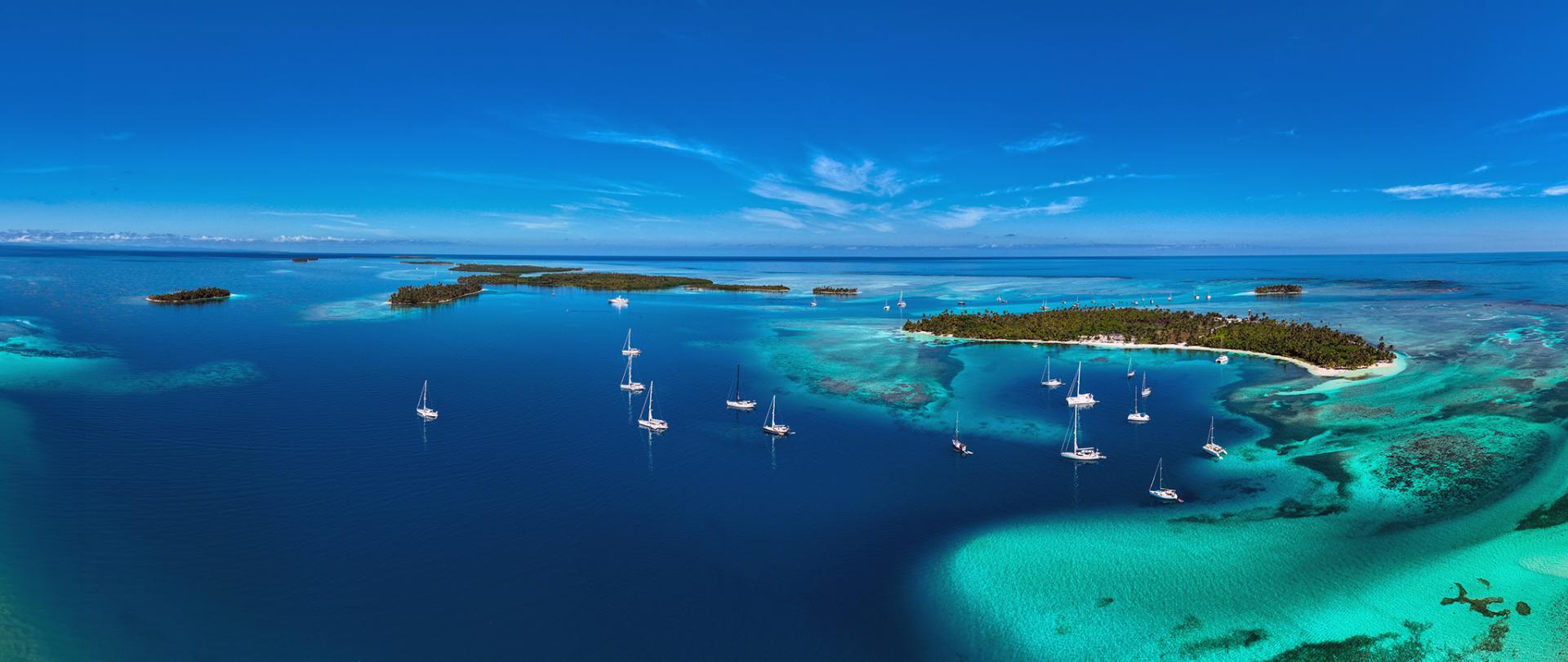
Entries open for the Oyster World Rally 2028-29. Embark on the sailing adventure of a lifetime
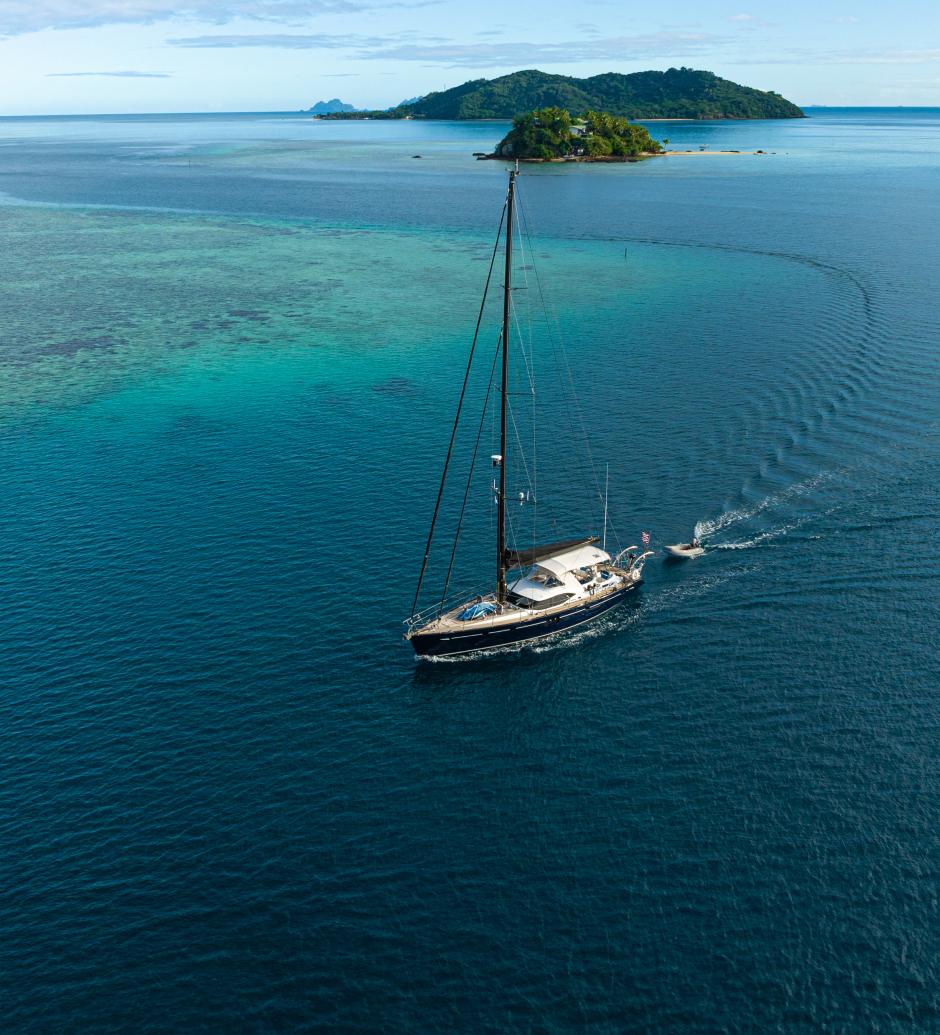
RALLY Q&A
Join us on 5 June 2024 for a live Q&A about sailing around the world on the Oyster World Rally

BUILDING MY OYSTER
Red Bull Racing's Chief Technical Officer Adrian Newey builds his Oyster 885
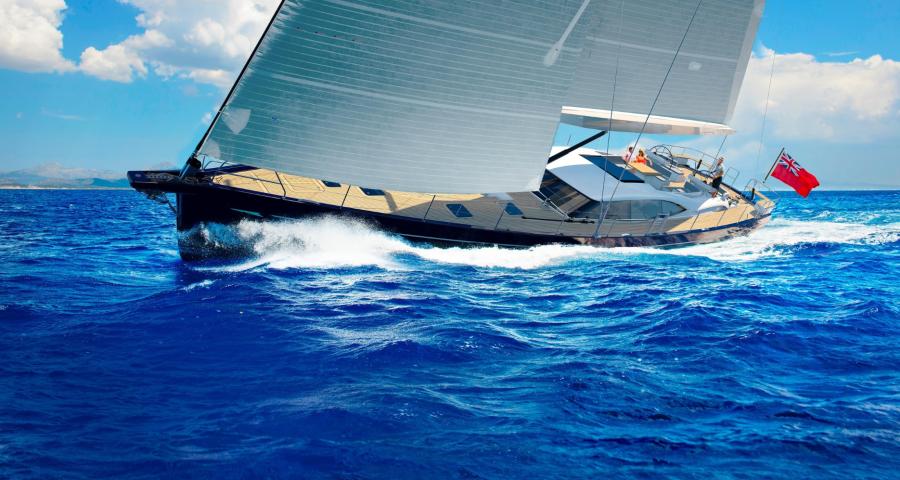
OYSTER 885SII
The Oyster 885 Series II. Experiences you will love
Oyster yachts.
Explore our award-winning, rally-proven fleet of luxurious bluewater sailing yachts
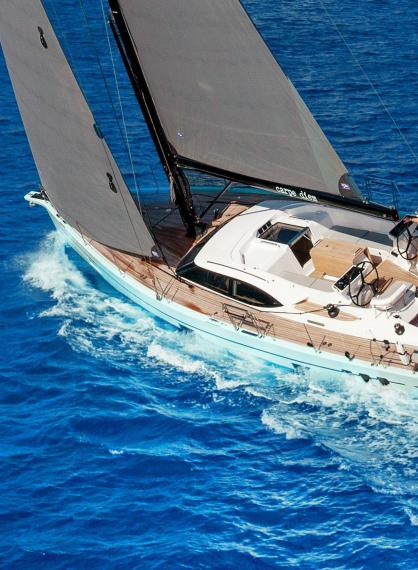
The world's finest bluewater yachts
The DNA of our 50ft to 90ft ocean cruising yachts is rooted in over 20 million bluewater sailing miles and more than 100 sailing circumnavigations. We use this experience to refine our explorer sailing yachts so they are capable of taking you anywhere in the world in complete luxury, comfort and safety.
Our luxury sailboats are the ultimate hybrid adventure machines, offering owners life-enhancing experiences. Safe, well-provisioned and hand-crafted with exceptional materials, each Oyster liveaboard yacht for sale displays an unparalleled attention to detail and the outstanding skills of our British master craftsmen and women. We are committed to building something great that nurtures the passion of the Oyster family in ways that are always beyond expectation. As a result, Oysters are renowned the world over as the finest luxury sailing yachts for sale. On an Oyster, the world is yours.
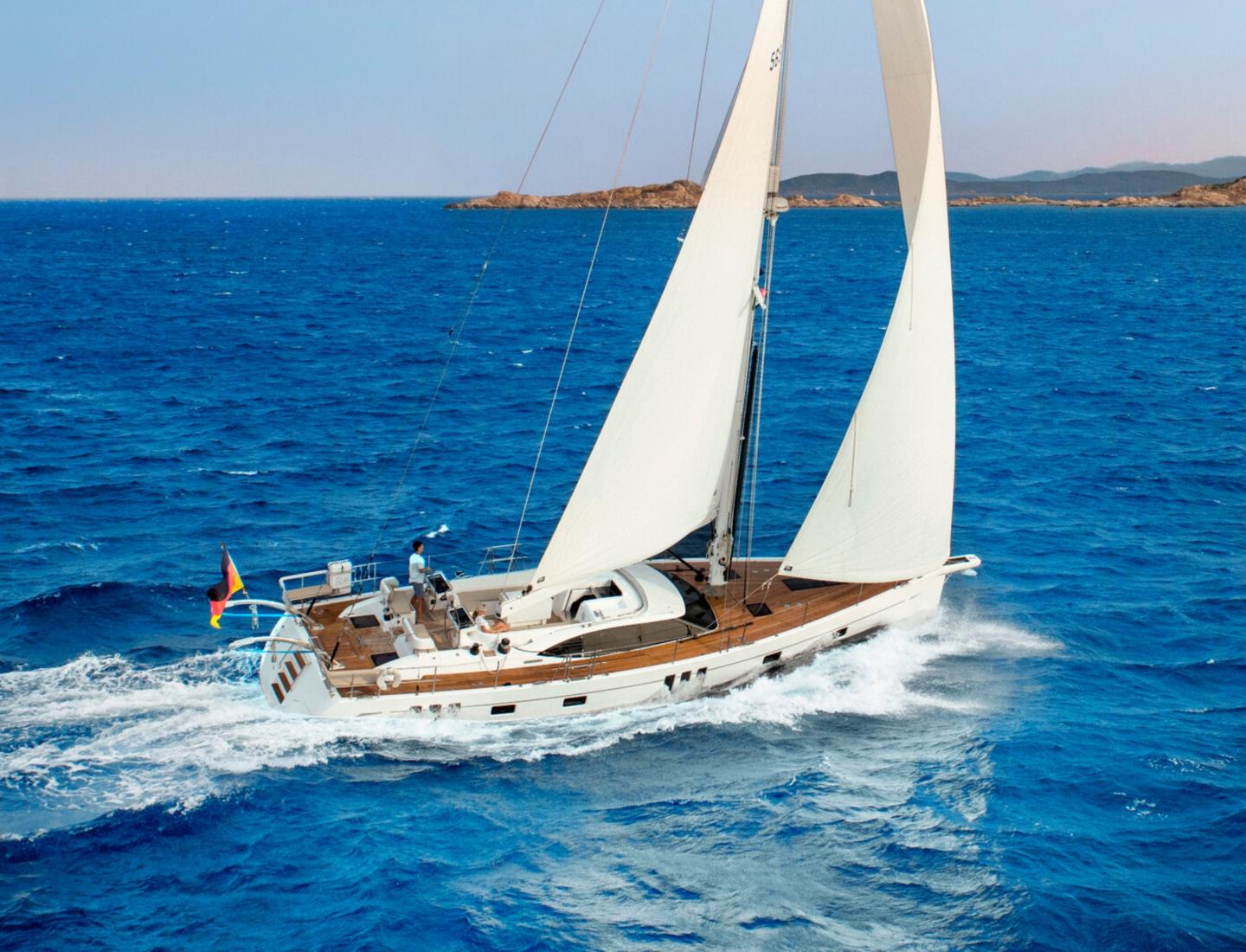
The Oyster World Rally 2028-29.
This is the sailing adventure of a lifetime: an enriching voyage of discovery, of magnificent experiences and exhilarating ocean crossings on the world’s finest luxury bluewater sailing yachts.
RALLY INFORMATION
Discover what sets the Oyster World Rally apart
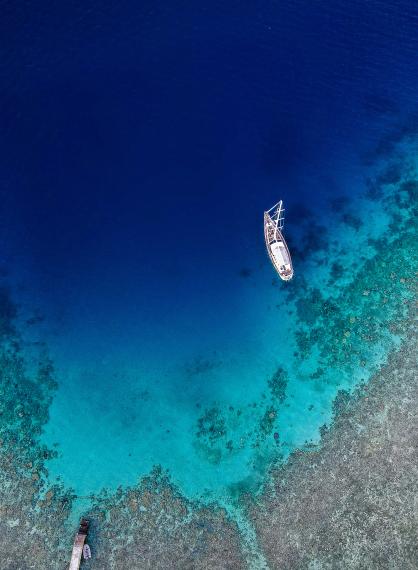
Effortless adventure
Embark on the Oyster World Rally, the sailing adventure of a lifetime
The latest from Oyster
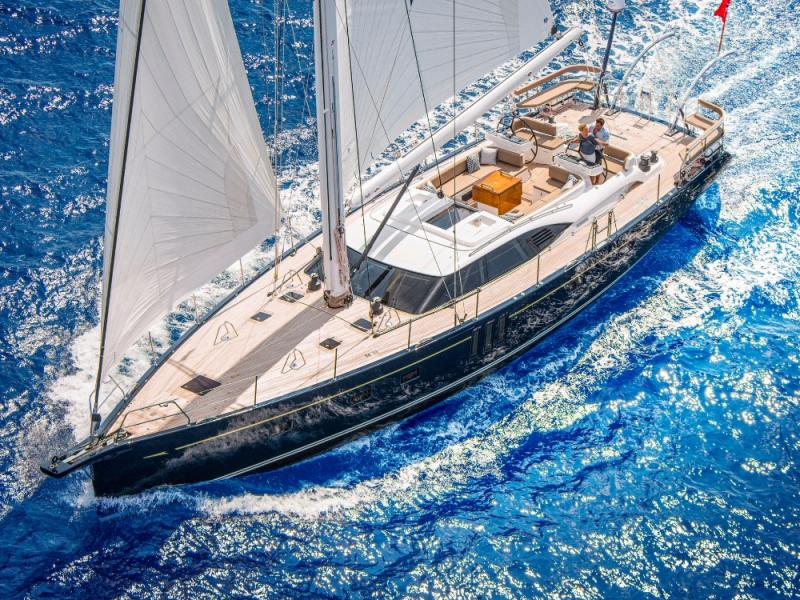
OYSTER SERVICES
Discover world-class services and customer support

Sign up to our newsletter
Be the first to hear about new launches, exclusive events and all things Oyster
© 2024 OYSTER YACHTS
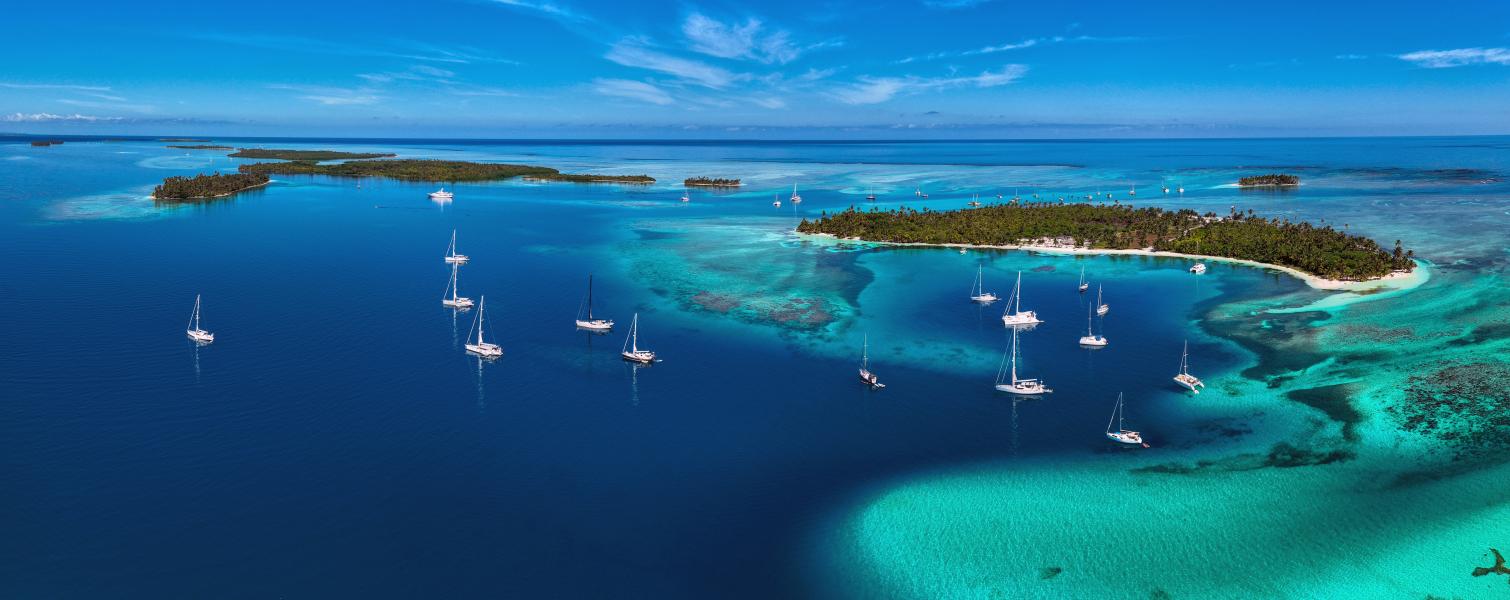
OYSTER WORLD RALLY
The Oyster World Rally 2028-29. Embark on the sailing adventure of a lifetime. Entries open 18 June 2024
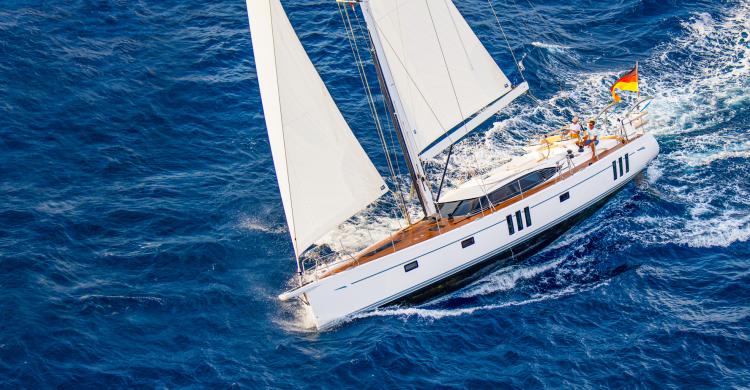
The new 565 Series II
The pursuit of perfection continues
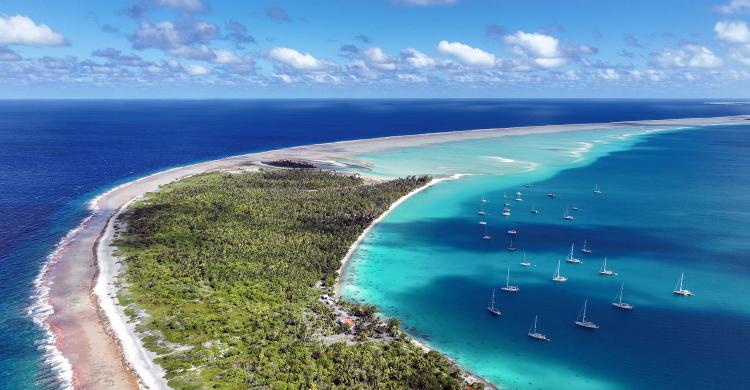
Experience the sailing adventure of a lifetime in real-time. The Oyster World Rally 2024-25
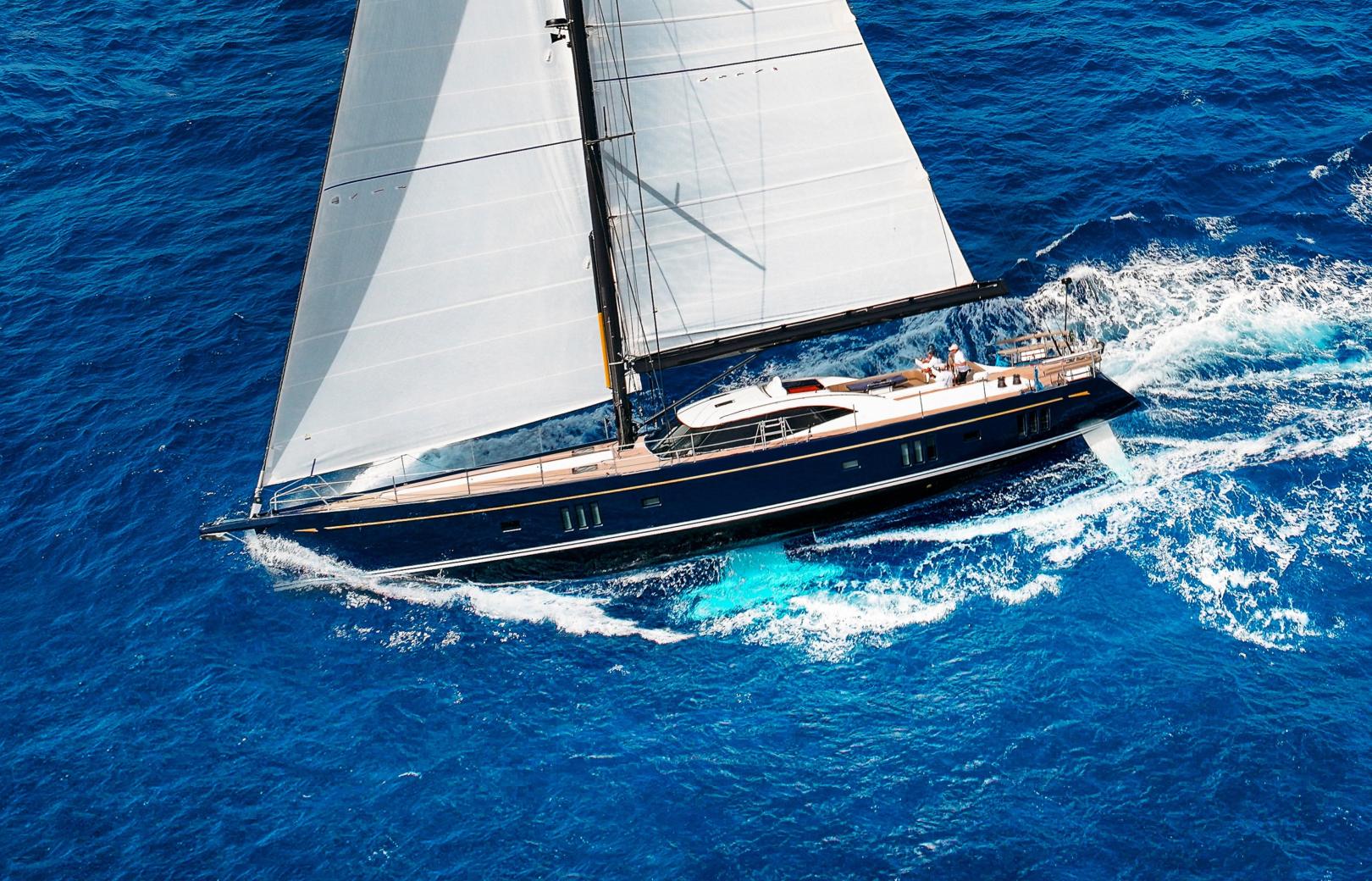
GRAND TOURING
Elaine bunting reviews the new oyster 885gt.
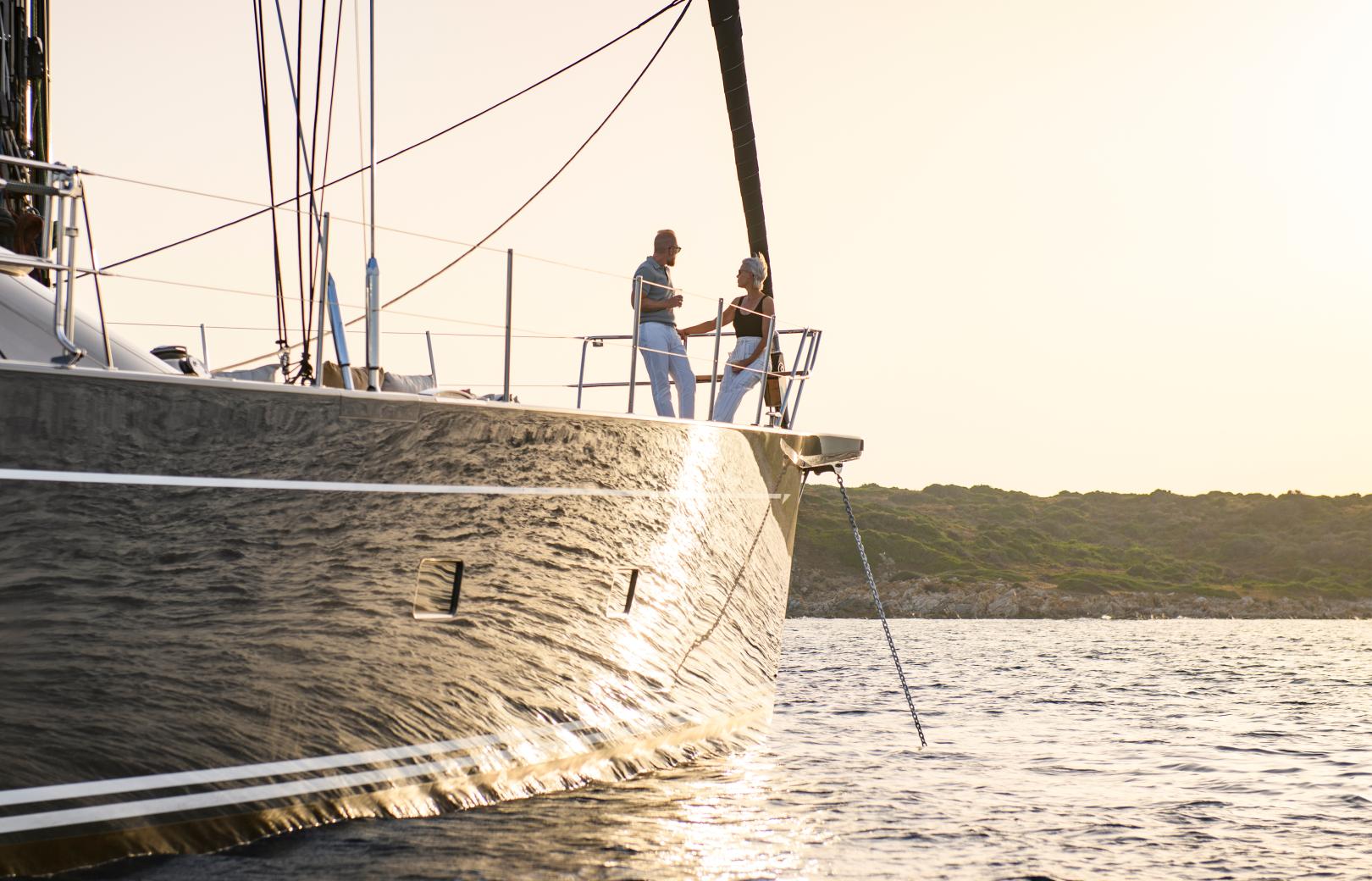
LUXURY CHARTER
Experience exhilarating sailing, luxury and style on an oyster charter. personal, exclusive and uniquely oyster.
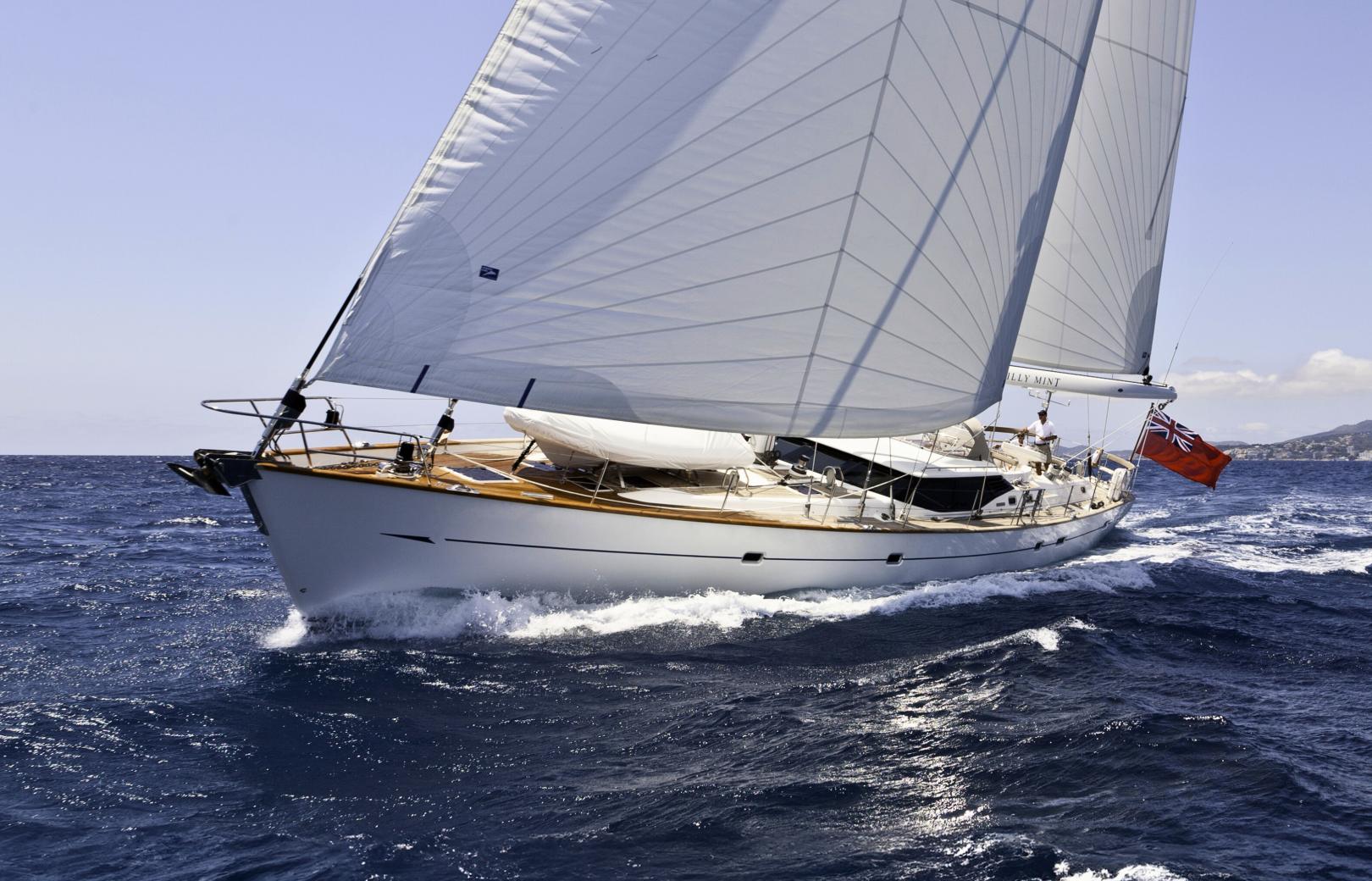
EXPERT OPINION
Hear from industry experts, owners and captains about their experience with the oyster 82.
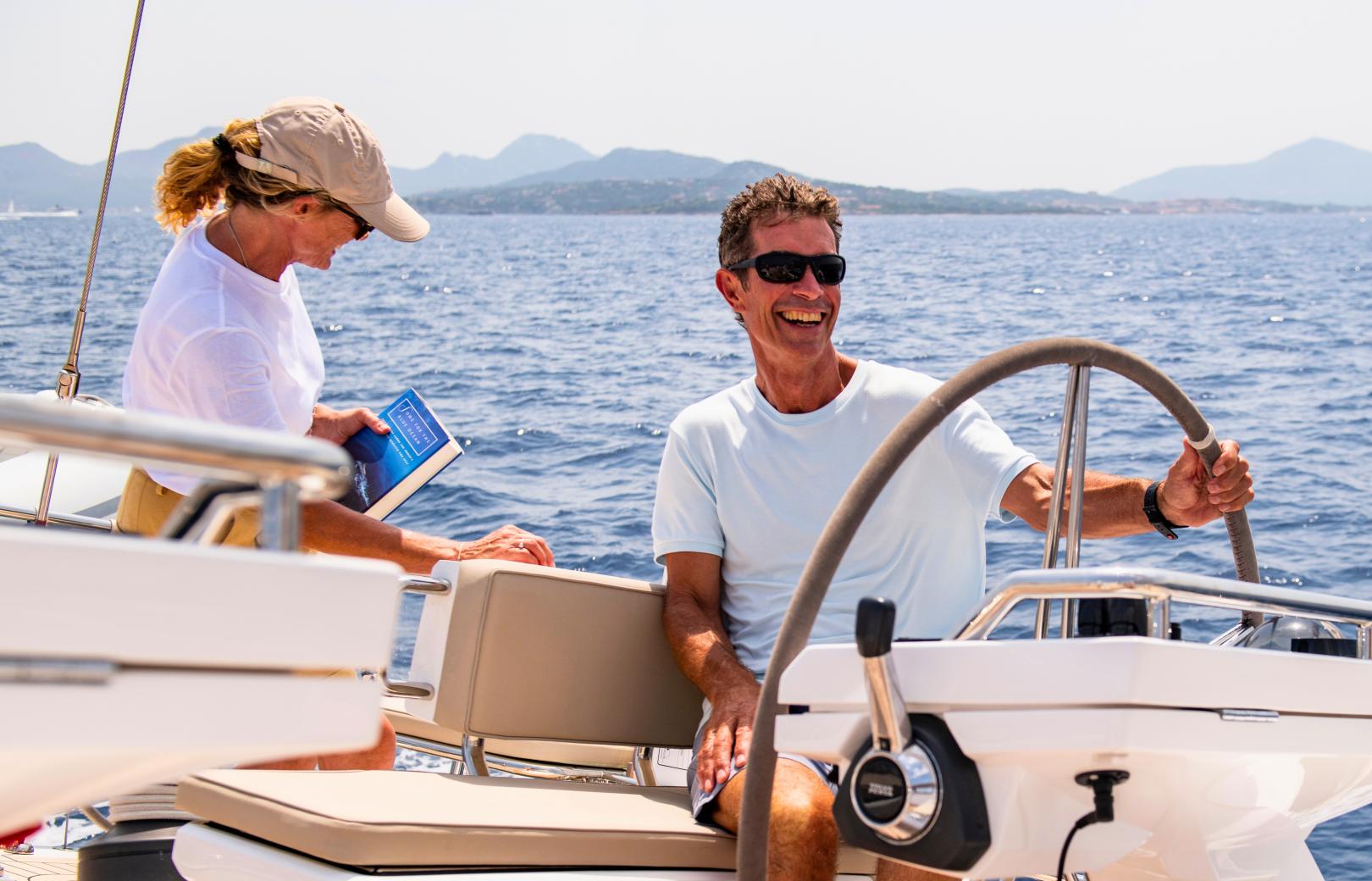
oyster ownership
Personalised care, unforgettable experiences and lifelong yacht support, oyster world rally.
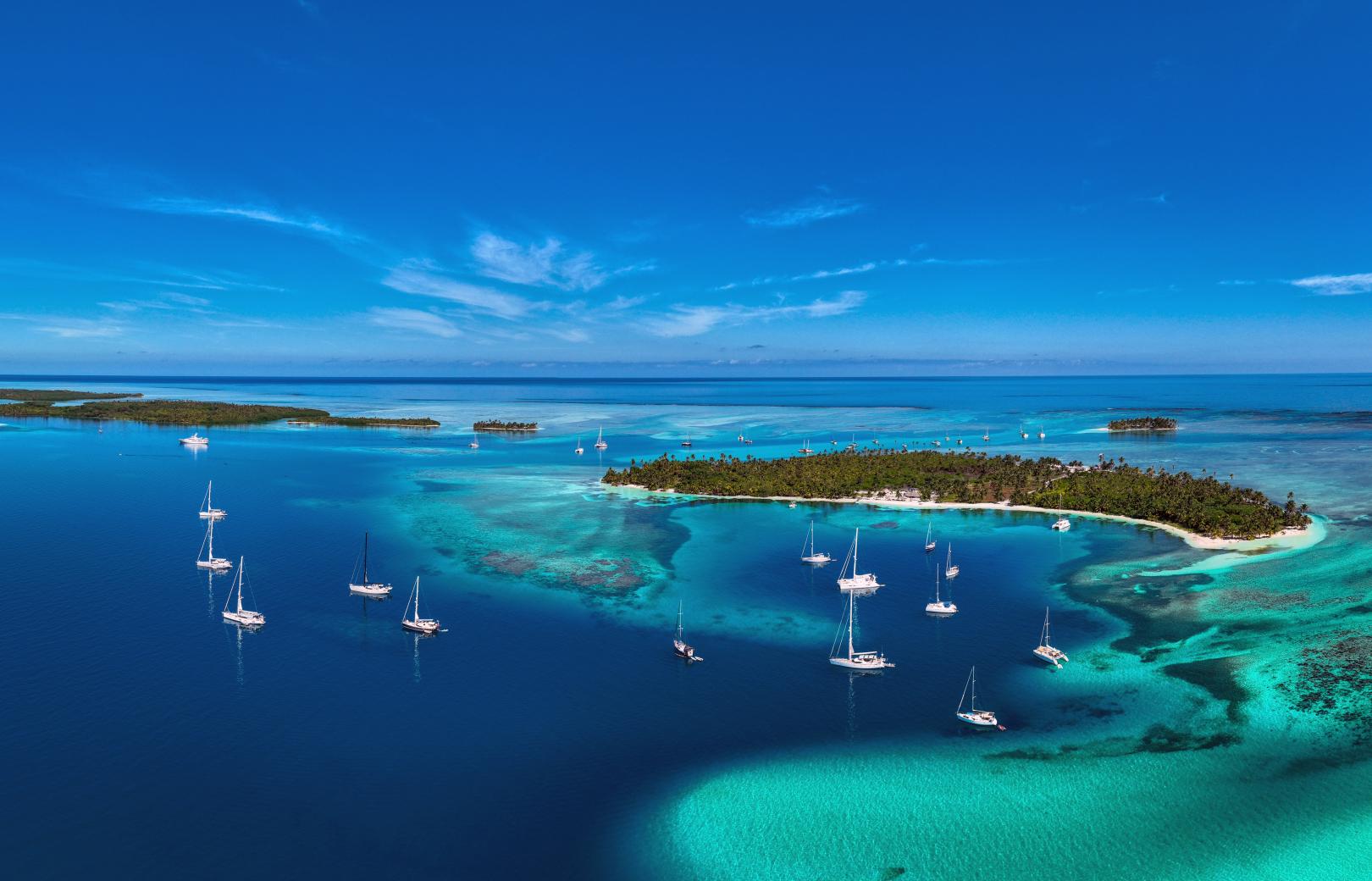

Follow the Oyster World Rally 2024-25 fleet live
Winner of European Yacht of the Year 2023. She sets a new 50 foot bluewater benchmark, offering a stunning combination of sailing performance, comfort, safety and luxurious living space.
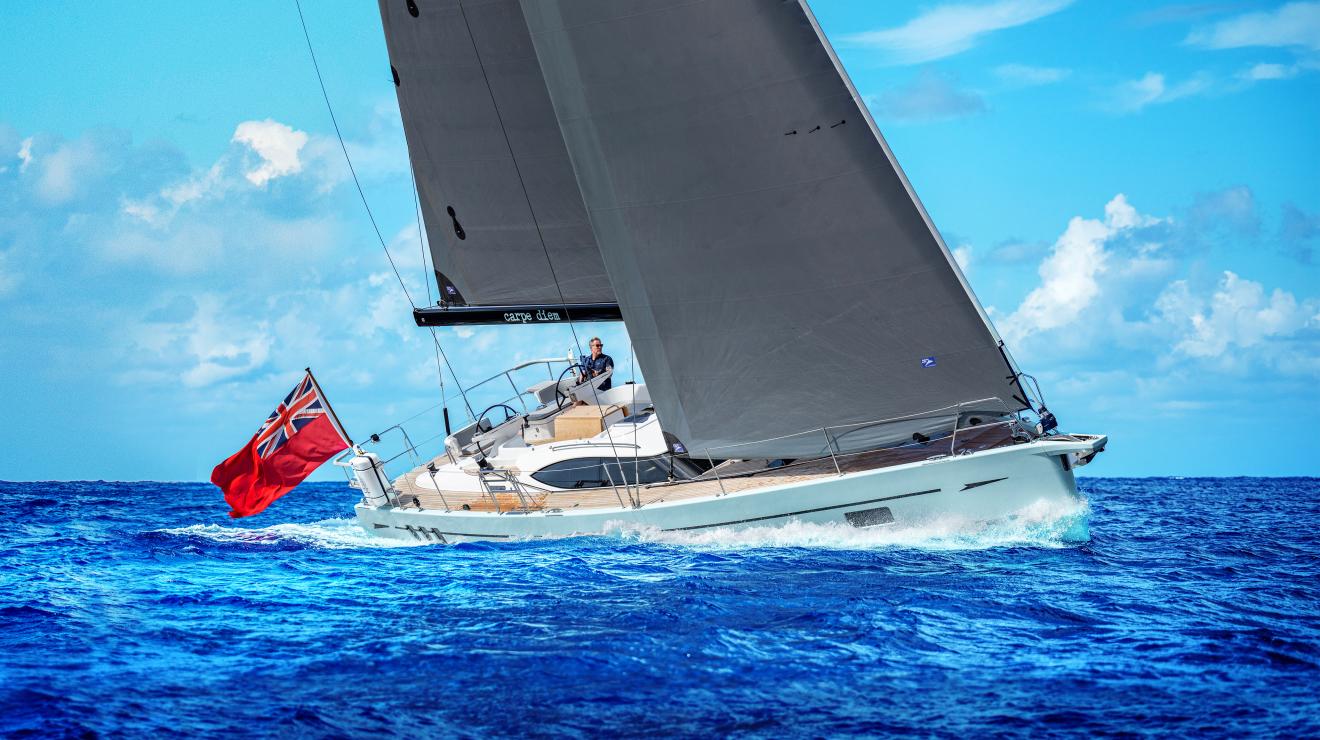
Heralding a new generation of Oysters, this 60 foot bluewater cruiser is a sailing yacht for all oceans. Practical and well-provisioned for long distance sailing or cruising in coastal waters.
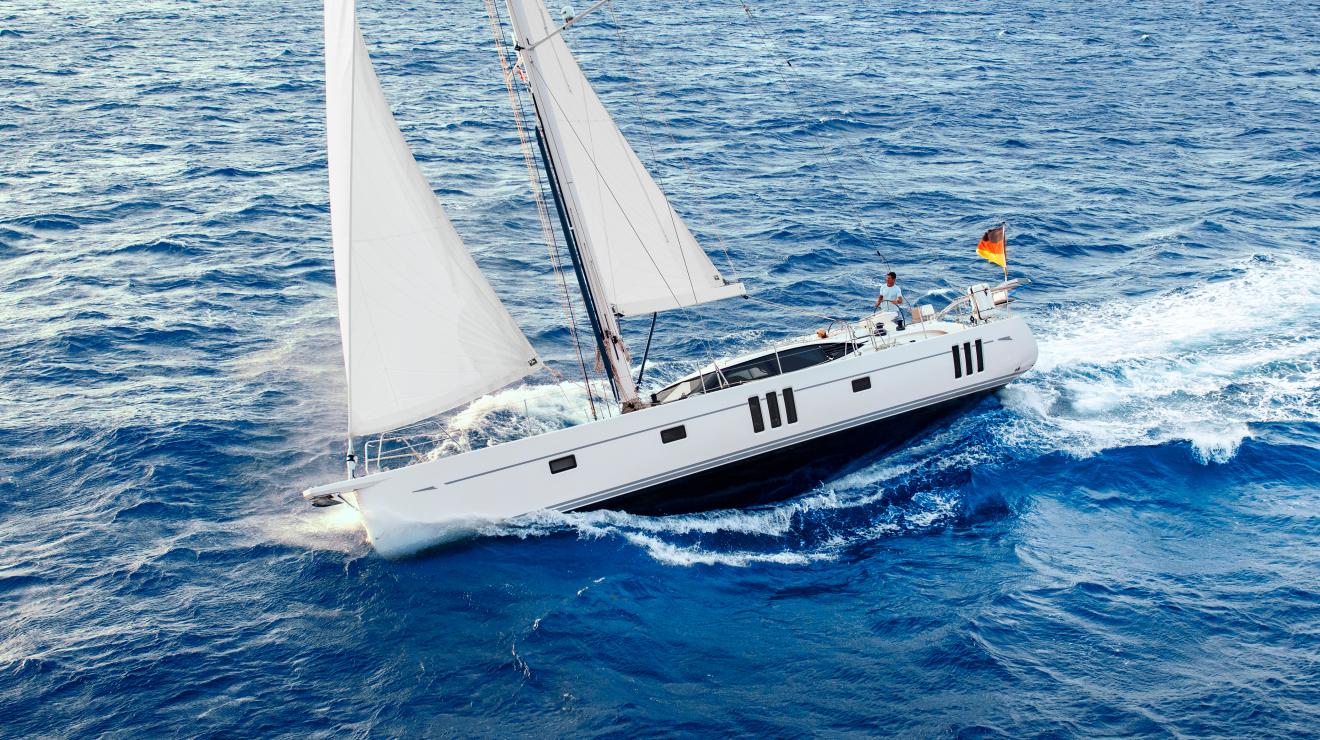
The much-anticipated Oyster 595 is well-proportioned and extremely versatile. Offering exciting, customised build options with no compromise, she is capable of great things.
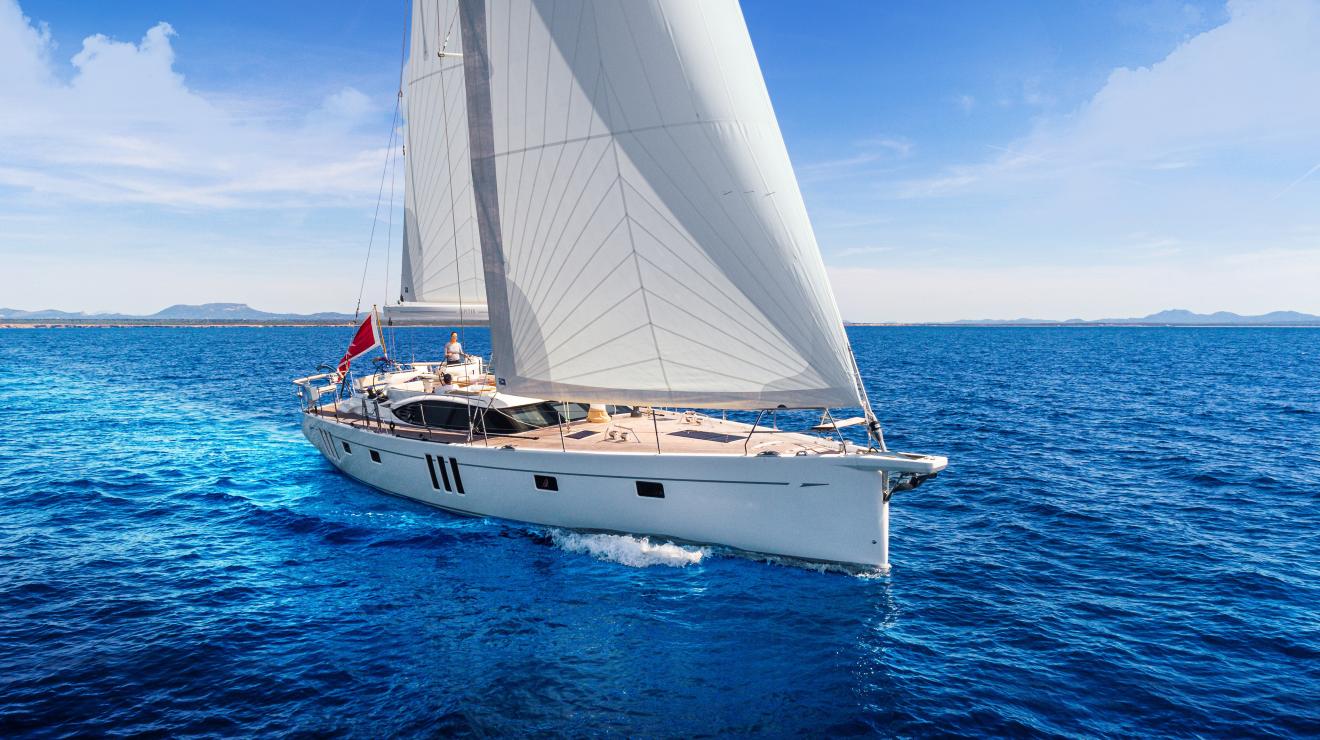
A versatile sub-70 foot sailboat offering the perfect balance of size and practicality. She can be sailed shorthanded effortlessly or take a full crew and up to eight friends and family.
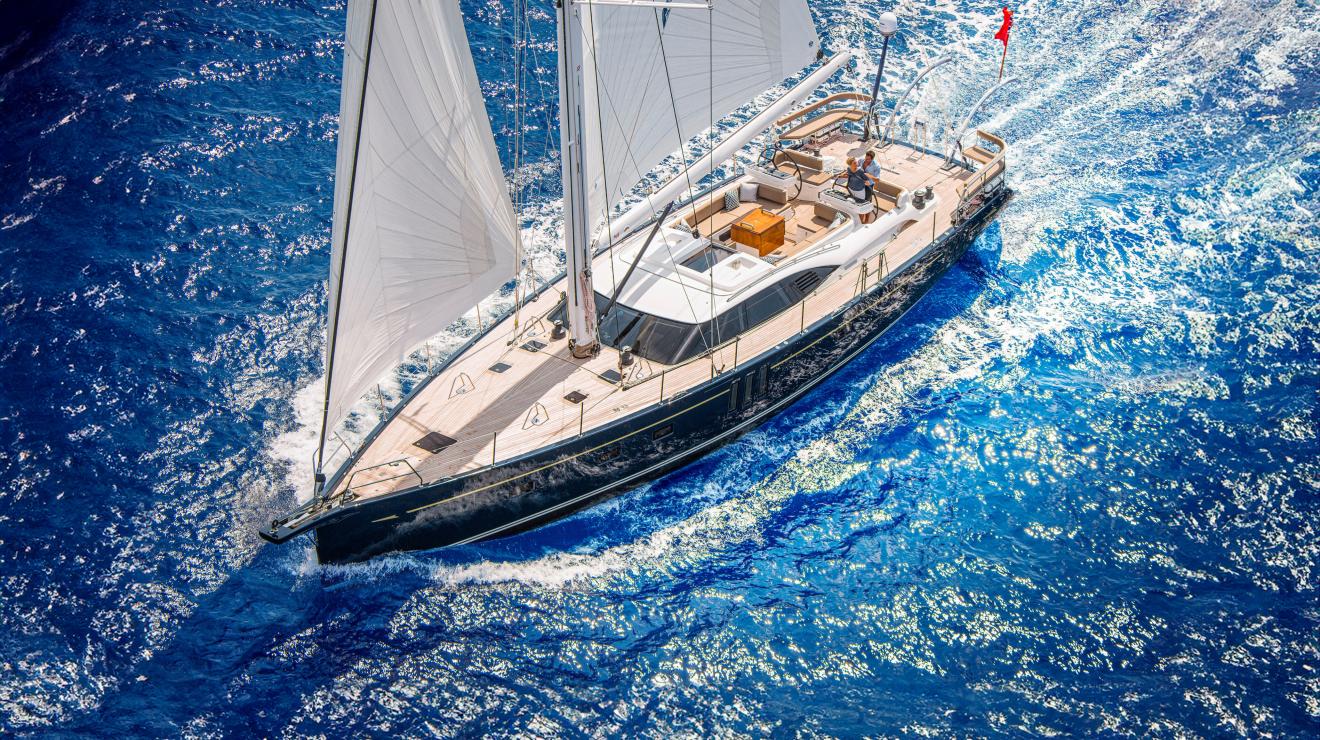
This long range 75 foot cruising yacht is designed for very big adventures. A joy to sail yourself, she also boasts dedicated crew quarters.
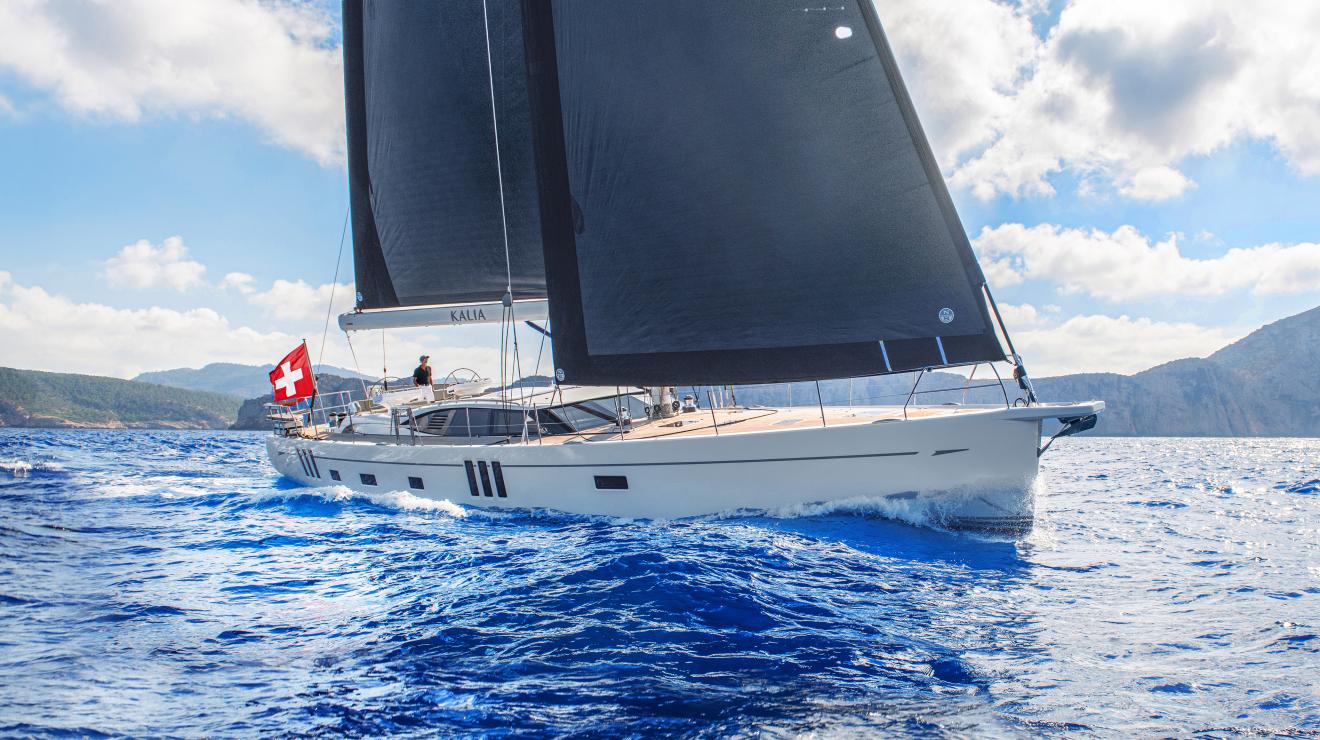
Oyster 885SII
An exhilarating 90 foot sailing yacht, delivering comfort and safety with uncompromising performance. She is capable of taking you anywhere in the world effortlessly, in luxury and style.
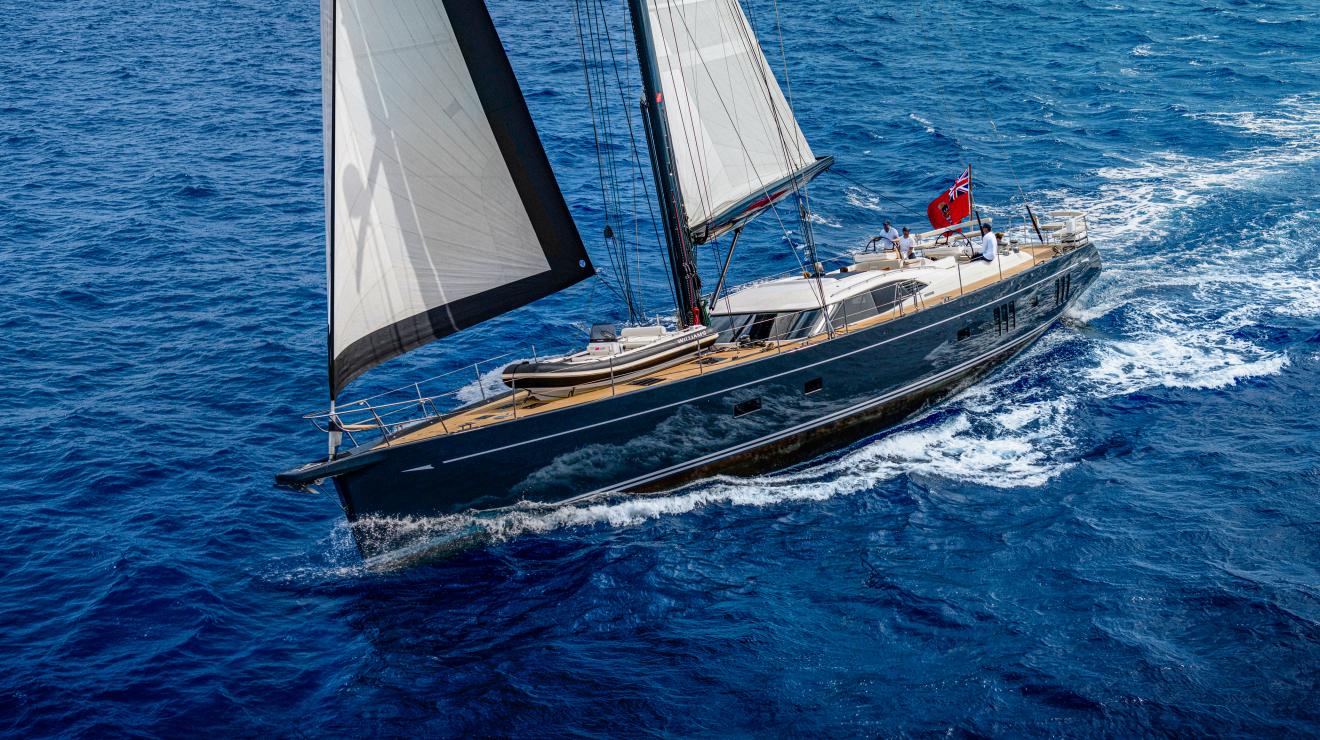
First name *
Last name *
Phone number *
Country/Region *
Attach CV *
Attach covering letter
Current occupation
LinkedIn profile
Guide to Understanding Sail Rig Types (with Pictures)
There are a lot of different sail rig types and it can be difficult to remember what's what. So I've come up with a system. Let me explain it in this article.
What are the different types of sail rig? The sail rig is determined by the number of masts and the layout and shape of sails. Most modern ships are fore-and-aft rigged, while old ships are square-rigged. Rigs with one mast are sloops and cutters. Ketches, yawls, brigs, and schooners have two masts. Barques have three masts. Rigs can contain up to seven masts.
'Yeah, that's a gaff brig, and that a Bermuda cutter' - If you don't know what this means (neither did I) and want to know what to call a two-masted ship with a square-rigged mainsail, this article is definitely for you.
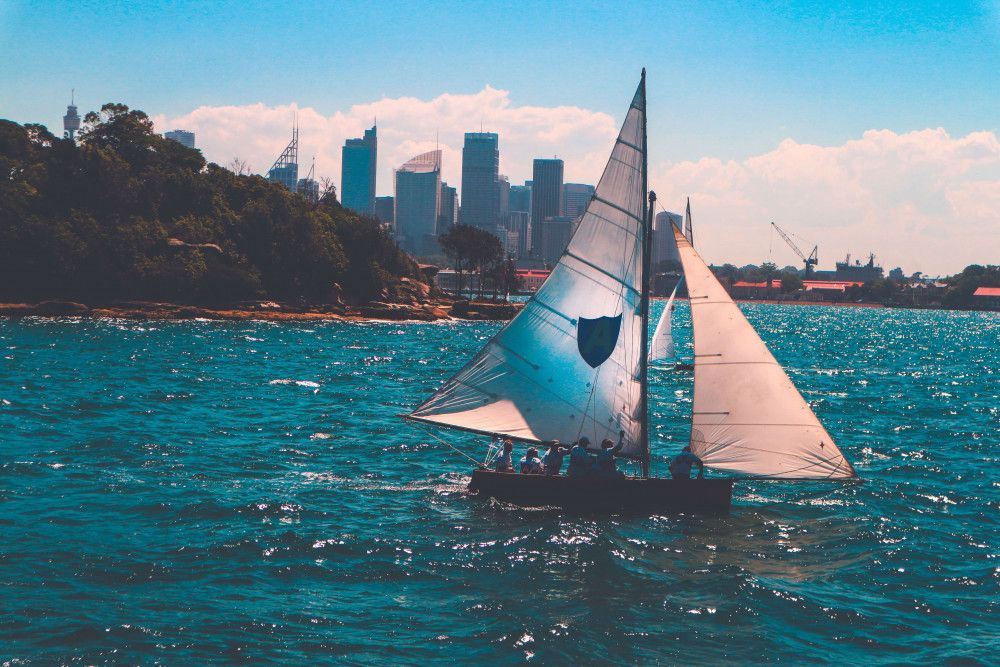
On this page:
More info on sail rig types, mast configurations and rig types, rigs with one mast, rigs with two masts, rigs with three masts, related questions.
This article is part 2 of my series on sails and rig types. Part 1 is all about the different types of sails. If you want to know everything there is to know about sails once and for all, I really recommend you read it. It gives a good overview of sail types and is easy to understand.
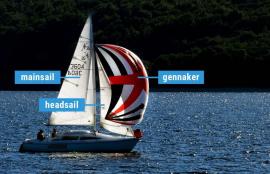
The Ultimate Guide to Sail Types and Rigs (with Pictures)
First of all, what is a sail rig? A sail rig is the way in which the sails are attached to the mast(s). In other words, it's the setup or configuration of the sailboat. The rig consists of the sail and mast hardware. The sail rig and sail type are both part of the sail plan. We usually use the sail rig type to refer to the type of boat.
Let's start by taking a look at the most commonly used modern sail rigs. Don't worry if you don't exactly understand what's going on. At the end of this article, you'll understand everything about rig types.
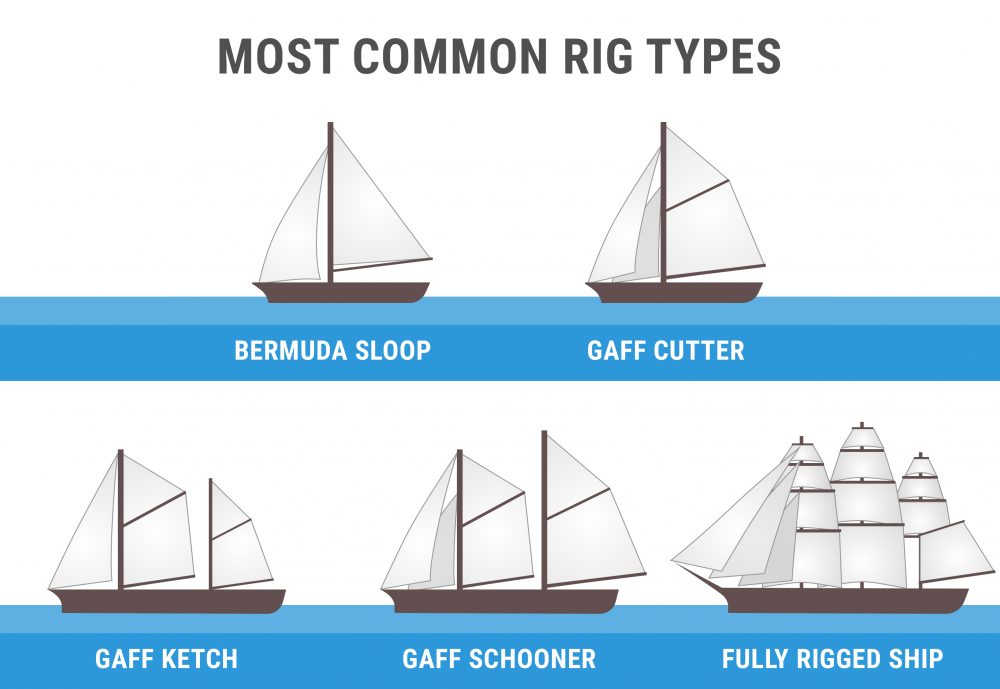
The sail rig and sail plan are often used interchangeably. When we talk of the sail rig we usually mean the sail plan . Although they are not quite the same. A sail plan is the set of drawings by the naval architect that shows the different combinations of sails and how they are set up for different weather conditions. For example a light air sail plan, storm sail plan, and the working sail plan (which is used most of the time).
So let's take a look at the three things that make up the sail plan.
The 3 things that make up the sail plan
I want to do a quick recap of my previous article. A sail plan is made up of:
- Mast configuration - refers to the number of masts and where they are placed
- Sail type - refers to the sail shape and functionality
- Rig type - refers to the way these sails are set up on your boat
I'll explore the most common rig types in detail later in this post. I've also added pictures to learn to recognize them more easily. ( Click here to skip to the section with pictures ).
How to recognize the sail plan?
So how do you know what kind of boat you're dealing with? If you want to determine what the rig type of a boat is, you need to look at these three things:
- Check the number of masts, and how they are set up.
- You look at the type of sails used (the shape of the sails, how many there are, and what functionality they have).
- And you have to determine the rig type, which means the way the sails are set up.
Below I'll explain each of these factors in more detail.
The most common rig types on sailboats
To give you an idea of the most-used sail rigs, I'll quickly summarize some sail plans below and mention the three things that make up their sail plan.
- Bermuda sloop - one mast, one mainsail, one headsail, fore-and-aft rigged
- Gaff cutter - one mast, one mainsail, two staysails, fore-and-aft rigged
- Gaff schooner - two-masted (foremast), two mainsails, staysails, fore-and-aft rigged
- Gaff ketch - two-masted (mizzen), two mainsails, staysails, fore-and-aft rigged
- Full-rigged ship or tall ship - three or more masts, mainsail on each mast, staysails, square-rigged
The first word is the shape and rigging of the mainsail. So this is the way the sail is attached to the mast. I'll go into this later on. The second word refers to the mast setup and amount of sails used.
Most sailboats are Bermuda sloops. Gaff-rigged sails are mostly found on older, classic boats. Square-rigged sails are generally not used anymore.
But first I want to discuss the three factors that make up the sail plan in more detail.
Ways to rig sails
There are basically two ways to rig sails:
- From side to side, called Square-rigged sails - the classic pirate sails
- From front to back, called Fore-and-aft rigged sails - the modern sail rig
Almost all boats are fore-and-aft rigged nowadays.
Square sails are good for running downwind, but they're pretty useless when you're on an upwind tack. These sails were used on Viking longships, for example. Their boats were quicker downwind than the boats with fore-and-aft rigged sails, but they didn't handle as well.
The Arabs first used fore-and-aft rigged sails, making them quicker in difficult wind conditions.
Quick recap from part 1: the reason most boats are fore-and-aft rigged today is the increased maneuverability of this configuration. A square-rigged ship is only good for downwind runs, but a fore-and-aft rigged ship can sail close to the wind, using the lift to move forward.
The way the sails are attached to the mast determines the shape of the sail. The square-rigged sails are always attached the same way to the mast. The fore-and-aft rig, however, has a lot of variations.
The three main sail rigs are:
- Bermuda rig - most used - has a three-sided (triangular) mainsail
- Gaff rig - has a four-sided mainsail, the head of the mainsail is guided by a gaff
- Lateen rig - has a three-sided (triangular) mainsail on a long yard
The Bermuda is the most used, the gaff is a bit old-fashioned, and the lateen rig is outdated (about a thousand years). Lateen rigs were used by the Moors. The Bermuda rig is actually based on the Lateen rig (the Dutch got inspired by the Moors).

Other rig types that are not very common anymore are:
- Junk rig - has horizontal battens to control the sail
- Settee rig - Lateen with the front corner cut off
- Crabclaw rig
Mast configuration
Okay, we know the shape of the mainsail. Now it's time to take a look at the mast configuration. The first thing is the number of masts:
- one-masted boats
- two-masted boats
- three-masted boats
- four masts or up
- full or ship-rigged boats - also called 'ships' or 'tall ships'
I've briefly mentioned the one and two mast configurations in part 1 of this article. In this part, I'll also go over the three-masted configurations, and the tall ships as well.
A boat with one mast has a straightforward configuration because there's just one mast. You can choose to carry more sails or less, but that's about it.
A boat with two masts or more gets interesting. When you add a mast, it means you have to decide where to put the extra mast: in front, or in back of the mainmast. You can also choose whether or not the extra mast will carry an extra mainsail. The placement and size of the extra mast are important in determining what kind of boat we're dealing with. So you start by locating the largest mast, which is always the mainmast.
From front to back: the first mast is called the foremast. The middle mast is called the mainmast. And the rear mast is called the mizzenmast.

What is the mizzenmast? The mizzenmast is the aft-most (rear) mast on a sailboat with three or more masts or the mast behind the mainmast on a boat with two masts. The mizzenmast carries the mizzen sail. On a two-masted boat, the mizzenmast is always (slightly) smaller than the mainmast. What is the purpose of the mizzen sail? The mizzen sail provides more sail area and flexibility in sail plan. It can be used as a big wind rudder, helping the sailor to have more control over the stern of the ship. It pushes the stern away from the wind and forces the bow in the opposite way. This may help to bring the bow into the wind when at anchor.
I always look at the number of masts first, because this is the easiest to spot. So to make this stuff more easy to understand, I've divided up the rig types based on the number of masts below.
Why would you want more masts and sail anyways?
Good question. The biggest advantage of two masts compared to one (let's say a ketch compared to a sloop), is that it allows you to use multiple smaller sails to get the same sail area. It also allows for shorter masts.
This means you reduce the stress on the rigging and the masts, which makes the ketch rig safer and less prone to wear and tear. It also doesn't capsize as quickly. So there are a couple of real advantages of a ketch rig over a sloop rig.
In the case of one mast, we look at the number of sails it carries.
Boats with one mast can have either one sail, two sails, or three or more sails.
Most single-masted boats are sloops, which means one mast with two sails (mainsail + headsail). The extra sail increases maneuverability. The mainsail gives you control over the stern, while the headsail gives you control over the bow.
Sailor tip: you steer a boat using its sails, not using its rudder.
The one-masted rigs are:
- Cat - one mast, one sail
- Sloop - one mast, two sails
- Cutter - one mast, three or more sails
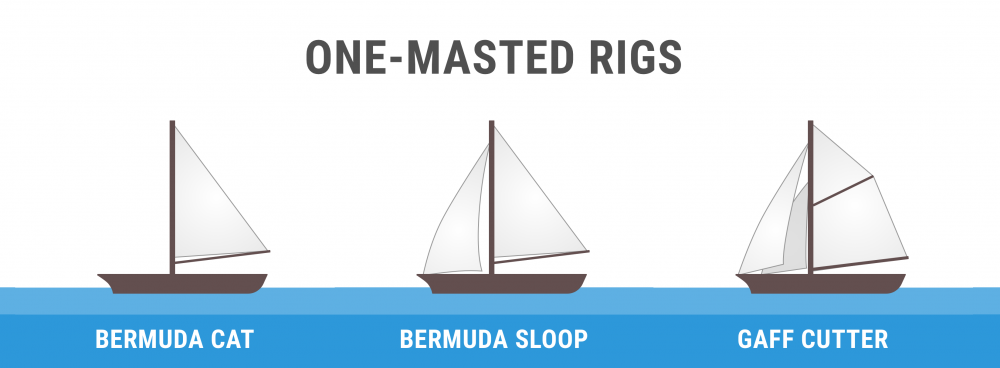
The cat is the simplest sail plan and has one mast with one sail. It's easy to handle alone, so it's very popular as a fishing boat. Most (very) small sailboats are catboats, like the Sunfish, and many Laser varieties. But it has a limited sail area and doesn't give you the control and options you have with more sails.
The most common sail plan is the sloop. It has one mast and two sails: the main and headsail. Most sloops have a Bermuda mainsail. It's one of the best racing rigs because it's able to sail very close to the wind (also called 'weatherly'). It's one of the fastest rig types for upwind sailing.
It's a simple sail plan that allows for high performance, and you can sail it short-handed. That's why most sailboats you see today are (Bermuda) sloops.
This rig is also called the Marconi rig, and it was developed by a Dutch Bermudian (or a Bermudian Dutchman) - someone from Holland who lived on Bermuda.
A cutter has three or more sails. Usually, the sail plan looks a lot like the sloop, but it has three headsails instead of one. Naval cutters can carry up to 6 sails.
Cutters have larger sail area, so they are better in light air. The partition of the sail area into more smaller sails give you more control in heavier winds as well. Cutters are considered better for bluewater sailing than sloops (although sloops will do fine also). But the additional sails just give you a bit more to play with.
Two-masted boats can have an extra mast in front or behind the mainmast. If the extra mast is behind (aft of) the mainmast, it's called a mizzenmast . If it's in front of the mainmast, it's called a foremast .
If you look at a boat with two masts and it has a foremast, it's most likely either a schooner or a brig. It's easy to recognize a foremast: the foremast is smaller than the aft mast.
If the aft mast is smaller than the front mast, it is a sail plan with a mizzenmast. That means the extra mast has been placed at the back of the boat. In this case, the front mast isn't the foremast, but the mainmast. Boats with two masts that have a mizzenmast are most likely a yawl or ketch.
The two-masted rigs are:
- Lugger - two masts (mizzen), with lugsail (a cross between gaff rig and lateen rig) on both masts
- Yawl - two masts (mizzen), fore-and-aft rigged on both masts. Main mast is much taller than mizzen. Mizzen without a mainsail.
- Ketch - two masts (mizzen), fore-and-aft rigged on both masts. Main mast with only slightly smaller mizzen. Mizzen has mainsail.
- Schooner - two masts (foremast), generally gaff rig on both masts. Main mast with only slightly smaller foremast. Sometimes build with three masts, up to seven in the age of sail.
- Bilander - two masts (foremast). Has a lateen-rigged mainsail and square-rigged sails on the foremast and topsails.
- Brig - two masts (foremast), partially square-rigged. The main mast carries small lateen-rigged sail.

The yawl has two masts that are fore-and-aft rigged and a mizzenmast. The mizzenmast is much shorter than the mainmast, and it doesn't carry a mainsail. The mizzenmast is located aft of the rudder and is mainly used to increase helm balance.
A ketch has two masts that are fore-and-aft rigged. The extra mast is a mizzenmast. It's nearly as tall as the mainmast and carries a mainsail. Usually, the mainsails of the ketch are gaff-rigged, but there are Bermuda-rigged ketches too. The mizzenmast is located in front of the rudder instead of aft, as on the yawl.
The function of the ketch's mizzen sail is different from that of the yawl. It's actually used to drive the boat forward, and the mizzen sail, together with the headsail, are sufficient to sail the ketch. The mizzen sail on a yawl can't really drive the boat forward.
Schooners have two masts that are fore-and-aft rigged. The extra mast is a foremast which is generally smaller than the mainmast, but it does carry a mainsail. Schooners are also built with a lot more masts, up to seven (not anymore). The schooner's mainsails are generally gaff-rigged.
The schooner is easy to sail but not very fast. It handles easier than a sloop, except for upwind, and it's only because of better technology that sloops are now more popular than the schooner.
The brig has two masts. The foremast is always square-rigged. The mainmast can be square-rigged or is partially square-rigged. Some brigs carry a lateen mainsail on the mainmast, with square-rigged topsails.
Some variations on the brig are:
Brigantine - two masts (foremast), partially square-rigged. Mainmast carries no square-rigged mainsail.
Hermaphrodite brig - also called half brig or schooner brig. Has two masts (foremast), partially square-rigged. Mainmast carries a gaff rig mainsail and topsail, making it half schooner.
Three-masted boats are mostly barques or schooners. Sometimes sail plans with two masts are used with more masts.
The three-masted rigs are:
- Barque - three masts, fore, and mainmast are square-rigged, the mizzenmast is usually gaff-rigged. All masts carry mainsail.
- Barquentine - three masts, foremast is square-rigged, the main and mizzenmast are fore-and-aft rigged. Also called the schooner barque.
- Polacca - three masts, foremast is square-rigged, the main and mizzenmast are lateen-rigged.
- Xebec - three masts, all masts are lateen-rigged.

A barque has three or four masts. The fore and mainmast are square-rigged, and the mizzen fore-and-aft, usually gaff-rigged. Carries a mainsail on each mast, but the mainsail shape differs per mast (square or gaff). Barques were built with up to five masts. Four-masted barques were quite common.
Barques were a good alternative to full-rigged ships because they require a lot fewer sailors. But they were also slower. Very popular rig for ocean crossings, so a great rig for merchants who travel long distances and don't want 30 - 50 sailors to run their ship.
Barquentine
The barquentine usually has three masts. The foremast is square-rigged and the main and mizzenmast fore-and-aft. The rear masts are usually gaff-rigged.
Faster than a barque or a schooner, but the performance is worse than both.
The polacca or polacre rig has three masts with a square-rigged foremast. The main and mizzenmast are lateen-rigged. Beautiful boat to see. Polacca literally means 'Polish' (it's Italian). It was a popular rig type in the Mediterranean in the 17th century. It looks like the xebec, which has three lateen-rigged masts.
Fun fact: polaccas were used by a Dutch sailor-turned-Turkish-pirate (called Murat Reis).
The xebec is a Mediterranean trading ship with three masts. All masts are lateen-rigged. I couldn't find any surviving xebecs, only models and paintings. So I guess this rig is outdated a long time.
A boat with three or more masts that all carry square-rigged sails is called a ship, a tall ship, or a full-rigged ship. So it's at this point that we start calling boats 'ships'. It has nothing to do with size but with the type of rigging.
More sails mean less stress on all of them. These ships use a lot of sails to distribute the forces, which reduces the stress on the rigging and the masts. Square sails mean double the sail area in comparison to triangular sails.
They are quite fast for their size, and they could outrun most sloops and schooners (schooners were relatively a lot heavier). The reason is that tall ships could be a lot longer than sloops, giving them a lot of extra hull speed. Sloops couldn't be as large because there weren't strong enough materials available. Try making a single triangular sail with a sail area of over 500 sq. ft. from linen.
So a lot of smaller sails made sense. You could have a large ship with a good maximum hull speed, without your sails ripping apart with every gust of wind.
But you need A LOT of sailors to sail a tall ship: about 30 sailors in total to ie. reef down sails and operate the ship. That's really a lot.
Tall ships are used nowadays for racing, with the popular tall ship races traveling the world. Every four years I go and check them out when they are at Harlingen (which is very close to where I live).
Check out the amazing ships in this video of the tall ship races last year near my hometown. (The event was organized by friends of mine).
What is the difference between a schooner and a sloop? A schooner has two masts, whereas the sloop only has one. The schooner carries more sails, with a mainsail on both masts. Also, sloops are usually Bermuda-rigged, whereas schooners are usually gaff-rigged. Most schooners also carry one or two additional headsails, in contrast to the single jib of the sloop.
What do you call a two-masted sailboat? A two-masted sailboat is most likely a yawl, ketch, schooner, or brig. To determine which one it is you have to locate the mainmast (the tallest). At the rear: schooner or brig. In front: yawl or ketch. Brigs have a square-rigged foremast, schooners don't. Ketches carry a mainsail on the rear mast; yawls don't.
What is a sloop rig? A sloop rig is a sailboat with one mast and two sails: a mainsail and headsail. It's a simple sail plan that handles well and offers good upwind performance. The sloop rig can be sailed shorthanded and is able to sail very close to the wind, making it very popular. Most recreational sailboats use a sloop rig.
What is the difference between a ketch and a yawl? The most important difference between a ketch and a yawl are the position and height of the mizzenmast. The mizzenmast on a yawl is located aft of the rudder, is shorter than the mainmast and doesn't carry a mainsail. On a ketch, it's nearly as long as the mainmast and carries a mainsail.

There are a wonderful lots of DIY changeability shows on the cable airwaves these days.
Rick the rigger
There are SO many errors on this site it really should be taken down.
First major mistake is to say you are no longer afraid of the sea.
One that truly gets up my nose is the term ‘fully’ rigged ship. It’s a FULL rigged ship!! Your mast names are the wrong way round and just because there may be 3 it doesn’t automatically mean the one in the middle is the main.
I could go on and totally destroy your over inflated but fragile ego but I won’t. All I will say is go learn a lot more before posting.
Shawn Buckles
Thanks for your feedback. If you like to point out anything more specific, please let me know and I will update the articles. I’ve changed fully-rigged to full-rigged ship - which is a typo on my part. I try to be as concise as I can, but, obviously, we all make mistakes every now and then. The great thing about the internet is that we can learn from each other and update our knowledge together.
If you want to write yourself and share your knowledge, please consider applying as a writer for my blog by clicking on the top banner.
Thanks, Shawn
Well, I feel that I’ve learned a bit from this. The information is clear and well laid out. Is it accurate? I can’t see anything at odds with the little I knew before, except that I understood a xebec has a square rigged centre mainmast, such as the Pelican ( https://www.adventureundersail.com/ )
Hi, Shawn, You forgot (failed) to mention another type of rig? The oldest type of rig known and still functions today JUNK RIG!
Why are so many of the comments here negative. I think it is wonderful to share knowledge and learn together. I knew a little about the subject (I’m an Aubrey-Maturin fan!) but still found this clarified some things for me. I can’t comment therefore on the accuracy of the article, but it seems clear to me that the spirit of the author is positive. We owe you some more bonhomme I suggest Shawn.
As they say in the Navy: “BZ” - for a good article.
Been reading S.M. Stirling and wanted to understand the ship types he references. Thank you, very helpful.
This site is an awesome starting point for anyone who would like to get an overview of the subject. I am gratefull to Shawn for sharing - Thanks & Kudos to you! If the negative reviewers want to get a deeper technical knowledge that is accurate to the n-th then go study the appropriate material. Contribute rather than destroy another’s good work. Well done Shawn. Great job!
Good stuff Shawn - very helpful. As a novice, it’s too confusing to figure out in bits and pieces. Thanks for laying it out.
First of all I have to say that Rick ‘the rigger’ is obviously the one with the “over inflated but fragile ego” and I laughed when you suggested he share his knowledge on your blog, well played!
As for the content it’s great, hope to read more soon!
Alec Lowenthal
Shawn, I have a painting of a Spanish vessel, two masted, with. Lateen sails on both masts and a jib. The mainsail is ahead of the main mast (fore) and the other is aft of the mizzen mast. Would this be what you call lugger rig? I have not seen a similar picture. Thanks, Alec.
Thank you for your article I found easy to read and understand, and more importantly remember, which emphasises the well written.. Pity about the negative comments, but love your proactive responses!
This vessel, “SEBASTIAN” out of Garrucha, Almería, España, was painted by Gustave Gillman in 1899.
Sorry, picture not accepted!
Thank you for a very informative article. I sail a bit and am always looking for more knowledge. I like the way you put forth your info and I feel if you can’t say anything positive, then that person should have their own blog or keep their opinions to their-self. I will be looking for more from you. I salute your way of dealing with negative comments.
Thank you for a great intro to sailing boats! I searched different sailboats because I use old sails tp make bags and wanted to learn the difference. Way more than I ever expected. Thanks for all the work put in to teach the rest of us.
Your description of a cutter is lacking, and your illustrations of “cutters” are actually cutter-rigged sloops. On a true cutter, the mast is moved further aft (with more than 40% of the ship forward of the mast). A sloop uses tension in the backstay to tension the luff of the foresail. The cutter can’t do this.
Also, a bermuda-rigged ketch will have a line running from the top of the mainmast to the top of the mizzenmast.
wow great guide to rig types! thanks
Interesting guide, however I am confused about the description of the brig. You say the main mast on a brig can have a lateen sail, but in your picture it looks like a gaff sail to me. How is it a lateen sail?
Hi Shawn, thank you for taking the time to share this information. It is clear and very helpful. I am new to sailing and thinking of buying my own blue water yacht. The information you have supplied is very useful. I still am seeking more information on performance and safety. Please keep up the good work. Best Regards
mickey fanelli
I’m starting to repair a model sailboat used in the lake I have three masts that have long been broken off and the sails need replacement. So my question is there a special relationship between the three masts I do have reminents of where the masts should go. they all broke off the boat along with the sails I can figure out where they go because of the old glue marks but it makes no sense. or does it really matter on a model thank you mickey
Cool, total novice here. I have learnt a lot. Thanks for sharing - the diagrams along with the text make it really easy to understand, especially for a beginner who hasn’t even stepped on a sailing boat.
Daryl Beatt
Thank you. Cleared up quite a few things for me. For example, I was familiar with the names “Xebecs” and “Polaccas” from recent reading about the Barbary War. I had gathered that the two Barbary types were better suited to sailing in the Med, but perhaps they were less able to be adaptable to military uses,(but one might assume that would be ok if one plans to board and fight, as opposed to fight a running gun duel). Specifically, the strangely one sided August 1, 1801 battle between the USS Enterprise under Lt. John Sterett and the Polacca cruiser Tripoli under Admiral Rais Mahomet Rous. On paper both ships seemed nearly equal in size, guns and crew, but pictures of the battle are confusing. While the Enterprise is usually rendered as the familiar schooner, the polacca Tripoli has been pictured in radically different ways. Thus the Wikipedia picture by Hoff in 1878 used to illustrate the Battle shows a Brig design for Tripoli, indicating 77 years later, polaccas were no longer common.
Lee Christiansen
I am curious as to what you would call a modern race boat with a fractional jib,not equipped for full masthead hoist? Thanks Lee
Thanks Guy: The information and pictures really eliminate a lot of the mystery of the terminology and the meanings. Also appreciate the insight of the handling idiosyncrasies “hand” (staff) requirements to manage a vessel for one that has not been on the water much. I long to spend significant time afloat, but have concern about the ability to handle a vessel due to advancing age. The Significant Other prefers to sit (in AC comfort)and be entertained by parties of cruise line employees. Thanks again for the information.
Gordon Smith
Your discussion made no mention of the galleon, a vessel with either square-rigged Fore and Main masts and a shorter lateen-rigged Mizzen, or, on larger galleons, square-rigged Fore and Main masts, with a lateen-rigged Mizzen and a lateen-rigged Bonaventure mast, both shorter than either the Fore or Main masts. Also, it was not uncommon for a galleon to hoist a square-rigged bowsprit topsail in addition to the usual square-rigged spritsail.
Emma Delaney
As a hobbyist, I was hesitant to invest in expensive CAD software, but CADHOBBY IntelliCAD has proven to be a cost-effective alternative that delivers the same quality and performance.
https://www.cadhobby.com/
Leave a comment
You may also like.
What's that sail for? Generally, I don't know. So I've come up with a system. I'll explain you everything there is to know about sails and rigs in this article.

17 Sailboat Types Explained: How To Recognize Them

Different Types of Sailing and Racing Explained

How Are Sail Numbers Assigned? (And how to pick yours)
Own your first boat within a year on any budget.
A sailboat doesn't have to be expensive if you know what you're doing. If you want to learn how to make your sailing dream reality within a year, leave your email and I'll send you free updates . I don't like spam - I will only send helpful content.
Ready to Own Your First Boat?
Just tell us the best email address to send your tips to:
Types of Sailboats: Essential Guide for Every Sailor
Sailboats have been an essential part of human history, contributing to exploration, trade, and leisure. With a myriad of designs and sizes, these versatile vessels cater to various purposes and preferences. The defining characteristics of sailboats come from their rigging, sails, and hull design.
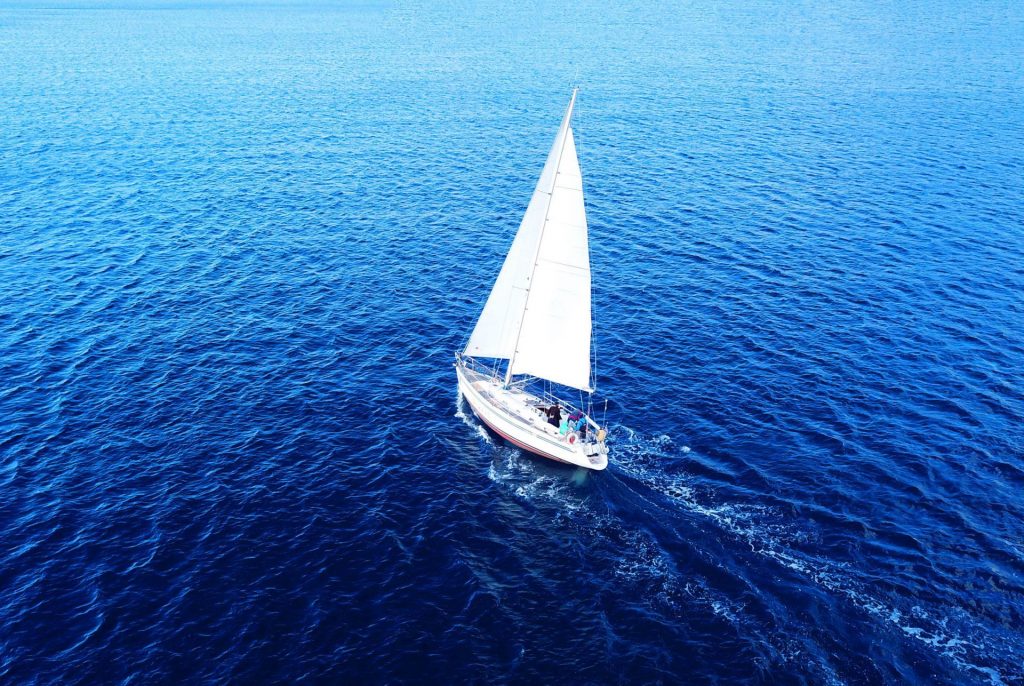
The basics of sailboat design play a significant role in the classification and function of these vessels. Hull shapes, keel types, and construction materials contribute to the speed, stability, and maneuverability of sailboats. Additionally, rigging and sails come in various shapes and sizes, which influence sailing performance and handling.
Key Takeaways
- Sailboats are classified by hull design, rigging, and sails that serve specific purposes.
- Designs and materials have a direct impact on the performance and handling of sailboats.
- A wide range of sailboat types exists, which cater to different needs and preferences.
Basics of Sailboat Design
Sailboats come in various shapes and sizes, designed for different purposes and sailing conditions. One can classify sailboats based on hull types, keel types, and mast configurations. This section will briefly discuss these basic components of sailboat design.
There are mainly two types of hulls: monohull and multihull.
- Monohull : This is the traditional and most common type of sailboat hull. It consists of a single hull, providing stability through the use of a keel or centerboard. Monohulls come in various shapes and sizes, suitable for various sailing conditions.
- Catamaran : Catamarans have two parallel hulls of equal size, offering increased stability and speed compared to monohulls. They are commonly used for cruising and racing.
- Trimaran : Trimarans have three hulls, with a larger central hull and two smaller outrigger hulls. This design offers even more stability and speed than catamarans.
The keel is an essential component in sailboat design, helping with stability and performance. There are various keel types, including:
- Full keel : This traditional design features a long and wide keel that extends along the boat's bottom. It offers good tracking and stability but sacrifices speed and maneuverability.
- Fin keel : Fin keels are shorter and deeper than full keels, providing a better combination of stability and maneuverability. These are common in modern monohull sailboats.
- Bulb keel : A bulb keel features a fin keel with a heavy bulb at the bottom, which concentrates the boat's weight, increasing stability and performance in rough conditions.
- Swing keel or centerboard : Swing keels and centerboards can be raised or lowered, allowing the boat to adapt to different water depths and sailing conditions. They are common in smaller boats and racing sailboats.
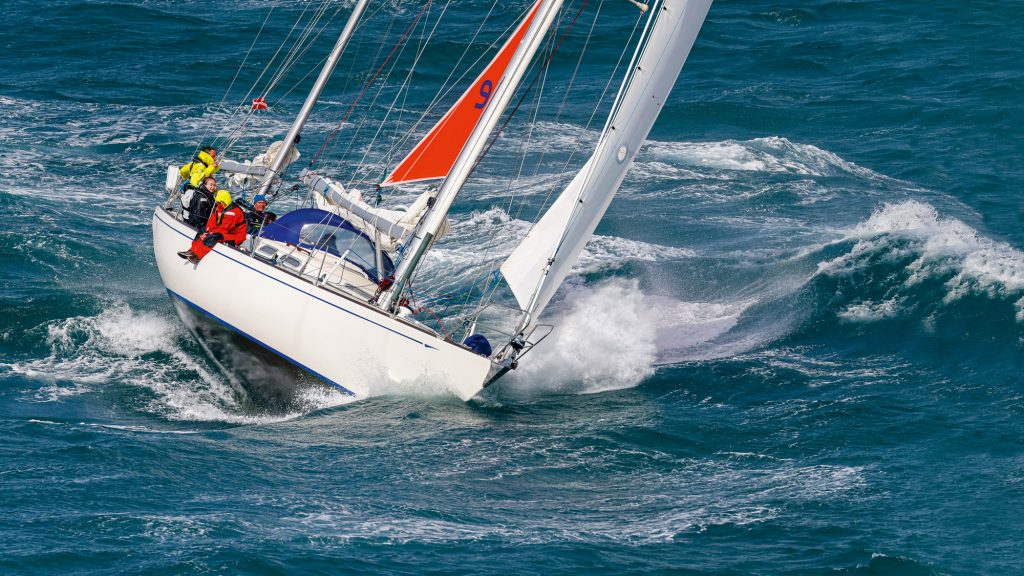
Mast Configuration
The mast configuration affects the sail plan and overall performance of a sailboat. Some common mast configurations include:
- Sloop : This is the most popular mast configuration and features a single mast with a mainsail and a headsail. The simple design makes it easy to handle and suitable for various sailing conditions.
- Cutter : Similar to the sloop, the cutter also has a single mast but carries two headsails, providing more sail area and better performance in heavy weather.
- Ketch : A ketch configuration has two masts: a taller main mast and a shorter mizzen mast. This design offers more flexibility in sail combinations and better balance in different sailing conditions.
- Yawl : Similar to a ketch, a yawl also features two masts but the mizzen is located further aft and is smaller. This design provides better balance and control, particularly in downwind sailing scenarios.
In conclusion, the basics of sailboat design involve selecting the appropriate hull type, keel type, and mast configuration for the desired sailing performance and conditions. Understanding these concepts can help sailors make informed decisions when choosing a sailboat or planning their sailing adventures.
Rigging and Sails
When it comes to sailboats, the rigging and sails play a crucial role in the boat's overall performance and capabilities. This section will briefly cover popular rig types and sail types seen on different sailboats.
There are several types of rigs commonly found on sailboats:
- Sloop : Sloops are the most common type of rig found on modern sailboats. They have a single mast with a mainsail and a single headsail, typically a genoa or jib.
- Ketch : Ketches have two masts, with the main mast taller than the mizzen mast situated aft. They carry a mainsail on the main mast and a mizzen sail on the mizzen mast. Ketches benefit from easier handling and reduced sail area under strong winds.
- Yawl : Similar to ketches, yawls have two masts, but the mizzen mast is smaller and sits further aft, behind the rudder post. Yawls are often chosen for their graceful appearance and improved balance.
- Schooner : Schooners have two or more masts, with the aft mast(s) typically taller than the forward mast(s). Schooners can handle more sails, offering increased sail area for better performance, especially downwind.
- Catboat : Catboats are single-masted sailboats with a single, large mainsail and no headsails. They have a wide beam, which provides stability and ample space for passengers.
- Cutter : Cutters are similar to sloops but carry two headsails, usually a jib and staysail. Cutters may have multiple headsails for increased versatility in various wind conditions.
In addition to the types of rigs, there are also several types of sails used on sailboats, including:
- Mainsail : The primary sail attached to the back of the main mast. It is typically raised on a track or luff groove and managed by a combination of halyard, sheet, and boom vang.
- Genoa : A large triangular sail that overlaps the mainsail, typically used in light winds to provide additional surface area for better performance.
- Jib : A smaller, non-overlapping triangular sail attached to the forestay. Jibs are easier to manage than genoas and are used in a variety of wind conditions.
- Spinnaker : A large, lightweight sail used primarily for downwind sailing . Spinnakers are often brightly colored and shaped like a parachute to catch wind efficiently.
- Staysail : A smaller sail typically used in cutter rigs, positioned between the main mast and the forestay. Staysails provide additional sail area and versatility in varied wind conditions.
Understanding the relationship between sail and rigging can help sailors optimize the performance of their sailboats. With various options for rig types and sail types, each sailboat can be configured to meet the unique needs of its skipper and crew.
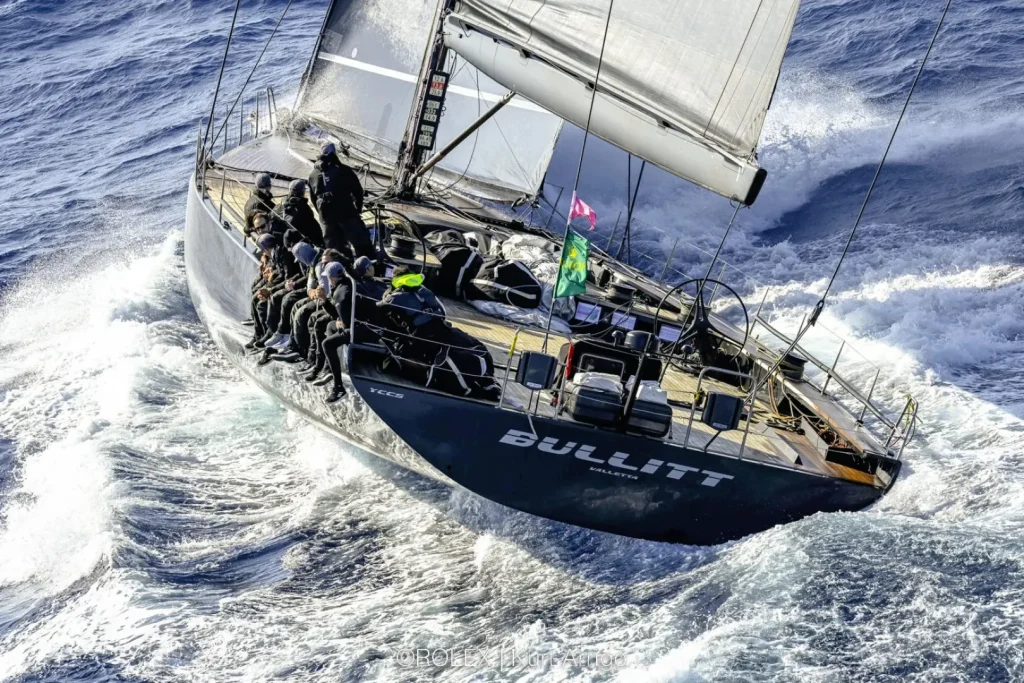
Classes and Types of Sailboats
Monohulls are the most common type of sailboats, consisting of a single hull that provides stability and balance. They come in various sizes and designs, depending on their intended use. Some popular monohull sailboats include the Optimist , Finn, and Sunfish, which are frequently used for racing and recreational sailing. Monohulls tend to have a deeper draft, requiring more water depth than their multi-hull counterparts.
Multihulls, also known as multi-hull sailboats, are a more modern innovation in sailing. They feature two or more hulls connected by a frame or bridgedeck. This design offers increased stability and speed over monohulls. Some common types of multihulls are catamarans (with two hulls) and trimarans (with three hulls). Due to their wider beam and shallower draft, multihulls are particularly suitable for cruising in shallow waters and provide more living space on board.
One-Design Sailboats
One-Design sailboats are a specific class of racing sailboats in which all boats are built to the same design specifications, ensuring that the competition focuses on the skill of the sailor rather than the design of the boat. These boats must adhere to strict rules and standards, with minimal variations allowed in terms of hull shape, sail area, and rigging. Some popular one-design sailboats include the Enterprise and the aforementioned Optimist and Finn sailboats.
Dinghies and Skiffs
Dinghies and skiffs are small, lightweight sailboats that are often used for sailing classes, short-distance racing, or as tenders to larger boats. Dinghies usually have a single mast with a mainsail and sometimes a small jib. Some popular types of sailing dinghies include the Optimist, which is specifically designed for children, and the versatile Sunfish sailboat. Skiffs, on the other hand, are high-performance sailboats primarily used for racing. They have a larger sail area relative to their size and typically include features such as trapezes and planing hulls, which allow for faster speeds and greater maneuverability.
In conclusion, there are various classes and types of sailboats, each with its own unique features and characteristics. From the simplicity of monohulls to the stability and speed of multihulls, and from the fair competition of one-design sailboats to the excitement of dinghies and skiffs, there is a sailboat to satisfy every sailor's preferences.
Sailboat Size and Use
When exploring the world of sailboats, it's important to understand their different sizes and purposes. Sailboats can be categorized into three main types, each with unique characteristics and uses: Day Sailers , Racing Sailboats, and Cruising Sailboats .
Day Sailers
Day Sailers are small sailboats typically ranging from 10 to 24 feet in length. These boats are perfect for short sailing trips and are easy to maneuver for beginners. They have limited accommodations on board, providing just enough seats for a small group of people. Some popular day sailer models include the Laser, Sunfish, and Flying Scot. Lightweight and agile, Day Sailers are often used for:
- Recreation: casual sailing or exploring nearby waters with family and friends
- Training: beginner sailing lessons or practicing sailing techniques
- Competition: local club races or interclub regattas
Racing Sailboats
Racing Sailboats are designed to provide maximum speed, maneuverability, and efficiency on the water. Sizes may vary greatly, from small dinghies to large yachts. Key features of racing sailboats include a sleek hull shape, high-performance sails, and minimalistic interiors to reduce weight.
Career racers and sailing enthusiasts alike participate in various types of racing events , such as:
- One-design racing: all boats have identical specifications, emphasizing crew skill
- Handicap racing: boats of different sizes and designs compete with time adjustments
- Offshore racing: long-distance racing from one point to another, often around islands or across oceans
Cruising Sailboats
Cruising Sailboats are designed for longer journeys and extended stays on the water. They typically range from 25 to 70 feet in length and provide comfortable accommodations such as sleeping cabins, a galley, and storage spaces for supplies and equipment. Sailing cruisers prioritize stability, comfort, and durability for their voyage.
Here are some common types of cruising sailboats:
- Cruiser-racers: These boats combine the speed of a racing sailboat with the comfort and amenities of a cruising sailboat. They are ideal for families or sailors who enjoy participating in racing events while still having the option for leisurely cruises.
- Bluewater cruisers: Designed for handling the world's most demanding ocean conditions, bluewater cruisers are built with a focus on sturdy, self-reliant sailboats that can withstand long-distance voyages and challenging weather conditions.
- Multihulls: Catamarans and trimarans are gaining popularity in the cruising world for their typically more spacious interiors and level sailing characteristics. With two or three hulls, multihulls offer high levels of stability and speed for a comfortable cruising experience.
Understanding the differences between various sailboat types will help potential sailors select the perfect vessel for their sailing goals, skills, and preferences. Day Sailers, Racing Sailboats, and Cruising Sailboats each have their unique features, catering to distinct uses and sailing experiences.
Advanced Sailboat Features
Sailboats have evolved over time, and many advanced features have been developed to enhance performance and safety. In this section, we will discuss some of the key advanced features in modern sailboats, focusing on performance enhancements and safety/navigation.
Performance Enhancements
One critical component that impacts a sailboat's performance is the type of keel it has, which affects stability, resistance, and maneuverability . There are several kinds of keels such as fin keel , wing keel , and bulb keel . Fin keels offer low drag and high efficiency, making them suitable for racing sailboats. On the other hand, wing keels provide better stability at low speeds, while bulb keels provide a lower center of gravity to enhance overall stability and comfort during long voyages.
Another feature that contributes to a sailboat's performance is its sails and rigging. The jib is a triangular sail at the front of the boat, which helps improve its upwind performance. More advanced sailboats use a combination of shrouds , which are the supporting cables running along the sides of the boat, and stays , the cables that help hold the mast in place, to create a stable and efficient rigging system.
A sailboat's performance can also be influenced by the presence of a centerboard or daggerboard , which can be adjusted to optimize stability, maneuverability, and speed. When racing or navigating in shallow waters, retractable centerboards and daggerboards are particularly useful as they provide better performance and versatility.
Safety and Navigation
Safety and navigation onboard a sailboat relies on a combination of advanced gear and equipment. A modern sailboat is usually equipped with:
- GPS and chartplotters to assist with navigation and planning routes
- VHF radios for communication with other vessels and authorities
- Radar to detect obstacles, weather systems, and other vessels
- AIS (Automatic Identification System) which helps monitor nearby vessel traffic
The design of a sailboat's hull, rigging, sails, and hardware also contribute to its safety. The boom , the horizontal pole that extends the sail, should be properly secured and designed to avoid accidents while sailing. The keel , whether it's a fin, wing, or bulb keel, plays a vital role in the overall stability and safety of the sailboat. The choice of keel should be based on the intended use of the sailboat and the prevailing sailing conditions.
In summary, advanced sailboat features significantly improve the performance, safety, and navigation capabilities of modern sailboats. Innovations in keel design, rigging systems, and onboard navigational equipment have undoubtedly contributed to the overall enjoyment and safety of sailing.
Sailboat Ownership
Buying Considerations
When considering buying a sailboat , it is important to understand the different types of sailboats available and the purpose each serves. Sailboats can be broadly categorized into three types:
- Racing sailboats: Designed for speed and performance, with minimalistic interiors and advanced sail systems.
- Cruising sailboats: Built for comfort and longer trips, featuring more spacious interiors and amenities.
- Daysailers: Smaller, easy-to-handle boats that are often used for short trips and recreational sailing.
Prospective boat owners should consider factors such as boat size, type, budget, and intended use (solo vs. family sailing, charter operations, etc.). It's also essential to evaluate the availability of necessary gear and the level of experience required to handle the chosen sailboat.
Maintenance and Upkeep
Sailboat ownership involves maintenance and upkeep to ensure the boat remains functional, safe, and holds its value. Some common maintenance tasks include:
- Hull cleaning and inspection: Regularly inspect the hull for damages and clean off any growth to maintain performance and fuel efficiency.
- Antifouling paint: Apply antifouling paint to prevent marine organisms from attaching to the hull, which can negatively impact the boat's performance.
- Engine maintenance: Check and replace engine oil, inspect cooling and fuel systems, and clean or replace air filters.
In addition to regular maintenance, sailboat owners should also be prepared to replace or repair critical systems and components, such as:
- Sails: Monitor the condition of your sails and replace them as needed to maintain performance and safety.
- Rigging: Regularly inspect and maintain the standing and running rigging, and replace worn or compromised parts.
- Electronics and instruments: Ensure navigation systems, radios, and other electronic equipment are functioning properly.
Taking proper care of a sailboat can be time-consuming, and some owners may choose to charter their boats when not in use as a way to offset ownership costs. Others may opt for hiring professionals to manage routine maintenance, particularly when sailing solo or with limited sailing experience.
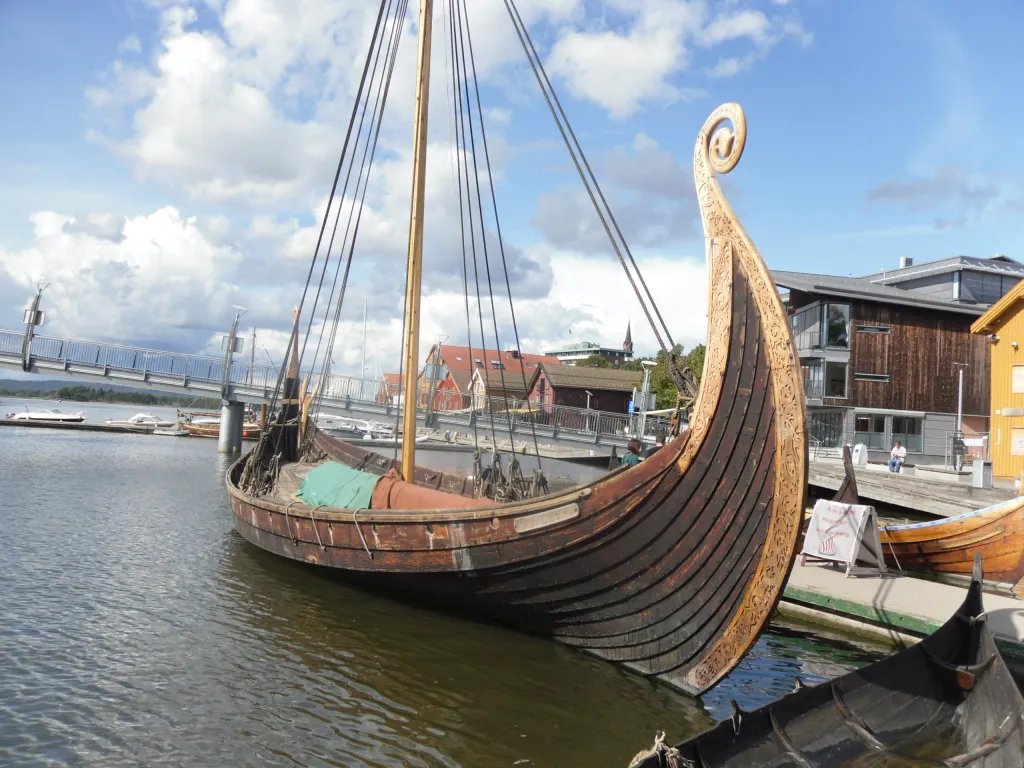
Historical and Special Sailboats
Tall ships and gaffers.
Tall Ships are large, traditionally rigged sailing vessels with multiple masts, typically square-rigged on at least one of their masts. Some examples of these ships include the clipper, brig, and square-rigged vessels. The clipper is a fast sailing ship known for its sleek hull and large sail area, while the brig features two square-rigged masts. Square-rigged ships were known for their impressive sail area and could cover large distances quickly.
Gaffers are a subset of historical sailing vessels with a gaff mainsail as their primary sail type. This gaff-rig is characterized by a spar (pole) that extends the top edge of the mainsail, giving it a quadrilateral shape to optimize wind coverage. Gaff mainsails were commonly used in England and influenced the development of other sailing vessels.
Classic and Antique Sailboats
Classic and antique sailboats refer to older, traditionally designed sailing vessels that have been preserved or restored. They often feature wooden construction and showcase a variety of rigging types, including gaff rigs and square rigs. These historical sailboats have unique designs, materials, and techniques that have since evolved or become rare.
Here are some examples of antique and classic sailboats:
- Sloop : A single-masted sailboat with a Bermuda rig and foresail
- Cutter : A single-masted vessel with a similar rig to the sloop, but with additional headsails for increased maneuverability
- Ketch : A two-masted sailboat with a smaller mizzen mast aft of the main mast
In summary, historical and special sailboats encompass a wide range of vessel types, from large, multi-masted tall ships to smaller, single-masted gaffers and classic sailboats. These vessels reflect the rich maritime history and the evolution of sailing techniques and designs over time.
Sailboat Culture and Lifestyle
Sailboat culture and lifestyle encompass a variety of aspects including racing events, leisurely cruising, and exploring new destinations. The main types of sailboats include racing yachts, cruising sailboats, and motorsailers, each offering a unique experience for sailors.
Regattas and Racing Circuits
A popular aspect of sailboat culture involves participating in regattas and racing circuits . These events create a competitive atmosphere and develop camaraderie among sailors. Racing sailboats are specifically designed for speed and agility , and sailors often team up to compete in prestigious races such as the Rolex Sydney Hobart Yacht Race or the America's Cup. Yacht clubs play an essential role in cultivating this competitive sailing environment.
Sailboat Charter and Tourism
Another facet of sailing culture is the sailboat charter and tourism industry, which allows people to experience the cruising lifestyle without owning a sailboat. Charters are offered for various types of sailboats, from family-sized cruising vessels to luxurious superyachts . Yacht sailing provides tourists with a unique travel experience, as they can explore diverse destinations, immerse themselves in local cultures, or simply relax on the open water.
Cruising sailboats are designed to provide comfortable living spaces and amenities, making them perfect for longer journeys or exploring remote destinations. Motorsailers, on the other hand, are equipped with both sails and engines, offering versatility and convenience for sailors.
Some popular sailing destinations include the Caribbean, Mediterranean Sea, and the South Pacific. These regions offer beautiful scenery, rich cultural experiences, and ideal sailing conditions.
The sailboat culture and lifestyle attract individuals who enjoy adventure, exploration, and camaraderie. From competitive racing events to leisurely cruising vacations, sailing offers diverse experiences that cater to a wide range of interests.
Frequently Asked Questions
What are the distinguishing features of different sailboat classes?
There are various sailboat classes, each with its own distinguishing features. Monohulls, for example, are the most common type of sailboat and have a single hull. Multihulls, such as catamarans and trimarans, have two or three hulls, respectively. These differences in hull design often affect the boat's stability, speed, and maneuverability.
Which sailboat types are best for novice sailors?
Novice sailors often benefit from starting with smaller, more manageable boats. Sailing dinghies and daysailers are popular choices due to their simple rigging and ease of handling. These boats typically have a single mast and a limited number of sails, making them ideal for beginners to learn sailing basics.
What are common types of small sailboats ideal for day sailing?
For day sailing, small sailboats such as sailing dinghies, day sailers, and pocket cruisers are ideal options. These boats usually range between 12 and 25 feet in length and offer simplicity, ease of handling, and portability. Examples of common day sailing boats include the Sunfish, Laser, and O'Day Mariner.
How do the purposes of various sailboat types vary?
Sailboats serve different purposes based on their design, size, and features. Daysailers and dinghies are ideal for short trips, sailing lessons, and casual outings. Racing sailboats, with their lighter weight and streamlined design, are built for speed and competition. Cruising sailboats, on the other hand, are designed for longer voyages and often include living quarters and additional amenities for comfortable onboard living.
What is considered the most popular class of sailboat for recreational use?
The most popular class of sailboat for recreational use often varies depending on individual preferences and local conditions. However, monohulls are commonly preferred due to their widespread availability, versatility, and affordability. Within the monohull class, boats like the Sunfish, Laser, and Catalina 22 are popular choices for their ease of use and adaptability to various sailing conditions.
Could you describe a sailing dinghy designed for two people?
A two-person sailing dinghy typically has a simple rig with a single mast and one or more sails, making it easy to handle for both experienced and novice sailors. The RS Venture , for example, is a popular choice for two-person sailing. It features a spacious cockpit, durable construction, and simplicity in its rigging and control systems. These characteristics make it an excellent option for recreational sailing, training, and even racing.
Related Articles

Bass Boat Central: A Comprehensive Overview of the Iconic Website

Formula 43 Sport

Complete Guide to Orcas Island: Insider Tips and Must-See Attractions
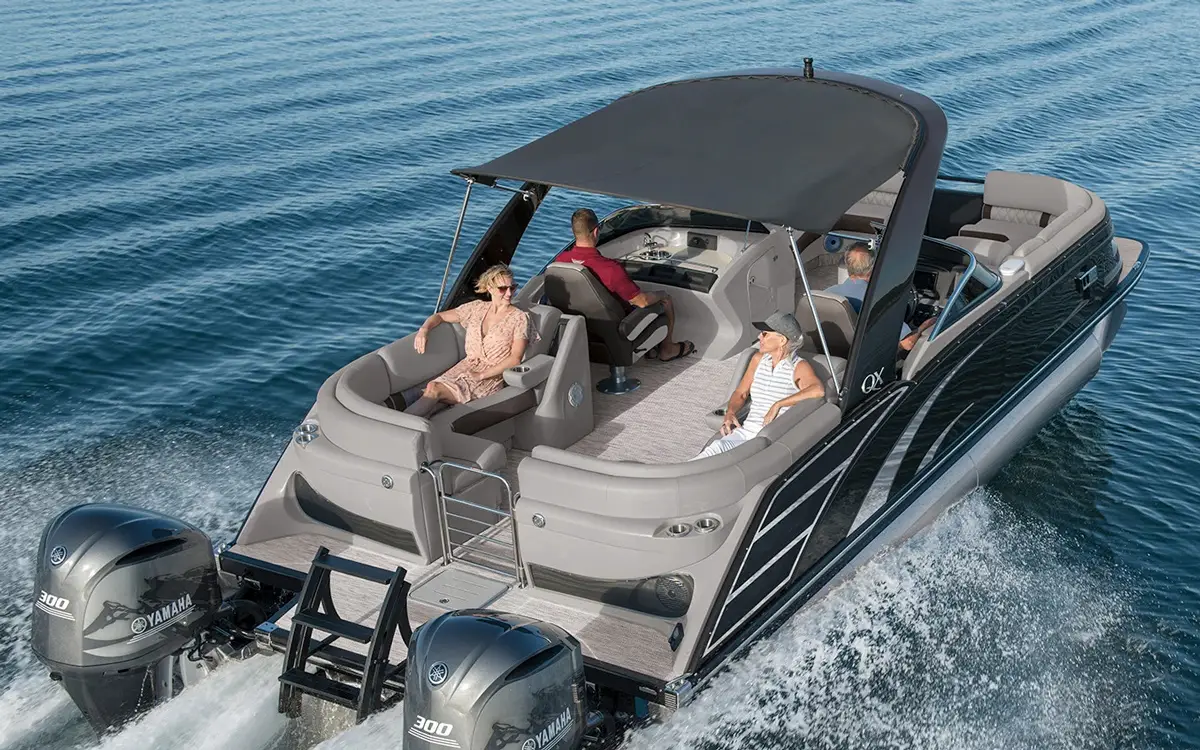
Tritoon Boats: Unleashing Versatility and Performance on the Water

Boat Blue Book Value: Comprehensive Guide for Accurate Assessments

Clear South Padre Island Water: Uncovering the Secret to Pristine Beaches

ePropulsion: Electric Outboard Motor Revolution in Modern Boating

How Do You Know When You Are Operating Your Vessel at a Safe Speed? Essential Tips and Guidelines
- Cruise search
- Atlantic Coast, Azores & Madeira
Northern Europe
Mediterranean sea.
- Canaries & Morocco
- Caribbean – Lesser Antilles & Grenadines
- Bahamas & Florida
- Costa Rica & Central America
Transatlantic Crossing
- Service package
- Special offer
- Private charter
- Special occasion
- SEA CLOUD II
- SEA CLOUD SPIRIT
- Fascinated by windjammer
- Low-impact tourism
- Newsletter subscription
- Feine Privathotels
- Meisterkreis
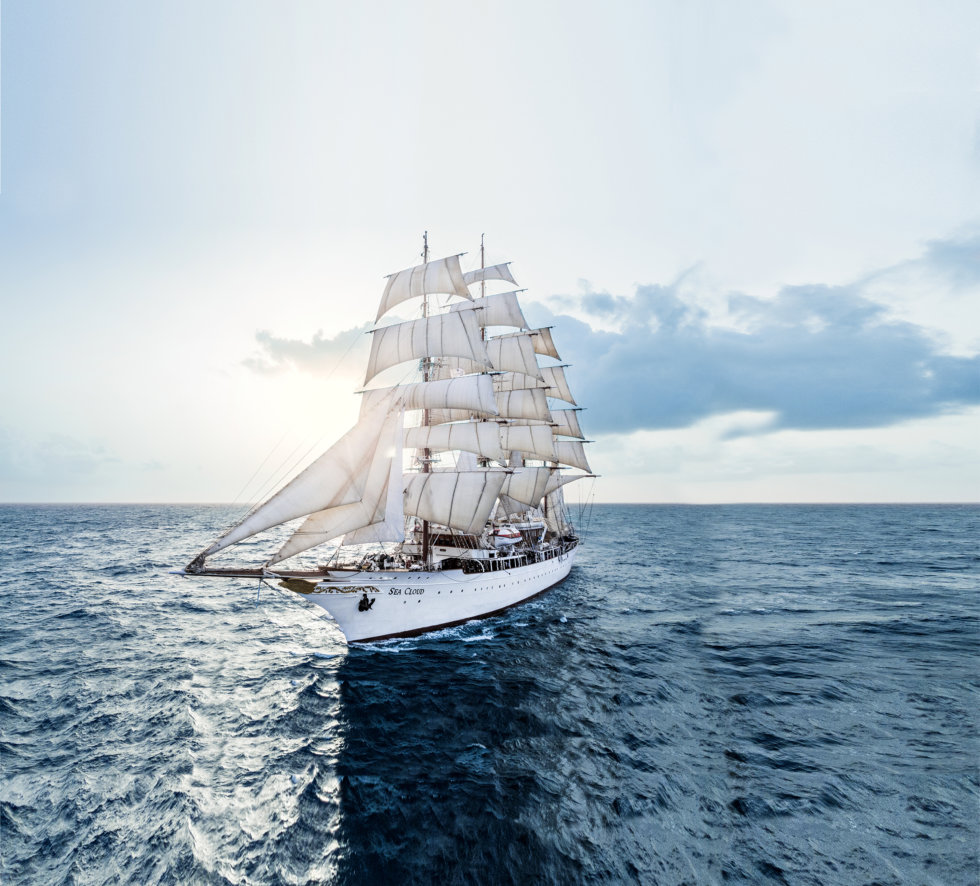
Exclusive sailing experiences
Enjoy the best days of the year with a clear conscience and positive feeling: For more than 40 years, we have been pursuing the principle of sustainable tourism. Traveling with a small number of guests creates space for great things. Meeting people at eye-level in the countries you visit, experiencing cultures, appreciating regional values and creating added value for the region. This is pointing the way ahead because it is in keeping with the times. Because we are firmly convinced that traveling in harmony with nature is possible and necessary.
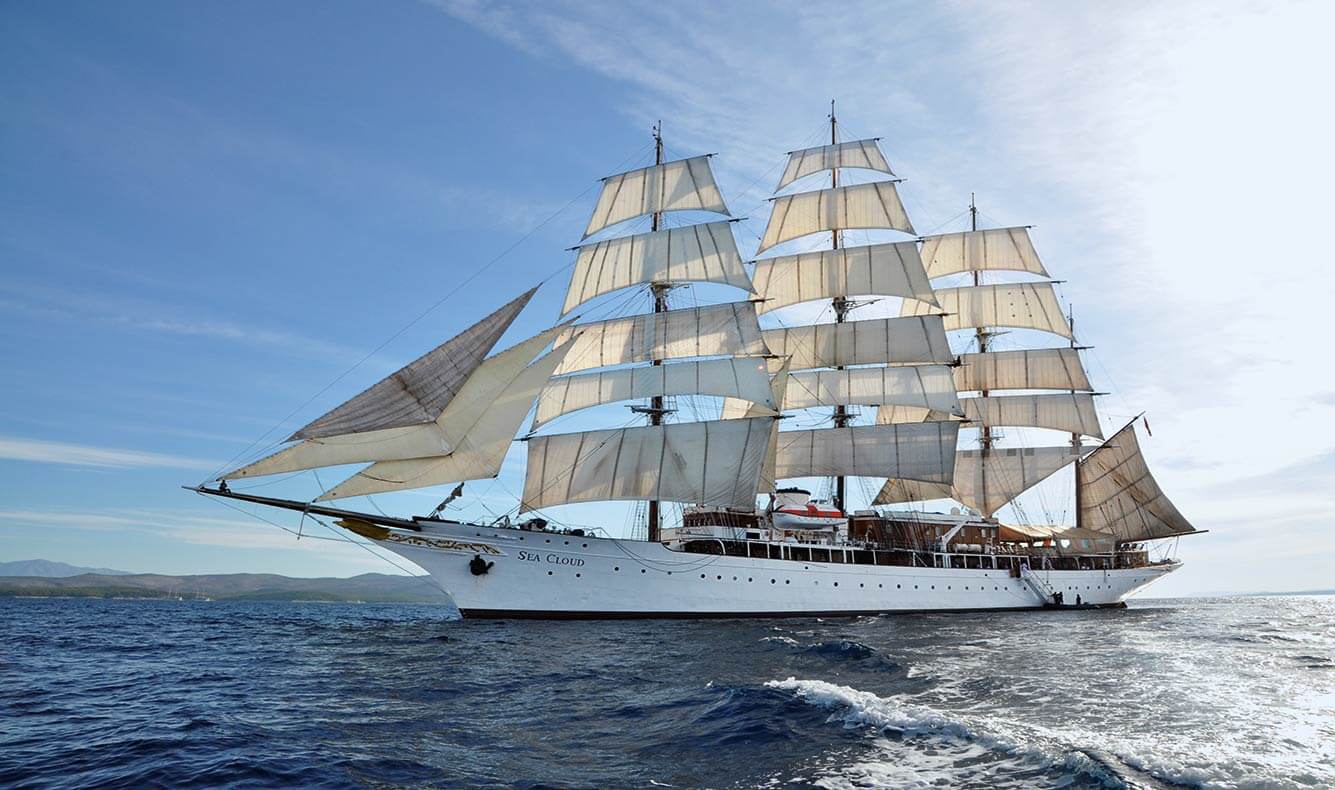
Our highlights for you

Canaries & Morocco
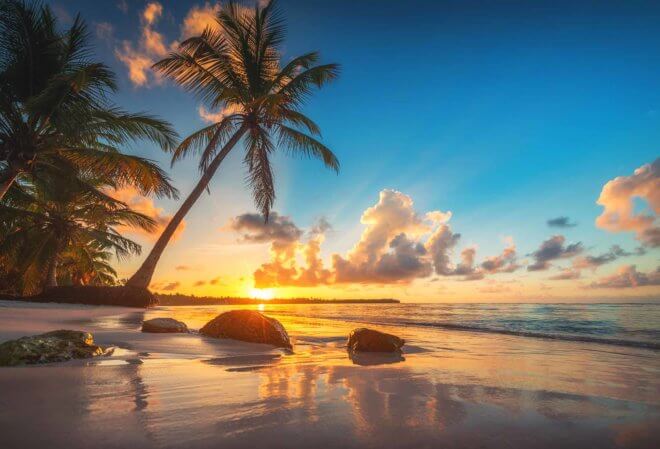
Caribbean - Lesser Antilles & Grenadines
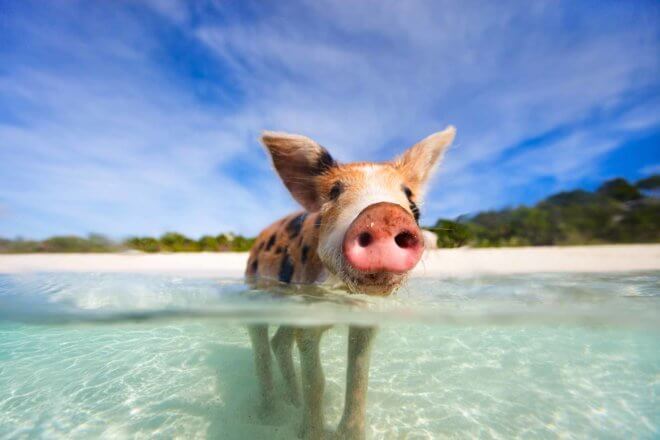
Bahamas & Florida

Costa Rica & Central America

Destinations
Atlantic coast.
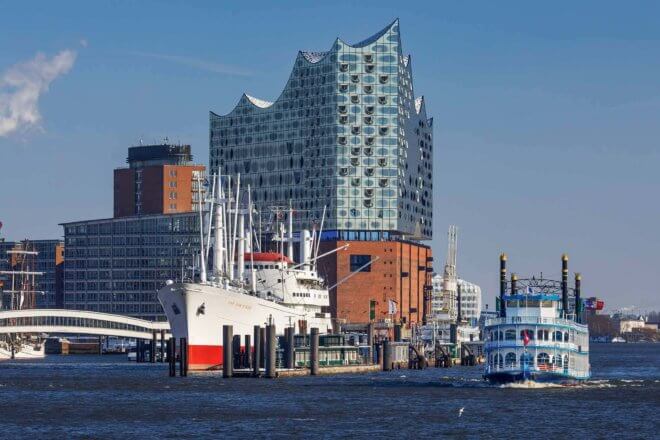
Good to know
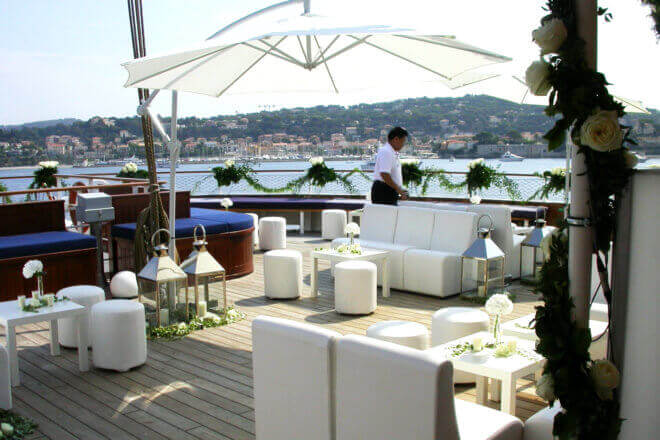
- Catalog order
- Legal details
- Privacy information
- Terms and Conditions of Travel and Transportation
- Refund instructions for non-performance of transportation
- EU Regulation
- Disclaimer of liability
- CHF conversion table


Black Pearl
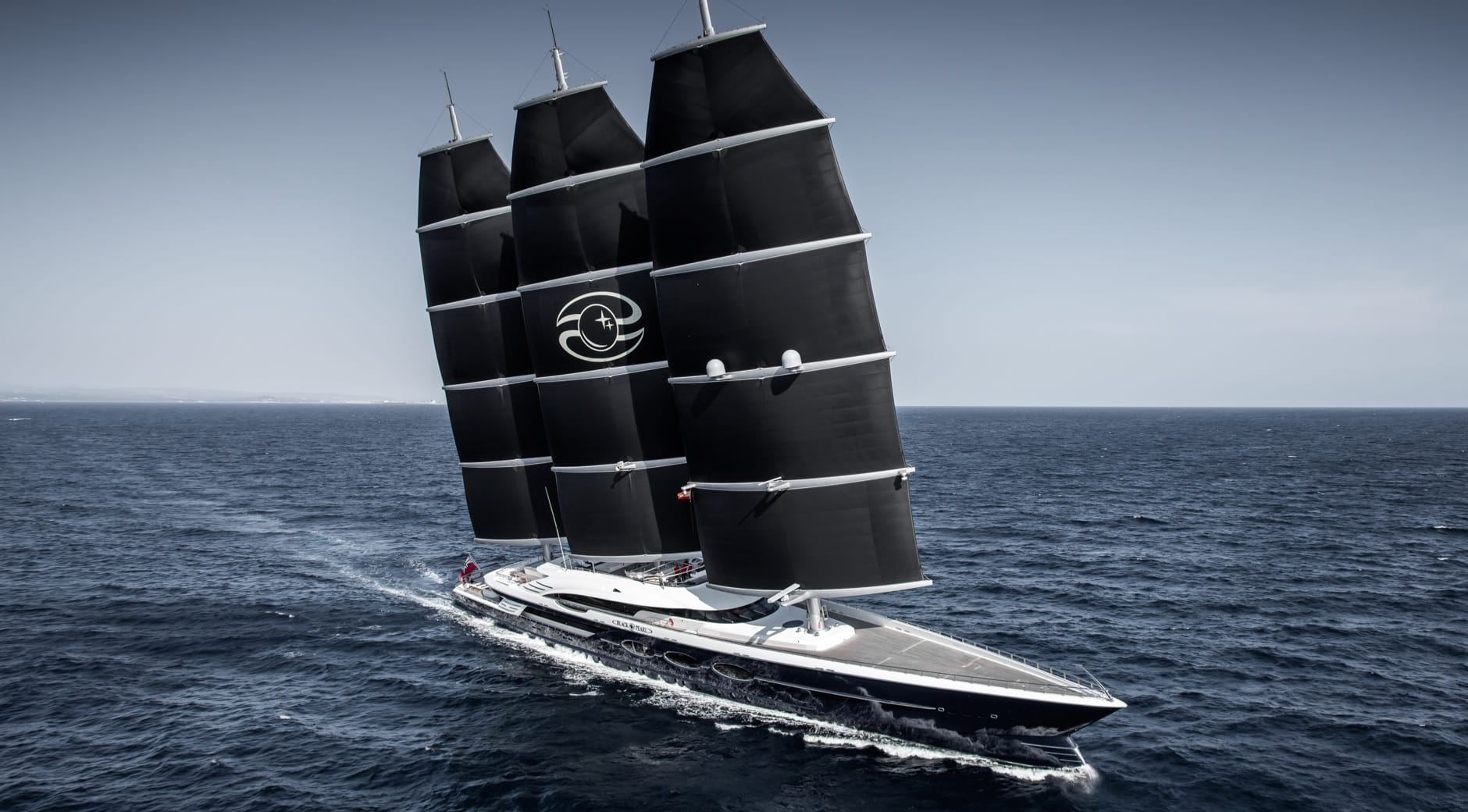
What if an owner’s vision is revolutionary?
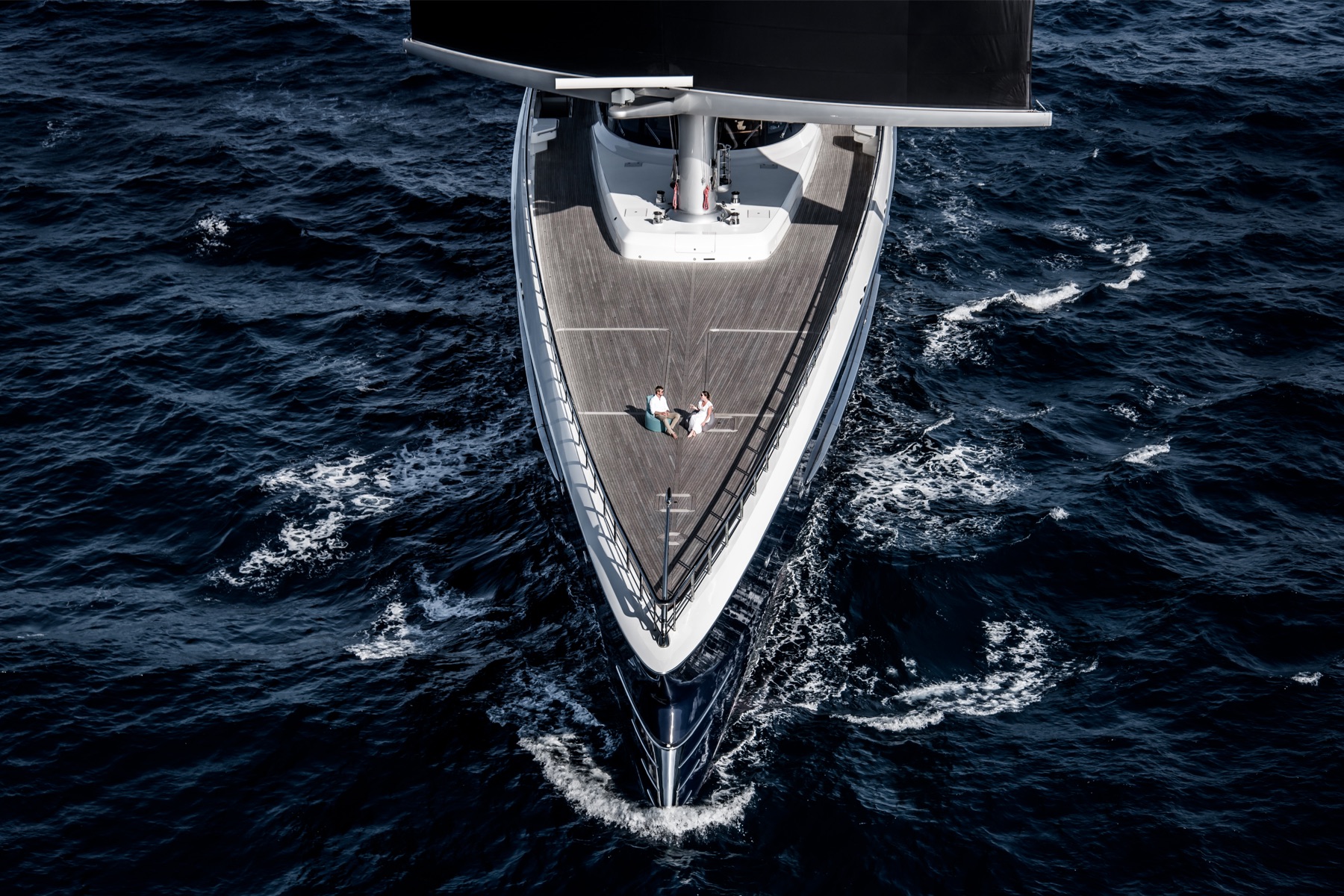
Exterior design
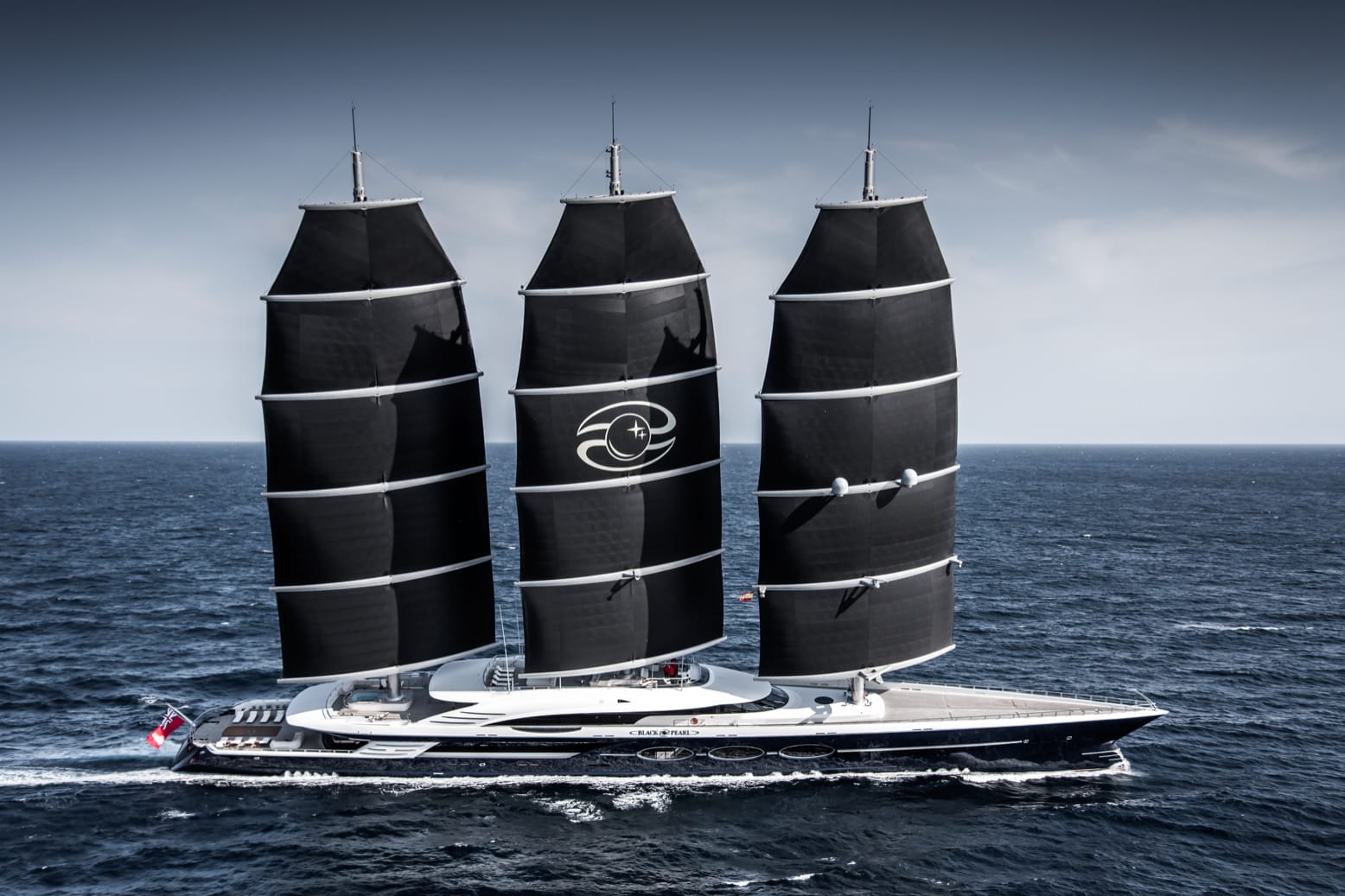
Interior design
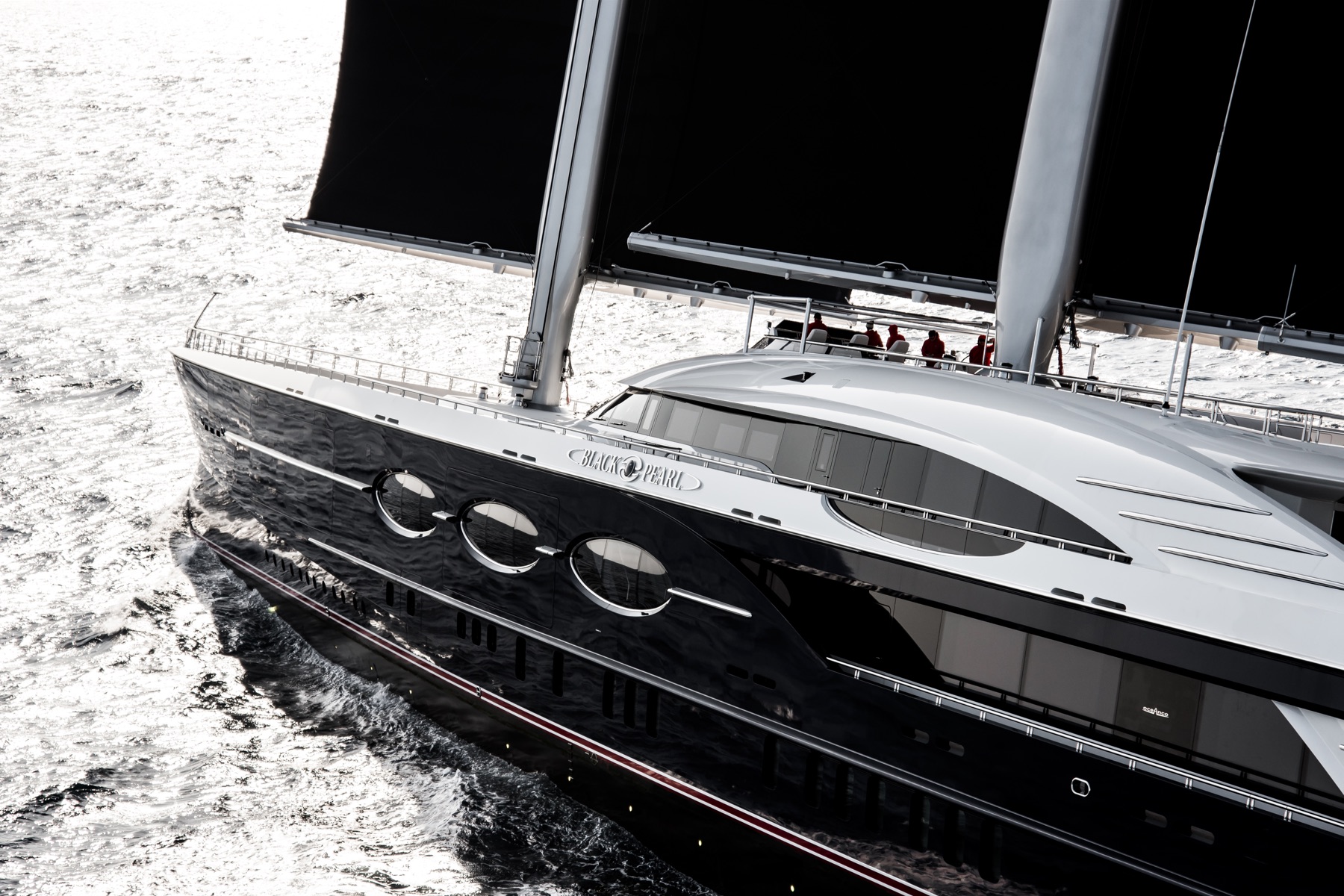
Specifications
Cookie preferences.
Functional cookies help to perform certain functionalities like sharing the content of the website on social media platforms, collect feedbacks, and other third-party features.
Performance cookies are used to understand and analyze the key performance indexes of the website which helps in delivering a better user experience for the visitors.
Analytical cookies are used to understand how visitors interact with the website. These cookies help provide information on metrics the number of visitors, bounce rate, traffic source, etc.
Advertisement cookies are used to provide visitors with relevant ads and marketing campaigns. These cookies track visitors across websites and collect information to provide customized ads.
Other uncategorized cookies are those that are being analyzed and have not been classified into a category as yet.
JavaScript seems to be disabled in your browser. For the best experience on our site, be sure to turn on Javascript in your browser.
- Request a quote
- Contact
- Your luxury cruise with PONANT
- Africa, Middle East & Indian Ocean
- Atlantic Coast
- Central America
- North America
- Northern Europe & Scandinavia
- Ocean Voyages
- Oceania & Pacific Islands
- South America
- The Mediterranean
- Transatlantic
- Show all destinations
- See all cruises
- Loyalty Cruise
- Gastronomy & Wine
- Polar Expedition
- Tropical Expedition
- Art & Museums
- Smithsonian Journeys
- Theatre & Literature
- The Explorers Club
- Show all themes
- Back-to-back offers
- Free Ocean Voyage
- No single supplement
- Flight credit
- L'AUSTRAL
- LE LAPÉROUSE
- LE CHAMPLAIN
- LE BOUGAINVILLE
- LE DUMONT-D'URVILLE
- LE JACQUES-CARTIER
- LE COMMANDANT CHARCOT
- Expeditions
- Life on board
- A different way to cruise
- Our guests and speakers
- A tailor-made voyage
- Why choose PONANT ?
- PONANT benefits
- Our Pavilions
- Our 360-degree destinations
- A more sustainable tourism
- PONANT Foundation
- Certifications and distinctions
Where would you like to travel with PONANT?
Which period?
What are you looking for?
- Gastronomy & Wine
- Art & Museums
Le Ponant , the company's iconic three-master and the first sailing ship in the world to be awarded the Relais & Châteaux label in 2023, symbolises our commitment to a more sustainable form of travel.
Up to 32 Guests
16 staterooms & suites, 33 crew members, 1 restaurant.
- View all cruises
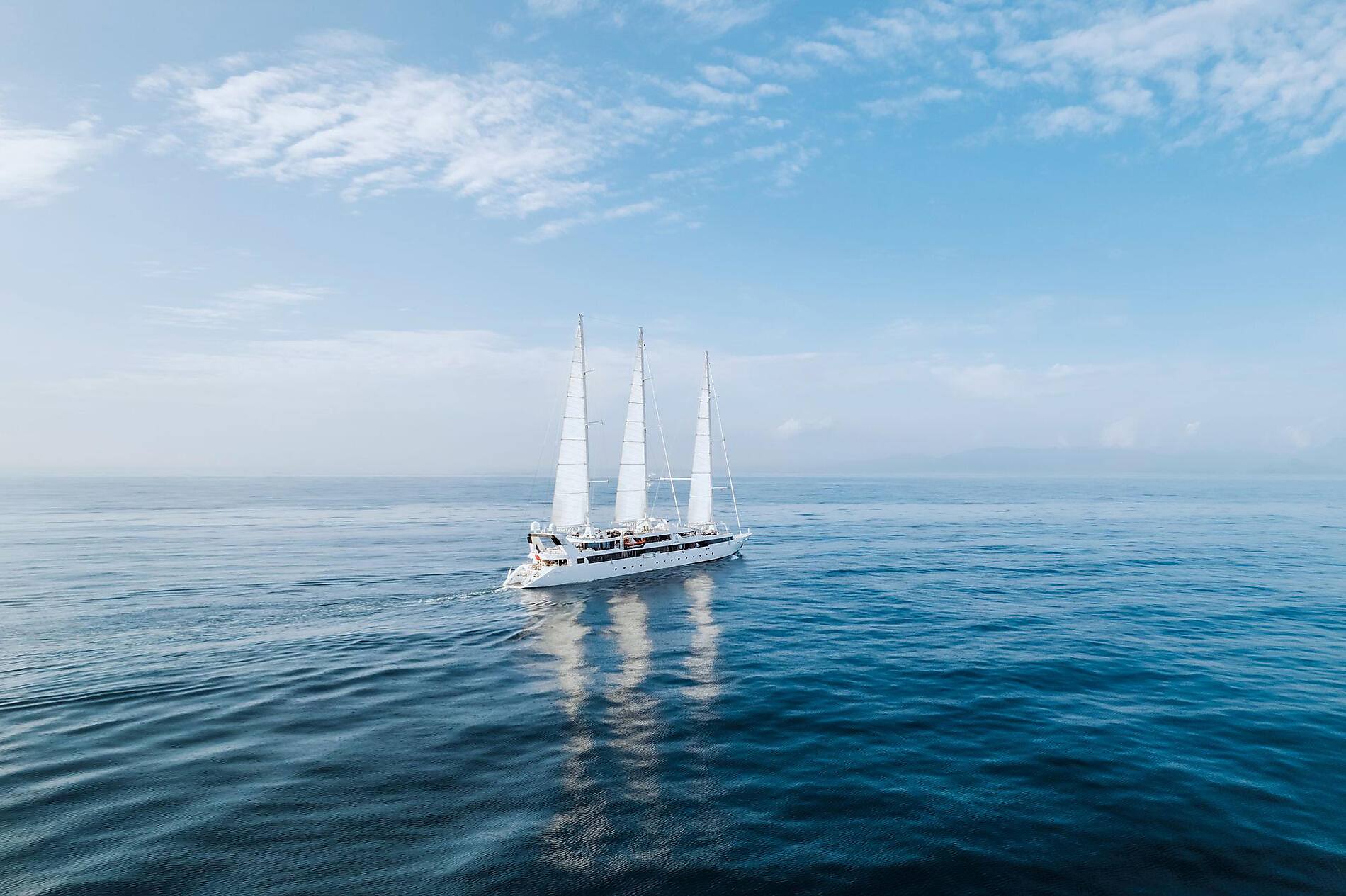
This legendary yacht offers a uniquely exclusive voyage experience. An invitation to sail, revitalise oneself, share, contemplate and respect the world around us. An ode to freedom and the treasures of nature.
With its common areas open extensively to the horizon, you will have never felt such communion with the elements. With one crew member per passenger and just thirty-two guests on board, you will have never enjoyed so much attention. With navigation under sail the moment conditions allow, you will have never savoured each second that passes to such an extent.
Latitude : 43.54007 Longitude : 7.01760 View on the map
Le Ponant Live View the webcam
Le Ponant in pictures

The three-master joins the large family of Relais & Châteaux establishments as a new member. It is the first sailing yacht in history to obtain the label and be included in its catalogue of the finest travel addresses in the world. Due to its small size Le Ponant offers exclusive ports of call. With only sixteen elegantly decorated staterooms and suites and a dedicated chef, the travel experience is as if you are on your own private yacht.
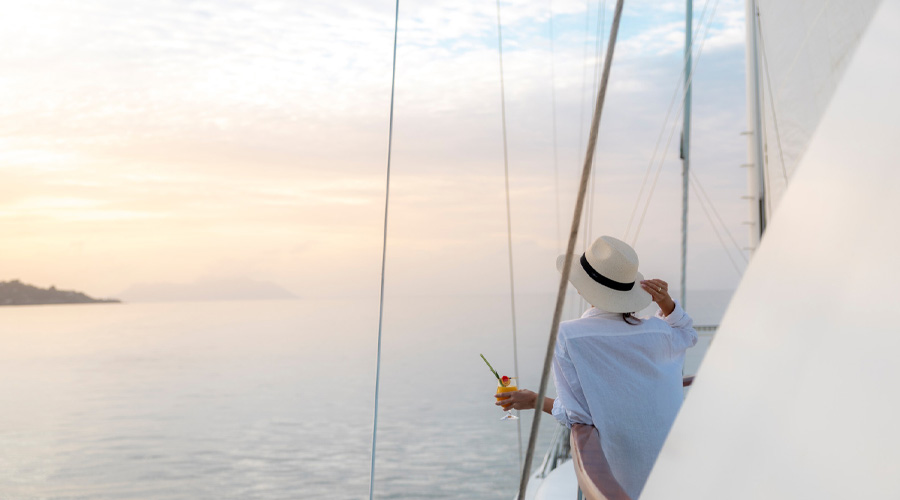
Both our firms are committed to sharing expertise and promoting the inimitable French lifestyle to design meaningful voyages. Aboard Le Ponant , the jewel of our fleet, everyone can reconnect with nature and their own inspirations and live out their desires under sail.
Hervé Gastinel, CEO of PONANT.
A movement with meaning
Relais & Châteaux, established in 1954, is an association of 580 unique hotels and restaurants throughout the world, owned and operated by independent entrepreneurs – most often families – who are passionate about their craft and deeply committed to forging warm, lasting relationships with their guests.
Relais & Châteaux members protect and promote the wealth and diversity of the world’s culinary and hospitality traditions, to ensure they continue to thrive. They are equally dedicated to preserving local heritage and the environment, as articulated in the association’s Vision presented to UNESCO in November 2014.

Visit Le Ponant
360° virtual tour of Le Ponant

Discover Le Ponant
Our ship specially designed for navigation in Polynesian waters
Where will you travel next aboard: Le Ponant ?
- Discover all destinations
Common areas
The striking lines, the quality of the materials, the sophistication of the way they’re combined: the common areas, designed by French design studio Jean-Philippe Nuel, exude a sense of timelessness and offer a genuine connection with the exterior scenery and landscapes. Their design offers a blend of purity, excellence and a sense of easy living through the prominent use of stylish plain tones: off-white, taupe and caviar grey. No flourishes or embellishments here, but instead a unity between the common areas and the staterooms .
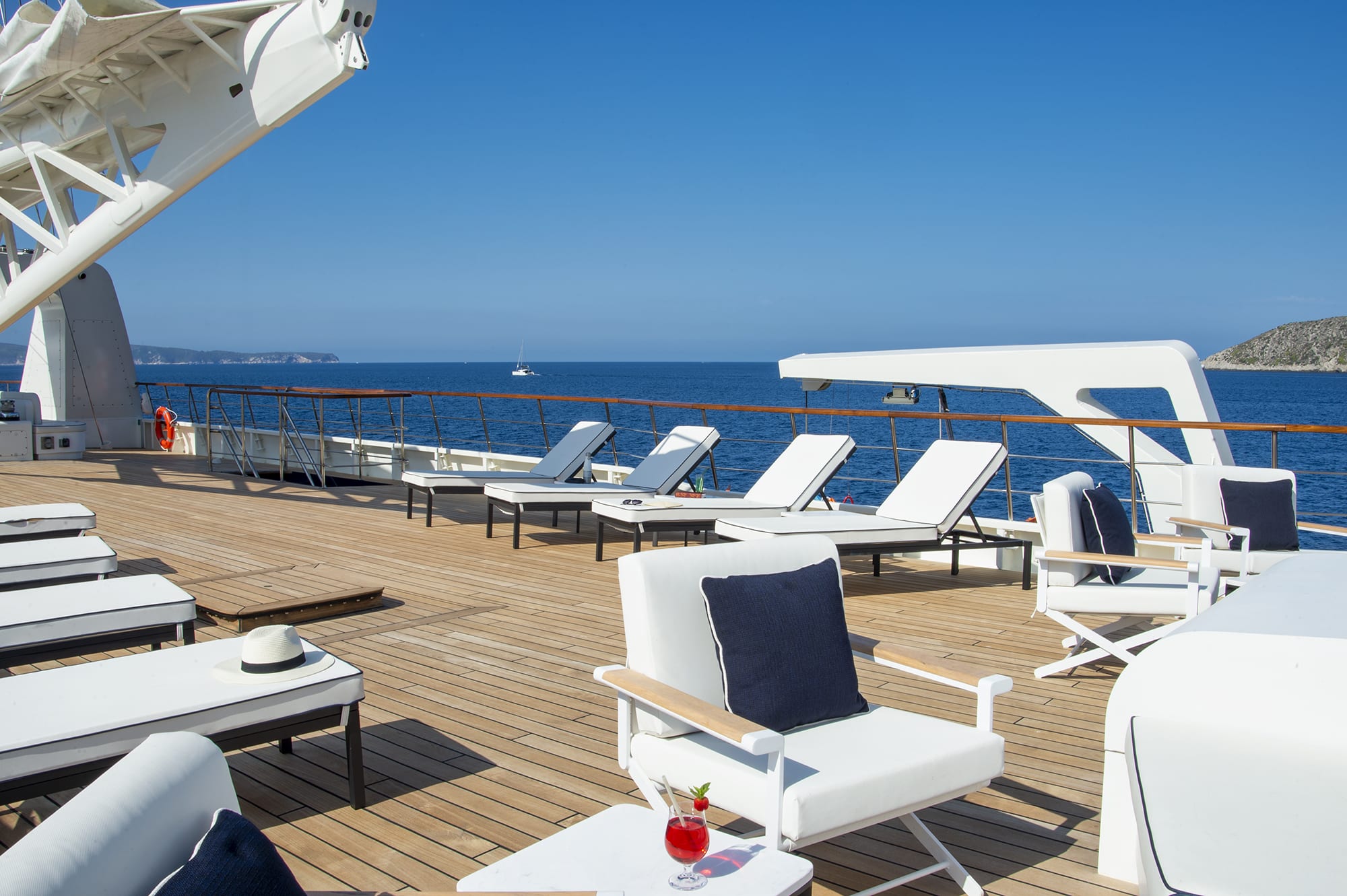
Exterior bar - Sun Deck
- Sun Lounge area
- Exterior bar
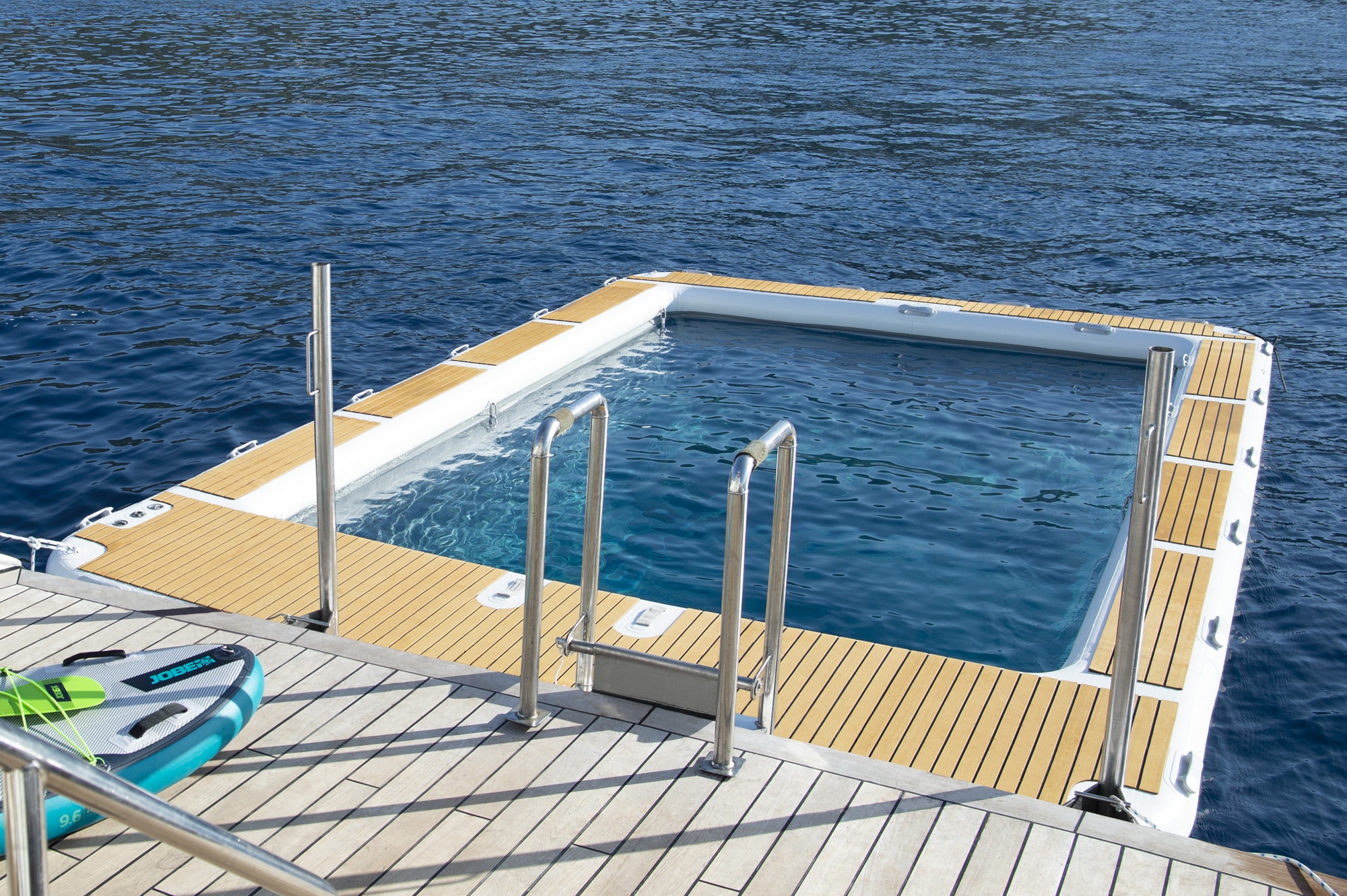
The Marina - Alizés Deck
- Two standard kayaks and two glass-bottomed kayaks
- Four stand up paddleboards
- Snorkelling equipment
- Fishing equipment
- Scuba diving equipment (for a group of four people)
- Saltwater swimming pool
- Small equipment for children (noodles, rings, armbands and safety equipment)
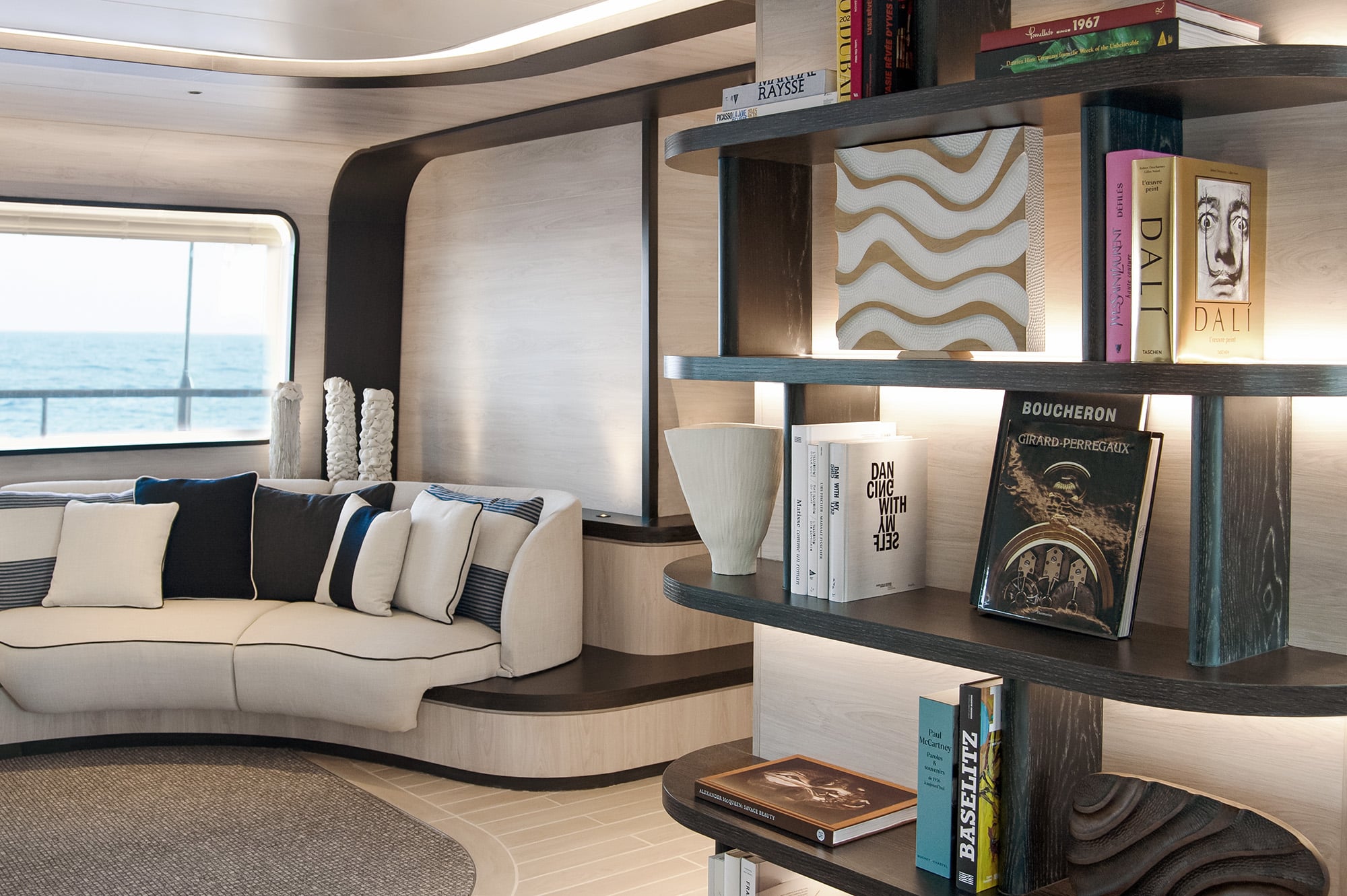
The lounge and Bar Emeraude - Alizés Deck
- Interior surface : 92 m²
- Seats 35 guests
- Exterior surface : 85 m²
- Seats 24 guests

The wellness space - Alizés Deck
- Spa / massages (18.5 m²): one cabin offering massages and Biologique Recherche treatments
- Gym (16 m²)
The panoramic restaurant
The gastronomic symphony on board Le Ponant celebrates the enjoyment of food and the riches of nature, and sublimely showcases products from the lands visited. The restaurant, extensively turned towards the exterior with its large openings and its terrace offering 34 seated places, welcomes you morning, noon and evening for exceptional moments of gastronomic delight.
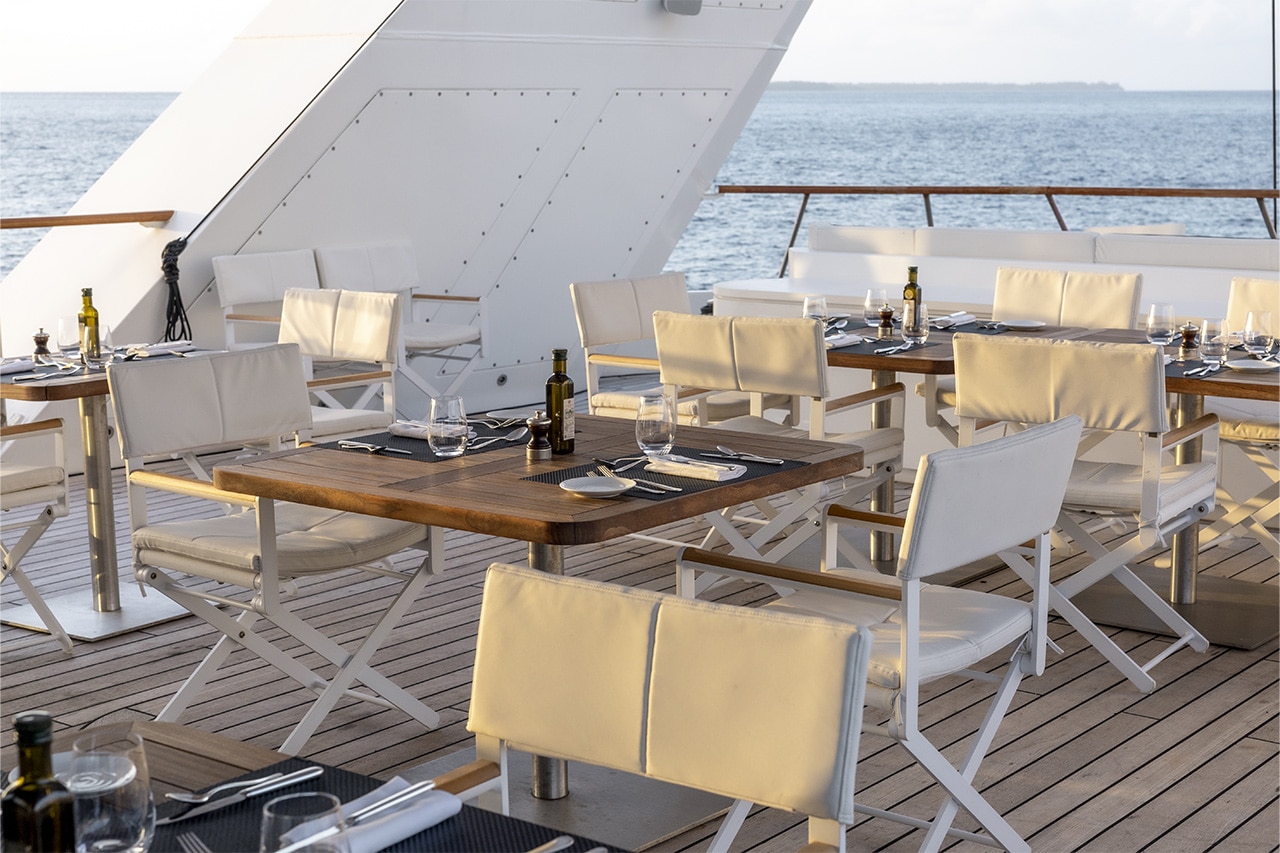
The Le Diamant panoramic restaurant - Zéphyr Deck
- Seats 34 guests
- Fine gastronomic cuisine made using exceptionally high quality organic and local products
- Veuve Clicquot champagne
- Wines from French artisan wine producers and the regions visited.
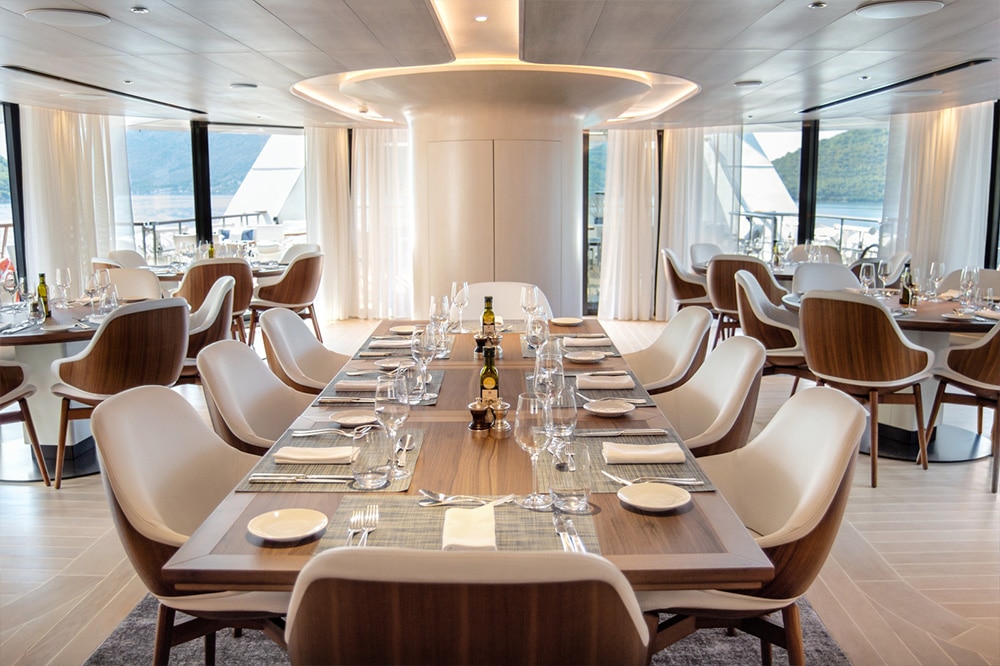
16 high-class staterooms and suites
Distributed across three decks, the staterooms and suites of Le Ponant are wonderfully spacious. Each benefits from a soft luminosity afforded by wide picture windows and portholes. Tastefully decorated, they offer luxurious surroundings conducive to peace and relaxation.
See Staterooms
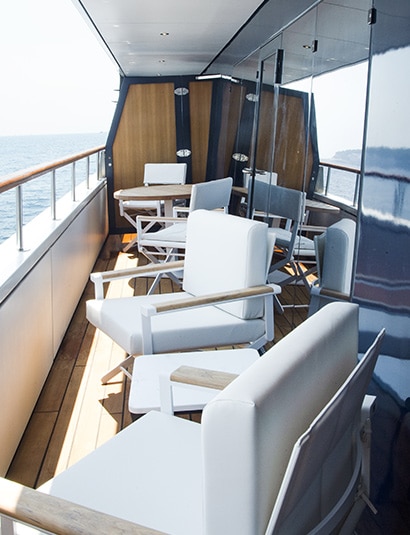
A unique concierge service
To assist you in all the steps related to your cruise, our Concierge Travel team is at your dispposal at any time. Our experts help you plan and develop your tailor-made trip. Before embarking Le Ponant , rest assured our team had handle every details.
Information & reservations +33 (0)4 91 26 62 20 [email protected]

Spécificités techniques
Services provided
- Concierge Service: tailor-made and fully customisable services, from your reservation until you return from your trip
- Inclusive Wifi internet access (availability dependent on navigation and latitude)
- Individually-controlled air conditioning
- Dressing room with shelves and closet
- Dressing table and hairdryer
- Dyptique Paris top-of-the-line bath products
- Nespresso coffee maker and boiler
- Electronic safe
- Direct line telephone
- Bose Bluetooth speaker
- Flat screen TV, international channels (availability dependent on navigation) and videos on demand
- 110V American (two flat pins)/220V European (round sockets with two round pins)
- No lift, not suitable for people with reduced mobility
Your stateroom category
Stateroom size
- - than 269 ft²
- + than 269 ft²
Mistral Stateroom
Mistral Prestige Stateroom
Alizés Stateroom with balcony
Mistral Junior Suite
Alizés Prestige Stateroom with balcony
Mistral Prestige Suite
Alizés Privilege Suite with balcony
Grand Privilège Alizés Suite with balcony
Owner Suite with balcony

101 Feet Oceanic Ketch
MARAMA is a unique Sailing Yacht, designed by Dominique Presles, and built of aluminium by the N2A shipyard in St Nazaire, under the control of Bureau Véritas.
It is an exceptional ship on all levels.

Yacht sinks after latest incident involving orcas in strait of Gibraltar
Vessel measuring 15 metres in length sank after encounter with the animals, Spain’s maritime rescue service reports
An unknown number of orcas have sunk a yacht after ramming it in Moroccan waters in the strait of Gibraltar, Spain’s maritime rescue service has said, in the latest in a series of similar incidents involving the animals.
The vessel, Alboran Cognac, which measured 15 metres (49ft) in length and carried two people, encountered the highly social apex predators, also known as killer whales, at 9am local time on Sunday.
The passengers reported feeling sudden blows to the hull and rudder before the boat started taking on water. After alerting the rescue services, a nearby oil tanker took them onboard and transported them to Gibraltar. The yacht was left adrift and eventually sank.
The incident is the latest example of recurring orca rammings around the Gibraltar strait that separates Europe from Africa and off the Atlantic coast of Portugal and north-western Spain. Experts believe them to involve a subpopulation of about 15 individuals given the designation “Gladis”.
According to the research group GT Atlantic Orca, which tracks populations of the Iberian orca sub-species, there have been nearly 700 interactions since orca attacks on ships in the region were first reported in May 2020.
Researchers are unsure about the causes for the behaviour, but theories include that it is a playful manifestation of the mammals’ curiosity, a social fad or the intentional targeting of what they perceive as competitors for their favourite prey, the local bluefin tuna.
Although known as killer whales, endangered orcas are part of the dolphin family. They can measure up to 8 metres in length and weigh up to 6 tonnes as adults.
- Marine life
- Water transport
Most viewed
Orcas have attacked and sunk another boat in Europe — and experts warn there could be more attacks soon
A group of orcas known to attack boats in southwest Europe have sunk a 50-foot sailing yacht in the Strait of Gibraltar after ripping open its hull. It is the fifth time these killer whales have sent a ship to the seafloor in the last three years.

Orcas that have been terrorizing boats in southwest Europe have just sank their fifth yacht in three years. And experts have warned that more attacks are likely in the coming months after the orcas unexpectedly switched up their behavior earlier this year.
On Sunday (May 12), an unknown number of orcas ( Orcinus orca ) attacked the 49-foot-long (15 meters) sailing yacht named the Alboran Cognac in the Strait of Gibraltar — a narrow body of water between southern Spain and North Africa that separates the Atlantic Ocean and Mediterranean Sea. During the attack, which began at around 9 a.m. local time, the killer whales repeatedly rammed the boat's hull and rudder, Reuters reported .
The yacht's two-person crew radioed for help and was rescued by a passing oil tanker. But the vessel's hull sustained serious damage during the attack and the yacht began to take on water, which eventually caused it to sink, Reuters reported.
The attack was likely carried out by a growing number of individuals from the Iberian subpopulation of orcas — a group of around 40 killer whales that live off the coasts of Spain, Portugal, Morocco and Gibraltar — that have been attacking boats across their range since 2020.
Most of the attacks occur between May and August each year in and around the Strait of Gibraltar. However, earlier this year, some of the highly social apex predators were spotted circling a boat in northern Spain , suggesting they have spread out much further and earlier than normal.
As a result, the Spanish authorities have warned recreational boaters to avoid sailing too far from the coast and to not stop their vessels if they are approached by orcas, according to a translated statement from Spain's Maritime Safety and Rescue Society.
Related: Orcas are learning terrifying new behaviors. Are they getting smarter?
Sign up for the Live Science daily newsletter now
Get the world’s most fascinating discoveries delivered straight to your inbox.

Since the attacks started in 2020, sailors have reported around 700 interactions with orcas in the area, ranging from circling and nudging vessels to ramming, ripping apart and sinking boats, Reuters reported.
The most recent sinking event prior to this one occurred on Halloween last year when a pod of orcas sank a sailing yacht in the Strait of Gibraltar after a near hour-long attack . Before then, at least three other boats were sunk in the region between 2022 and early 2023. However, no humans have been injured or killed.
During attacks, the orcas' most common tactic is to damage or rip off the vessel's rudder , which makes it impossible to steer the vehicles. Researchers believe this is a learned behavior, and eye-witnesses have previously reported seeing individuals seemingly teach other orcas how to do this . As a result, the number of attacks has increased over the last few years.
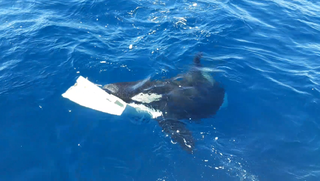
— 11 ways orcas show their terrifying intelligence
— How often do orcas attack humans?
— How orcas gained their 'killer' reputation
So far, at least 15 individuals have been linked to at least one attack in the region. But researchers believe the attacks can be traced back to a single female, named White Gladis, who may have been pregnant when she started harassing the boats. However, it is unclear exactly what sparked the attacks.
There has even been a suggestion that the behavior has spread beyond the Iberian population after an orca similarly attacked a boat in Scotland in 2023. However, this was an isolated incident, which makes it hard to link it to the Iberian attacks.

Harry is a U.K.-based senior staff writer at Live Science. He studied marine biology at the University of Exeter before training to become a journalist. He covers a wide range of topics including space exploration, planetary science, space weather, climate change, animal behavior, evolution and paleontology. His feature on the upcoming solar maximum was shortlisted in the "top scoop" category at the National Council for the Training of Journalists (NCTJ) Awards for Excellence in 2023.
Infamous boat-sinking orcas spotted hundreds of miles from where they should be, baffling scientists
Orca calf refuses to leave a lagoon where its mother stranded and died off Vancouver Island
Newfound 'glitch' in Einstein's relativity could rewrite the rules of the universe, study suggests
Most Popular
- 2 Space photo of the week: 'God's Hand' leaves astronomers scratching their heads
- 3 See stunning reconstruction of ancient Egyptian mummy that languished at an Australian high school for a century
- 4 2,500-year-old Illyrian helmet found in burial mound likely caused 'awe in the enemy'
- 5 James Webb telescope detects 1-of-a-kind atmosphere around 'Hell Planet' in distant star system
- 2 China creates its largest ever quantum computing chip — and it could be key to building the nation's own 'quantum cloud'
- 3 Atoms squished closer together than ever before, revealing seemingly impossible quantum effects
- 4 Sun launches strongest solar flare of current cycle in monster X8.7-class eruption
Orcas sink sailing yacht in Strait of Gibraltar
An unknown number of orcas have sunk a sailing yacht after ramming it in Moroccan waters in the Strait of Gibraltar, Spain’s maritime rescue service said on Monday, a new attack in what has become a trend in the past four years.
The vessel Alboran Cognac, which measured 15 metres (49 feet) in length and carried two people, encountered the highly social apex predators, also known as killer whales, at 9 a.m. local time (0700 GMT) on Sunday, the service said.
The passengers reported feeling sudden blows to the hull and rudder before water started seeping into the ship. After alerting the rescue services, a nearby oil tanker took them onboard and transported them to Gibraltar.
The yacht was left adrift and eventually sank.
The incident is the latest example of recurring orca rammings around the Gibraltar Strait that separates Europe from Africa and off the Atlantic coast of Portugal and northwestern Spain.
Experts believe them to involve a subpopulation of about 15 individuals given the designation “Gladis.”
According to the research group GTOA, which tracks populations of the Iberian orca sub-species, there have been nearly 700 interactions since orca attacks on ships in the region were first reported in May 2020.
Researchers are unsure about the causes for the behaviour, with leading theories including it being a playful manifestation of the mammals’ curiosity, a social fad or the intentional targeting of what they perceive as competitors for their favourite prey, the local bluefin tuna.
Although known as killer whales, endangered orcas are part of the dolphin family. They can measure up to eight metres and weigh up to six tonnes as adults.
Watch CBS News
Killer whales attack and sink sailing yacht in the Strait of Gibraltar — again
By Emily Mae Czachor
Updated on: May 14, 2024 / 4:54 PM EDT / CBS News
A sailing yacht sunk in the Strait of Gibraltar on Sunday after an unknown number of orcas slammed into the vessel with two people on board and caused a water leak, officials said. Both crew members were rescued by a passing oil tanker, said Spain's maritime rescue service, marking the latest killer whale attack on a boat in what has become a pattern in recent years.
The incident happened at around 9 a.m. local time in the narrow strait between Spain and Morocco that has become a notorious site of human interactions with pods of killer whales that, for reasons still not fully understood, ram into boats and at times even sink them . In this case, crew members on board the SV Alboran Cognac yacht put out an emergency call for an evacuation after they encountered orcas roughly 14 miles off the coast of Cape Spartel.
The crew members reported feeling blows to the hull of the vessel and rudder, which was damaged by the whales, the rescue service said. The agency's coordination center in Tarifa, on the Spanish side of the Strait of Gibraltar, helped arrange for their evacuation via the tanker MT Lascaux. The tanker was able to collect the crew members from the sinking yacht within the hour, and they disembarked in Gibraltar before 10:30 a.m. They abandoned the SV Alboran Cognac, which proceeded to completely disappear into the ocean.
Anyone sailing through waters from the Gulf of Cádiz in southern Spain and the Strait of Gibraltar, either in a larger motorized vessel or a personal sailing boat, is advised to avoid certain areas that the maritime rescue service marks as potentially dangerous spots for orca interactions. The greatest threats exist between May and August, when officials say that pods of killer whales are most commonly seen in those parts of the Atlantic.

But previously recorded incidents suggest those dangers may be present at any time. Last October, a Polish boat touring company reported that a pod of orcas had managed to sink one of its yachts after repeatedly slamming into the steering fin for 45 minutes, causing it to leak. Last June, two sailing teams competing in an international race around the world reported frightening scenarios in which multiple orcas rammed into or pushed up against their boats or as they sailed west of Gibraltar.
No one on board any of the vessels was hurt in those encounters, but the documented rise in confrontational behavior has researchers and sailors trying to determine why orcase have attempted to sink or capsize so many boats off the coasts of Spain and Portugal.
Some sailors have even resorted to blasting thrash metal music in a bid to deter the apex predators.
Reports of orcas interacting with humans have more than tripled in the last two years or so, according to the research group GTOA, which has documented hundreds of such incidents in the region since 2020. But some of the latest data points to possible changes in the orcas' etiquette, with the group reporting only 26 interactions in the Strait of Gibraltar and Bay of Biscay areas between January and May of this year. That number is 65% lower than the number of interactions recorded in the region over the same months last year, and 40% lower than the average number of interactions recorded in the same months between 2021 and 2023, according to GTOA.
- Boat Accident
Emily Mae Czachor is a reporter and news editor at CBSNews.com. She covers breaking news, often focusing on crime and extreme weather. Emily Mae has previously written for outlets including the Los Angeles Times, BuzzFeed and Newsweek.
More from CBS News

Boat seized in investigation into death of Ella Adler

Family, friends mourn loss of Ella Adler, teen girl killed while water skiing in Key Biscayne
Authorities identify boat operator in death of ella adler.

Teen girl killed while water skiing in Key Biscayne identified as Ella Adler
Orcas sink another yacht off the Strait of Gibraltar
Orcas have been sinking human vessels for the last four years, with the new incident occurring in moroccan waters, by matthew rozsa.
A pod of orcas sunk yet another boat, according to a recent report , this time a sailing yacht within Moroccan waters in the Strait of Gibraltar. Two people riding a 49-foot vessel known as Alboran Cognac were attacked by an unknown number of the cetaceans around 9 AM local time on Sunday.
It's the latest in a series of dozens of such incidents, including a yacht that was sunk last November after orcas, also known as killer whales, rammed the yacht's rudder. Although some scientists speculate the animals may be displaying "playful" and "copycat" behavior, the experience was certainly not enjoyable for the two humans from the recent incident, who reported feeling strikes to their hulls and rudders before water began leaking into the vessel. They were rescued by a nearby oil tanker that transported them to Gibraltar while their yacht was left to sink.
One popular theory for the attacks is that they were perpetrated by Gladis, a pod of about 15 orcas named after a killer whale (White Gladis) supposedly rammed to death by a boat. Gladis and other orca subpopulations have been documented targeting boats off the Atlantic coast of Portugal and north-western Spain since May 2020, and experts believe Gladdis may be behind this attack as well.
Although it is tempting to attribute the orcas' activities to revenge for climate change, underwater noise caused by ships or some conspiracy, animal behavior experts say that orcas possess complex cultures and enjoy sharing rituals with each other. If the orcas wanted to harm the humans on these boats, they could easily do so, but instead the behaviors involve interfering with the vessel's operations seemingly out of curiosity, or perhaps for enjoyment.
"This is a kind of cultural revolution," Lance Barrett-Lennard, PhD, senior research scientist at the Raincoast Conservation Foundation , told Salon in June . "In the short timespan, sometimes this kind of behavior, if it's directly related to food or some survival value, it may very well fade away fairly quickly. We'll see whether that happens or not."
about orcas and whales
- An expert explains why killer whales keep attacking boats
- For the first time, an orca was seen raising another whale species' young
- Dolphin ancestors had super weird teeth: A new study on the 'grandparents of modern dolphins'
Orcas sink sailing yacht in Strait of Gibraltar
- Medium Text
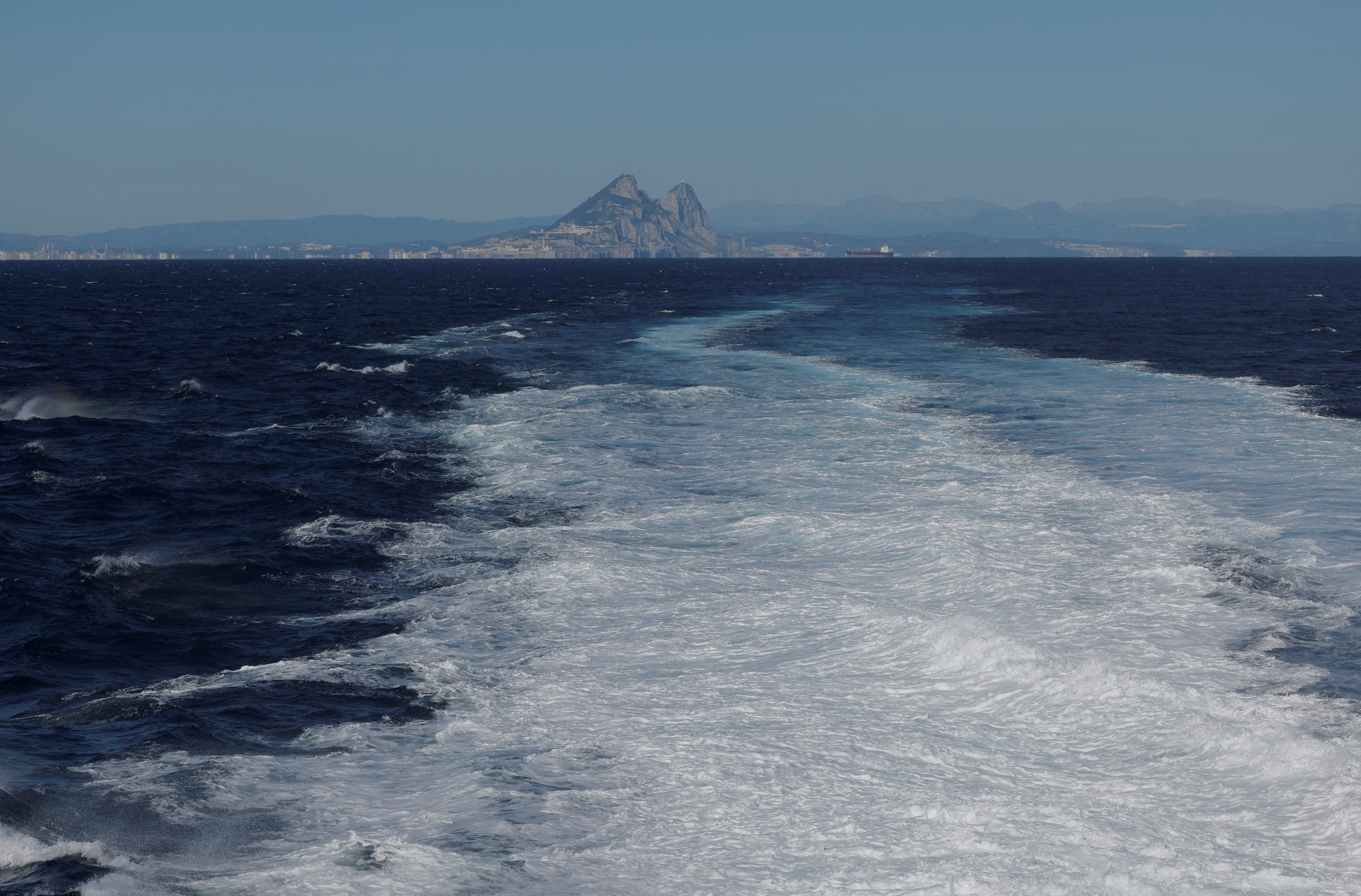
Sign up here.
Reporting by David Latona; Editing by Josie Kao
Our Standards: The Thomson Reuters Trust Principles. New Tab , opens new tab
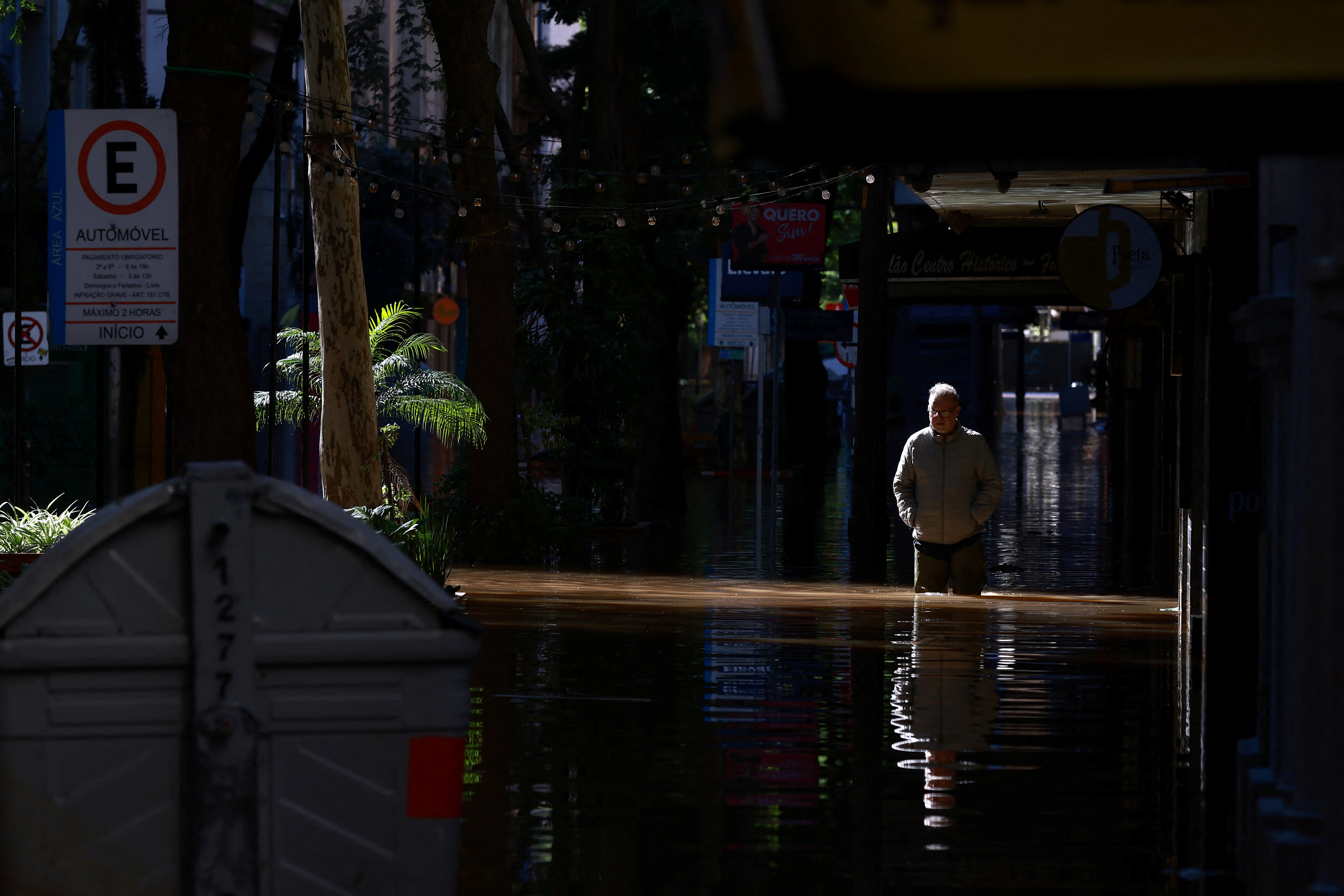
World Chevron

Police called in as protesters take building at University of California, Irvine
Pro-Palestinian protesters occupied a building at the University of California, Irvine, on Wednesday, leading university officials to call in multiple police agencies, cancel classes and advise people on campus to shelter in place, a university spokesperson said.


IMAGES
VIDEO
COMMENTS
The Sailing Yacht A, initially known as Project 787 'White Pearl,' was delivered by Nobiskrug to her owner, Andrey Melnichenko, in 2017. As the world's largest sailing yacht, she measures an impressive 143 meters (469 ft) in length with a beam of 25 meters (82 ft). Featuring eight decks, SY A can accommodate 20 guests and a crew of 20.
The vessel features an underwater observation pod in the keel with 30 cm (12 in)-thick glass. It is the largest private sail-assisted motor yacht in the world. Sailing Yacht A was delivered by Nobiskrug on 3 February 2017, and left Kiel on 5 February 2017. It exited the ...
SAILING YACHT A - World's Biggest Sailing Yacht - $600 Million. SAILING YACHT A measures 143 meters making her the world's biggest sailing yacht. SAILING YACHT A is far more than a luxury vessel. She is a masterpiece of design and innovation combining sleek metal surfaces with futuristic naval architecture that took over two years to ...
The entire boat has a listed height of 328 feet. That makes the A taller than the Tower of London or Big Ben. The vessel is just over 81 feet wide and has a gross tonnage of 12,558 gt. The sails measure an incredible 3,747 square meters or 40,332 square feet. The sails can be controlled with an in-boom furling system.
MarineTraffic Live Ships Map. Discover information and vessel positions for vessels around the world. Search the MarineTraffic ships database of more than 550000 active and decommissioned vessels. Search for popular ships globally. Find locations of ports and ships using the near Real Time ships map. View vessel details and ship photos.
The sailing yacht was too large to anchor in the nearby marina, which has a maximum capacity of 121.9 metres. ... Before she hit the water, the hull of Koru was loaded onto a transport vessel and she made the journey through the Dutch canals for further construction work. The yacht was captured against the backdrop of the quaint Dutch ...
The list of the top ten largest sailing yachts in the world is not easily disrupted. In fact, it had remained unchanged since the launch of the 106.7-metre Oceanco Black Pearl in 2018, which swiped the top spot from Lürssen's 93-metre Eos.For four years, Black Pearl remained the largest yacht in the world until early in 2023 when Oceanco sent a new flagship down the slipway, the mighty 127 ...
Catamaran sailing vessels for sale on YachtWorld are listed for a range of prices from $56,065 on the relatively moderate end all the way up to $6,777,241 for the most unique, one-of-a-kind yachts.
A sailing yacht (US ship prefixes SY or S/Y), is a leisure craft that uses sails as its primary means of propulsion. A yacht may be a sail or power vessel used for pleasure, cruising, or racing. [1] [2] [3] There is no standard definition, so the term applies here to sailing vessels that have a cabin with amenities that accommodate overnight ...
A sailing ship is a sea-going vessel that uses sails mounted on masts to harness the power of wind and propel the vessel. There is a variety of sail plans that propel sailing ships, employing square-rigged or fore-and-aft sails. Some ships carry square sails on each mast—the brig and full-rigged ship, said to be "ship-rigged" when there are ...
The cutter is a smaller sailing ship built in the early 18th century with a single mast rigged fore and aft and it varied in size from 20ft to 34 ft in length on average with a crew capacity of between 21 to 66 people . A cutter sailing vessel features: Narrow hull; 1 mast; 2 or more headsails; Decked sailcraft; Raking transom
Fraser offers the world's largest fleet of sailing yachts for sale in excess of US$30 million. Additionally, thanks to Fraser's strong relationship with sailing yacht owners and shipyards, we have access to thousands more sailing yachts for sale that are not publicly advertised.. Browse our portfolio of luxury sailing yachts for sale today, or contact the team of yacht sales brokers at ...
A sailboat refers to any class and subclass of boat that is designed with one or more masts and rigging system as the main source of propulsion. Sailboats are available in a variety of models and rigs, including racing boats, sloops, schooners, catamarans, trimarans, sailing cruisers, and others. Some of the first sailboats on record date back ...
Here, we take a look at some of the standout sailing yachts for sale with BOAT International, including sailing yachts from legendary names such as Royal Huisman, Perini Navi, Nautor's Swan and Jongert. Discover the finest luxury sailing yachts for sale worldwide with BOAT International, featuring sailing superyachts from the world's best builders.
Sailing provides an escape for many people who are tired of a digitized, impersonal world. It is a way to connect back with nature and our own past. Modern Era Sailing. The 'age of sail' was from 1571 to 1862, when the majority of all ships were masted vessels. In the last several hundred years, ship sailing has taken on a more recreational aspect.
The world's finest bluewater yachts. Oyster is a thoroughbred British luxury sailing yachts builder. We have designed, built and supported the world's finest liveaboard sailboats since 1973. The DNA of our 50ft to 90ft ocean cruising yachts is rooted in over 20 million bluewater sailing miles and more than 100 sailing circumnavigations.
Gaff ketch - two-masted (mizzen), two mainsails, staysails, fore-and-aft rigged. Full-rigged ship or tall ship - three or more masts, mainsail on each mast, staysails, square-rigged. The first word is the shape and rigging of the mainsail. So this is the way the sail is attached to the mast.
Tall Ships are large, traditionally rigged sailing vessels with multiple masts, typically square-rigged on at least one of their masts. Some examples of these ships include the clipper, brig, and square-rigged vessels. The clipper is a fast sailing ship known for its sleek hull and large sail area, while the brig features two square-rigged ...
Among small islands and sheltered bays, flexible sailing vessels like the SEA CLOUDs have an advantage, because they can always get that little bit closer. ... The SEA CLOUD II perfectly combines spaciousness for up to 94 passengers with the lifestyle of a private yacht. To the ship . 360° Tour . Video. Position.
Black Pearl is one of the largest and most ecological sailing yachts in the world. She can cross the Atlantic without burning even a liter of fossil fuel. This is thanks in part to her DynaRig sailing system and an innovative propulsion system that harvests kinetic energy under sail. 1 3. Previous.
Le Ponant. Le Ponant, the company's iconic three-master and the first sailing ship in the world to be awarded the Relais & Châteaux label in 2023, symbolises our commitment to a more sustainable form of travel. Up to 32 Guests. 16 staterooms & suites. 33 crew members.
An unknown number of orcas have sunk a sailing yacht after ramming it in Moroccan waters in the Strait of Gibraltar, ... The vessel Alboran Cognac, which measured 15 meters (49 feet) in length and ...
A Windmill sailing dinghy. The following is a partial list of sailboat types and sailing classes, including keelboats, dinghies and multihull (catamarans and trimarans). ... (International Yacht Racing Union), the organization evolved into the ISAF (International Sailing Federation) in 1996, and as of December 2015 is now World Sailing.
Performance. At all wind conditions Marama is a very fast sailboat, which provides fantastic gliding sensations and makes the crossings much more enjoyable. Taking the helm of Marama is an unforgettable experience. MARAMA, 101 feet sailing yacht, the perfect expedition boat to sail to Antarctica, South Georgia and for the Northwest Passage.
Last modified on Mon 13 May 2024 14.33 EDT. An unknown number of orcas have sunk a yacht after ramming it in Moroccan waters in the Strait of Gibraltar, Spain's maritime rescue service has said ...
A group of orcas known to attack boats in southwest Europe have sunk a 50-foot sailing yacht in the Strait of Gibraltar after ripping open its hull. ... ranging from circling and nudging vessels ...
By Reuters. An unknown number of orcas have sunk a sailing yacht after ramming it in Moroccan waters in the Strait of Gibraltar, Spain's maritime rescue service said on Monday, a new attack in ...
A sailing yacht sunk in the Strait of Gibraltar on Sunday after an unknown number of orcas — also known as killer whales — slammed into the vessel with two people on board and caused a water ...
A pod of orcas sunk yet another boat, according to a recent report, this time a sailing yacht within Moroccan waters in the Strait of Gibraltar.Two people riding a 49-foot vessel known as Alboran ...
The vessel Alboran Cognac, which measured 15 metres (49 feet) in length and carried two people, encountered the highly social apex predators, also known as killer whales, at 9 a.m. local time ...